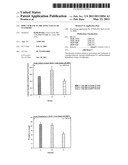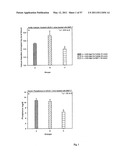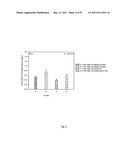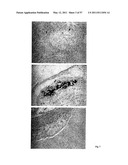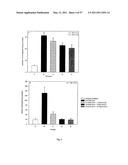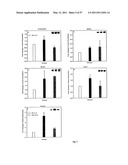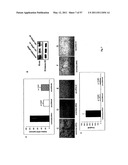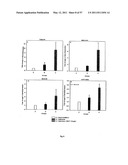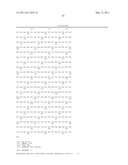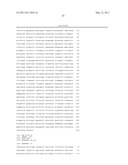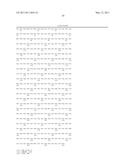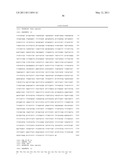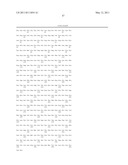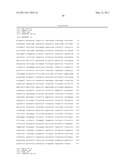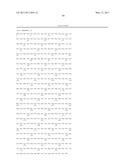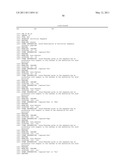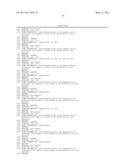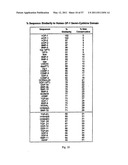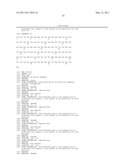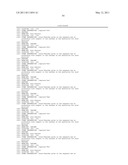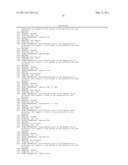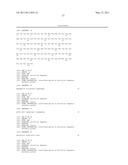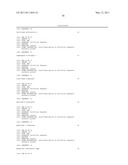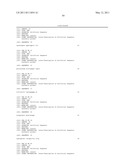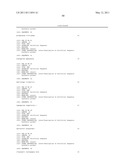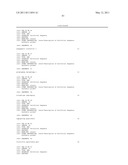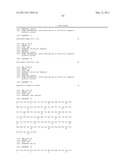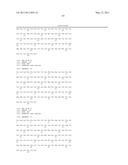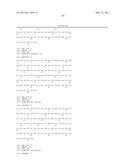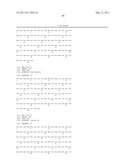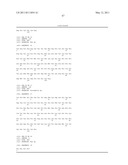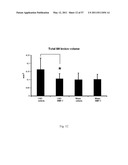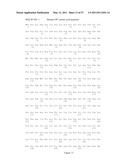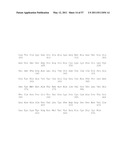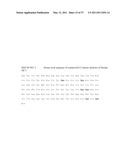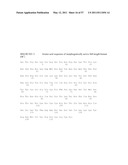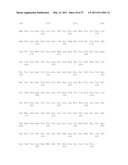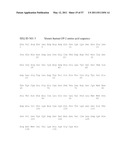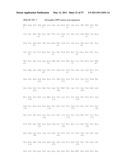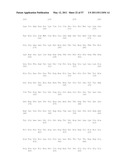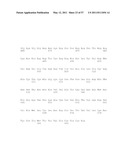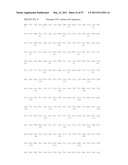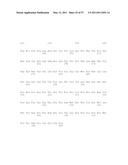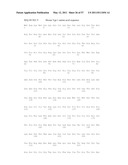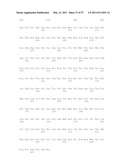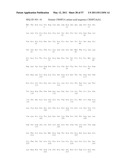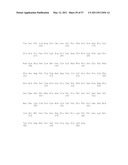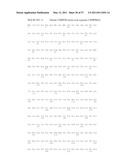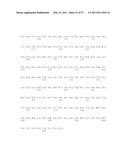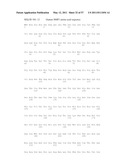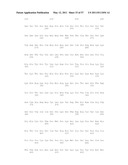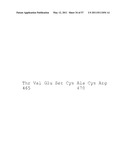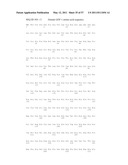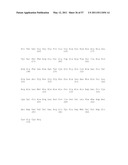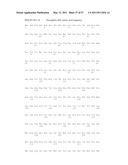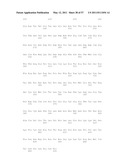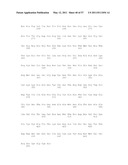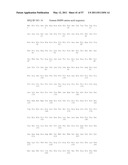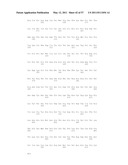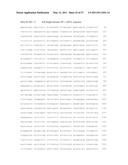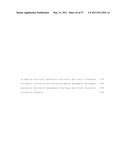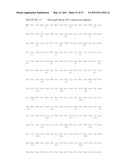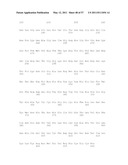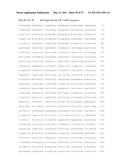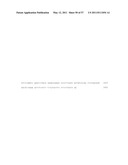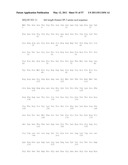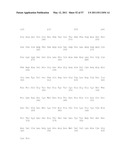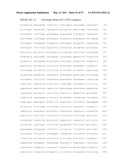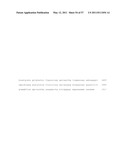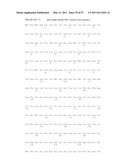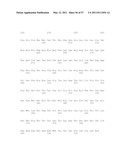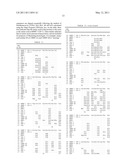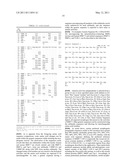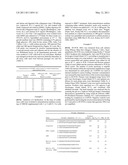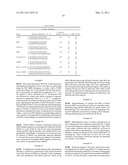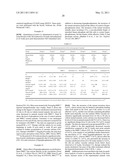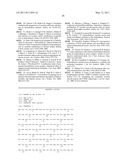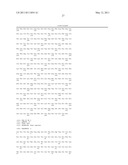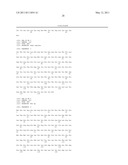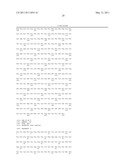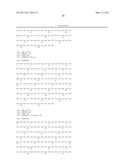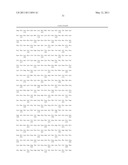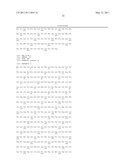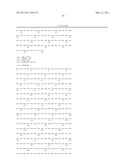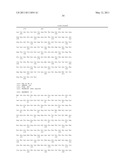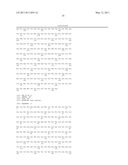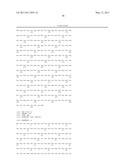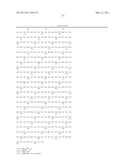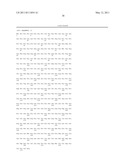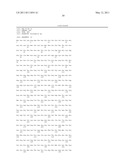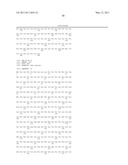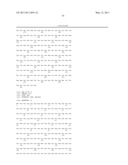Patent application title: BMP-7 FOR USE IN TREATING VASCULAR SCLEROSIS
Inventors:
Keith Hruska (Creve Coeur, MO, US)
Eric T. Choi (St. Louis, MO, US)
IPC8 Class: AA61K3324FI
USPC Class:
424617
Class name: Drug, bio-affecting and body treating compositions inorganic active ingredient containing heavy metal or compound thereof
Publication date: 2011-05-12
Patent application number: 20110111054
Claims:
1.-47. (canceled)
48. A method of treating or preventing vascular sclerosis in a subject comprising the step of administering to said subject: a) a morphogen selected from the group consisting of BMP-7, BMP-5, BMP-6, OP-2 (BMP-8) and variants thereof; or b) an antagonist of a mineralizing BMP.
49. The method of claim 48, wherein the morphogen is BMP-7.
50. The method of claim 48, wherein the mineralizing BMP is BMP-2 or BMP-4, or an analog thereof.
51. The method of claim 48, wherein the mineralizing BMP antagonist is noggin.
52. The method of claim 48, wherein the vascular sclerosis is induced by chronic kidney disease.
53. A method of treating, preventing or reducing neointimal hyperplasia in a subject comprising the step of administering to said subject: a) a morphogen selected from the group consisting of BMP-7, BMP-5, BMP-6, OP-2 (BMP-8) and variants thereof; or b) an antagonist of a mineralizing BMP.
54. The method of claim 53, wherein the morphogen is BMP-7.
55. The method of claim 53, wherein the mineralizing BMP is BMP-2 or BMP-4, or an analog thereof.
56. The method of claim 53, wherein the mineralizing BMP antagonist is noggin.
57. The method of claim 53, wherein the neointimal hyperplasia is associated with anastomosis.
58. The method of claim 53, wherein the neointimal hyperplasia is induced by chronic kidney disease.
59. A method of inducing vascular smooth muscle cell differentiation comprising the step of contacting a vascular smooth muscle progenitor cell or an undifferentiated or dedifferentiated vascular smooth muscle cell with: a) a morphogen selected from the group consisting of BMP-7, BMP-5, BMP-6, OP-2 (BMP-8) and variants thereof; or b) an antagonist of a mineralizing BMP.
60. The method of claim 59, wherein the morphogen is BMP-7.
61. The method of claim 59, wherein the mineralizing BMP is BMP-2 or BMP-4, or an analog thereof.
62. The method of claim 59, wherein the mineralizing BMP antagonist is noggin.
63. A method of preventing initial or further mineralization of blood vessels by inhibiting mineralizing bone morphogenetic protein (BMP) activities in the presence of phosphorus, by contacting muscle cells with an antagonist of mineralizing BMP, thereby inhibiting mineralization.
64. The method of claim 63, wherein the muscle cells are vascular smooth muscle cells.
65. The method of claim 63, wherein the mineralizing BMP is BMP-2 or BMP-4, or an analog thereof.
66. The method of claim 63, wherein the mineralizing BMP antagonist is noggin.
67. The method of claim 63, wherein the mineralizing BMP antagonist is a mineralization-countering BMP.
68. The method of claim 67, wherein the mineralization countering BMP is BMP-7.
69. A method of preventing initial or further mineralization of blood vessels in the presence of phosphorus by reducing osterix activities, thereby inhibiting mineralization.
70. The method of claim 69, wherein osterix activities are reduced by reducing the expression of osterix.
71. The method of claim 70, wherein the expression of osterix is reduced by reducing osterix mRNA transcription.
72. The method of claim 70, wherein the expression of osterix is reduced by reducing osterix protein translation.
73. The method of claim 69, wherein, osterix activities are reduced by inhibiting the activities of osterix protein directly.
74. A method of treating mineralization of blood vessels by inhibiting mineralizing bone morphogenetic protein (BMP) activities in a subject in need thereof by administering to said subject an antagonist of the mineralizing BMP.
75. The method of claim 74, wherein the mineralizing BMP is BMP-2 or BMP-4, or an analog thereof.
76. The method of claim 74, wherein the mineralizing BMP antagonist is noggin.
77. The method of claim 74, wherein the mineralizing BMP antagonist is a mineralization-countering BMP.
78. The method of claim 77, wherein the mineralization countering BMP is BMP-7.
79. A method for treating hyperphosphatemia comprising the step of administering BMP-7 to a subject in need thereof.
80. A pharmaceutical composition comprising: a) a morphogen selected from the group consisting of BMP-7, BMP-5, BMP-6, OP-2 (BMP-8) and variants thereof; or b) an antagonist of a mineralizing BMP; for i) treating or preventing vascular sclerosis, or ii) treating, preventing or reducing neointimal hyperplasia, in a subject.
81. The pharmaceutical composition of claim 80, wherein the vascular sclerosis is induced by chronic kidney disease.
82. The pharmaceutical composition of claim 80, wherein the neointimal hyperplasia is associated with anastomosis.
83. The pharmaceutical composition of claim 80, wherein the neointimal hyperplasia is induced by chronic kidney disease.
84. A pharmaceutical composition comprising: a) a morphogen selected from the group consisting of BMP-7, BMP-5, BMP-6, OP-2 (BMP-8) and variants thereof; or b) an antagonist of a mineralizing BMP; for inducing differentiation of a vascular smooth muscle progenitor cell or an undifferentiated or dedifferentiated vascular smooth muscle cell.
85. The pharmaceutical composition of claim 80 or 84, wherein the morphogen is BMP-7.
86. The pharmaceutical composition of claim 80 or 84, wherein the mineralizing BMP is BMP-2 or BMP-4, or an analog thereof.
87. The pharmaceutical composition of claim 80 or 84, wherein the mineralizing BMP antagonist is noggin.
88. A pharmaceutical composition comprising: a) a phosphorus binding agent; b) an antagonist of mineralizing BMP; c) BMP-7; or d) any combination thereof; for the treatment of vascular calcification.
89. The pharmaceutical composition of claim 88, wherein the phosphorus-binding agent is LaCO.sub.3.
Description:
FIELD OF THE INVENTION
[0002] The present invention relates to prevention and treatment of vascular sclerosis, neointimal hyperplasia and vascular calcification (VC).
BACKGROUND OF THE INVENTION
[0003] Chronic kidney disease (CKD) is a fatal illness, and cardiovascular complications (including arteriovenous (AV) access failure due to venous neointimal hyperplasia (NH) lesions) are the major causes of morbidity and mortality. (Go, A. S. et al., New Engl. J. Med. 351:1296-1305, 2004; Berl, T. and Henrich, W., Clin. J. Am. Soc. Nephrol. 1:8-18, 2006)1;2 The causes of the excess cardiovascular mortality associated with CKD are unknown, since the role of the standard risk factors associated with cardiovascular mortality do not account for the increased risk in CKD (Berl, ibid.).
[0004] While AV fistulae constructed with native vessels are the best vascular access available, owing to a lower incidence of stenosis, thrombosis and infection compared with vascular grafts or central venous catheters, even after maturation, the failure rate of 66% at 2 years still remains unacceptable (Shenoy S, et al., J Vasc Surg. 2003; 38(2):229-235.)54 and hemodialysis access related hospitalizations continue to cost well over 1 billion dollars per annum in the United States (Lee H, et al., Am J Kidney Dis. 2002; 40(3):611-622).55
[0005] The cause of AV access failure is predominantly secondary to the occlusive neointimal hyperplastic lesion formation at the anastomosis and/or the outflow veins followed by in situ thrombosis (Mattana J, et al., Kidney Int. 1997; 52(6):1478-1485; Ezzahiri R, et al., Nephrol Dial Transplant. 1999; 14(9):2110-2115; Cinat M E, et al., Ann Vasc Surg. 1999; 13(2):191-198; Tordoir J H, et al., Eur J Vasc Endovasc Surg. 1995; 9(3):305-309).56-59 Unlike restenosis seen with preocclusive atherosclerotic arteries after angioplasty and stenting, neointimal (new intimal) hyperplasia (NH) is seen at the anastomosis involving an artery or a synthetic graft (e.g., ePTFE, Dacron) and a vein in the extremities. Although these blood vessels are usually free of atherosclerotic plaque, they are predisposed to calcification, pre-existing NH and needle stick injuries. Therefore, directional migration of smooth muscle cells (SMCs) into the venous luminal surface is critical to peri-anastomotic NH lesion formation (Roy-Chaudhury P, et al., J Am Soc Nephrol. 2006; 17(4):1112-1127; Nikkari S T, et al., Ann Med. 1994; 26(2):95-100).60,61
[0006] CKD has been implicated in the development of atherosclerosis along with a host of other deranged factors such as hemodynamic forces, inflammatory mediators, platelet activation, coagulation cascade and metabolic factors. Further, there is strong epidemiologic evidence that serum phosphorus is an independent risk factor for cardiovascular events and mortality in CKD (Kestenbaum, B. et al., J. Am. Soc. Nephrol. 16:520-528, 2005; Slinin, Y. et al., J. Am. Soc. Nephrol. 16:1788-1793, 2005).3;4 Serum phosphorus has been linked to another cardiovascular risk factor, vascular calcification (VC) (Kestenbaum et al. 2005; London, G. M. et al., Nephrol. Dial. Transplant. 18:1731-1740, 2003; Raggi, P. et al., J. Am. Coll. Cardiol. 39:695-701, 2002)3;5;6, an important cause of vascular stiffness in CKD. Vascular stiffness from various causes including CKD, atherosclerosis, metabolic diseases, and diabetes, is a major cardiovascular risk factor, leading to increased pulse wave velocity, increased cardiac work, left ventricular hypertrophy, and decreased coronary artery blood flow. (Raggi 2002; Zile, M. R. et al., New Engl. J. Med. 350:1953-1959, 2004; Ohtake, T. et al., J. Am. Soc. Nephrol. 16:1141-1148, 2005).6-8 Phosphorus has been further implicated as a cause of VC through studies in vitro which have demonstrated that it induces phenotypic changes in vascular smooth muscle cells by increasing gene transcription of proteins involved in osteoblast function-bone formation (Tyson, K. L. et al., Arterioscler. Thromb. Vasc. Biol. 23:489-494, 2003)9 and stimulating matrix mineralization (Steitz, S. A. et al., Circ. Res. 89:1147-1154, 2001; Jono, S. et al., Cir. Res. 87:e10-e17, 2000; Reynolds, J. L. et al., J. Am. Soc. Nephrol. 15:2857-2867, 2004)10-12. In the uremic calcifying environment, expression of the contractile proteins of vascular smooth muscle cells, such as α-smooth muscle actin, SM22, and heavy chain myosin, are suppressed (Trion, A. and van der Laarse, A., Am. Heart J. 147:808-814, 2004),13 while osteoblastic lineage markers such as osteocalcin, osteopontin, and the bone morphogenetic proteins 2 and 4 are increased (Tyson 2003; Moe, S. M. et al., Kidney Int'l 61:638-647, 2002; Bostrom, K. et al., J Clin. Invest. 91:1800-1809, 1993; Dhore, C. R. et al., Arterioscler. Thromb. Vasc. Biol. 21:1998-2003, 2001).9;14-16 Furthermore, the osteoblast specific transcription factor RUNX2, which directs skeletal bone formation (Ducy, P. et al., Cell 89:747-754, 1997),17 is expressed in the vasculature of subjects with end stage CKD (ESKD) (Tyson 2003; Moe, S. M. et al., Kidney Int'l 63:1003-1011, 2003).9;18
[0007] An animal model of CKD-stimulated VC in the atherosclerotic low density lipoprotein receptor-deficient mouse fed high dietary fat has recently been identified (Davies, M. R. et al., J. Am. Soc. Nephrol. 14:1559-1567, 2003).19 The CKD in this model is associated with hyperphosphatemia. It has been demonstrated that the hyperphosphatemia is a direct cause of VC in CKD (Davies, M. R. et al., J. Am. Soc. Neph. 16:917-928, 2005).20 This was the first demonstration in vivo that hyperphosphatemia is causative of a cardiovascular complication of the disease. Furthermore, it has been demonstrated that the skeleton in CKD is a significant contributor of phosphorus to hyperphosphatemia, (Davies 2005; Lund, R, J, et al., J. Am. Soc. Nephrol. 15:359-369, 2004)20;21 along with intestinal absorption of ingested phosphorus and diminished renal excretion. This establishes a direct link between skeletal remodeling and VC in CKD through the serum phosphorus. The mechanism of phosphorus action at the level of the vasculature remains to be demonstrated despite recent progress suggesting direct actions of the ion (Jono 2000; Li, X. et al., Circ. Res. 98:905-912, 2006). 11,22
SUMMARY OF THE INVENTION
[0008] The instant invention relates to compositions and methods for treating or preventing vascular sclerosis. In one aspect of the invention the vascular sclerosis accompanies or is induced by CKD. The instant invention also relates to compositions and methods for inducing differentiation of vascular smooth muscle cells.
[0009] One aspect of the invention is to treat or prevent vascular sclerosis. In some embodiments, the invention provides a method of treating or preventing vascular sclerosis in a subject comprising the step of administering to said subject a morphogen selected from BMP-7, BMP-5, BMP-6, OP-2 (BMP-8) and variants thereof. In a preferred embodiment, the morphogen is BMP-7. In other embodiments, the invention provides a method of treating or preventing vascular sclerosis in a subject comprising the step of administering to said subject an antagonist of a mineralizing BMP. In certain embodiments, the mineralizing BMP is BMP-2 or BMP-4, or an analog thereof. In some embodiments, the vascular sclerosis is induced by chronic kidney disease.
[0010] Another aspect of the invention is to treat, prevent or reduce neointimal hyperplasia. In some embodiments, the invention provides a method of treating, preventing or reducing neointimal hyperplasia in a subject comprising the step of administering to said subject a morphogen selected from BMP-7, BMP-5, BMP-6, OP-2 (BMP-8) and variants thereof. In a preferred embodiment, the morphogen is BMP-7. In other embodiments, the invention provides a method of treating, preventing or reducing neointimal hyperplasia in a subject comprising the step of administering to said subject an antagonist of a mineralizing BMP. In certain embodiments, the mineralizing BMP is BMP-2 or BMP-4, or an analog thereof. In some embodiments, the neointimal hyperplasia is associated with anastomosis. In some embodiments, the neointimal hyperplasia is induced by chronic kidney disease.
[0011] Another aspect of the invention is to induce vascular smooth muscle differentiation. In some embodiments, the invention provides a method of inducing vascular smooth muscle cell differentiation comprising the step of contacting a vascular smooth muscle progenitor cell or an undifferentiated or dedifferentiated vascular smooth muscle cell, with a morphogen selected from BMP-7, BMP-5, BMP-6, OP-2 (BMP-8) and variants thereof. In a preferred embodiment, the morphogen is BMP-7. In other embodiments, the invention provides a method of inducing vascular smooth muscle cell differentiation comprising the step of contacting a vascular smooth muscle progenitor cell or an undifferentiated or dedifferentiated vascular smooth muscle cell with an antagonist of a mineralizing BMP. In certain embodiments, the mineralizing BMP is BMP-2 or BMP-4, or an analog thereof.
[0012] The instant invention further relates to preventing and decreasing established vascular sclerosis caused by calcification of blood vessels. The mechanism of a representative method for decreasing calcification is by controlling hyperphosphatemia and related phosphorus metabolism. CKD stimulates VC in part through increasing atherosclerotic calcification. Secondly, atherosclerotic calcification is due to heterotopic expression of osteoblastic differentiation and function in the vasculature. Third, hyperphosphatemia is a cardiovascular risk factor in CKD through stimulation of vascular calcification. The mechanism of phosphorus-mediated induction of vascular calcification is through its stimulation of osterix in the vascular neointima and tunica media in CKD. Phosphorus stimulated activity of osterix permitted a BMP-2/MSX2 directed program to be completed and mineralization to be stimulated.
[0013] One aspect of the invention is to prevent mineralization or to stop further mineralization and/or calcification of blood vessels by inhibiting mineralizing bone morphogenetic protein (BMP) activities. One embodiment of the invention is a method of preventing initial or further mineralization/calcification of blood vessels in the presence of phosphorus, by contacting muscle cells with an antagonist of mineralizing BMP, i.e. mineralization-countering BMP, thereby inhibiting mineralizing BMP activities. In a particular embodiment, the muscle cells are vascular smooth muscle cells. In particular embodiments, the mineralizing BMP is BMP-2 or BMP-4, or an analog thereof. In further particular embodiments, the muscle cells are aortic cells. In one embodiment, the antagonist of mineralizing BMP is noggin. In another embodiment, the antagonist of a mineralizing BMP is another BMP, such as BMP-7, or an analog thereof.
[0014] Another embodiment of the invention is a method of preventing initial or further calcification of blood vessels in the presence of phosphorus by reducing osterix activities. In certain embodiments, osterix activities are reduced by reducing the expression of osterix. In particular embodiments, the expression of osterix is reduced by reducing osterix mRNA transcription. In other embodiments, the expression of osterix is inhibited by inhibiting osterix protein translation. In other particular embodiments, osterix activities are reduced by inhibiting the activities of osterix protein directly.
[0015] Another aspect of the invention is methods of treating calcification of blood vessels by inhibiting mineralizing bone morphogenetic protein (BMP) activities. One embodiment of the invention is a method of treating established vascular mineralization by administering an antagonist of mineralizing BMP, thereby inhibiting mineralizing BMP activities. A preferred embodiment of the invention is such method of treating vascular sclerosis induced by CKD, wherein phosphorus levels in the serum are elevated. In a particular embodiment, an antagonist of mineralizing BMP activities is BMP-7 or an analog thereof.
[0016] Another aspect of the invention is a pharmaceutical composition comprising a morphogen selected from BMP-7, BMP-5, BMP-6, OP-2 (BMP-8) and variants thereof for treating or preventing vascular sclerosis in a subject. In a preferred embodiment, the morphogen is BMP-7. Another aspect of the invention is a pharmaceutical composition comprising an antagonist of a mineralizing BMP for treating or preventing vascular sclerosis in a subject. In some embodiments, the mineralizing BMP is BMP-2 or BMP-4. In some embodiments, the vascular sclerosis is induced by chronic kidney disease.
[0017] Another aspect of the invention is a pharmaceutical composition comprising a morphogen selected from BMP-7, BMP-5, BMP-6, OP-2 (BMP-8) and variants thereof for treating, preventing or reducing neointimal hyperplasia in a subject. In a preferred embodiment, the morphogen is BMP-7. Another aspect of the invention is a pharmaceutical composition comprising an antagonist of a mineralizing BMP for treating, preventing or reducing neointimal hyperplasia in a subject. In some embodiments, the mineralizing BMP is BMP-2 or BMP-4. In some embodiments, the neointimal hyperplasia is associated with anastomosis. In other embodiments, the neointimal hyperplasia is induced by chronic kidney disease.
[0018] Another aspect of the invention is a pharmaceutical composition comprising a morphogen selected from BMP-7, BMP-5, BMP-6, OP-2 (BMP-8) and variants thereof for inducing differentiation of a vascular smooth muscle progenitor cell or an undifferentiated or dedifferentiated vascular smooth muscle cell. In a preferred embodiment, the morphogen is BMP-7. Another aspect of the invention is a pharmaceutical composition comprising an antagonist of a mineralizing BMP for inducing differentiation of a vascular smooth muscle progenitor cell or an undifferentiated or dedifferentiated vascular smooth muscle cell. In some embodiments, the mineralizing BMP is BMP-2 or BMP-4.
[0019] Another aspect of the invention is a pharmaceutical composition comprising a phosphorus binding agent for the treatment of hyperphosphatemia, and thus, vascular calcification. Another aspect of the invention is a pharmaceutical composition comprising a BMP inhibitor for the treatment of vascular calcification. Yet another aspect of the invention is a pharmaceutical composition comprising BMP-7 for the treatment of vascular calcification.
[0020] In any of the described aspects and embodiments of the present invention, an analog of a named BMP represents any similar BMPs having highly homologous structures, i.e., a six- or seven-cysteine skeleton which, through disulfide bonds form a distinct structure at the C-terminal portion of the polypeptide, wherein the amino acid sequence of such six- or seven-cysteine skeleton shares 70, 80, 90, or 95% similarity or identity while preserving the cysteines and wherein the biological activities may partially or wholly substitute the named BMPs.
BRIEF DESCRIPTION OF THE FIGURES
[0021] FIG. 1 shows the effects of BMP-7 on vascular calcification in CKD.
[0022] FIG. 2 shows the effects of CaCO3 and LaCO3, both 3% mixed in the diet, on vascular calcification in CKD.
[0023] FIG. 3 shows sections of the proximal aorta demonstrating large calcified atherosclerotic plaques in the LDLR-/- high fat fed mice.
[0024] FIG. 4 shows that matrix mineralization is stimulated in cultures of human vascular smooth muscle cells (hVSMC) isolated from atherosclerotic donors.
[0025] FIG. 5 shows the stimulation of a BMP-2/MSX2 directed osteoblastic differentiation program by NaH2PO4/NaHPO4 through induction of osterix.
[0026] FIG. 6 shows the effects of a bone morphogenetic protein specific inhibitor Noggin, on VSMC mineralization and gene expression.
[0027] FIG. 7 shows the effects of osterix knockdown on phosphorus stimulated mineralization by osteoblastic-like cells. SAOS cell lines expressing siRNA to osterix were developed as described in the Example 11. Panel A. The levels of mRNA to osterix were decreased by greater than 50% in two separate cell lines (osxsiRNA#1 and osxsiRNA#2). Panel B. Protein levels of osterix were greatly diminished by Western analysis in osxsiRNA #1 and osxsiRNA#2. Histone H3 levels were determined as a loading control on the Western blots. Panels C-G. Von Kossa (Panels C-E) and alizarin red (Panels F, G) stains of cultures stimulated by high phosphorus conditions. Panel C. Mineralized nodules in the periphery of wells containing cells expressing the scrambled siRNA at seven days in the high phosphorus mineralizing conditions. Panel D. Mineralized nodules in the center of wells containing cells expressing the scrambled siRNA at seven days in the high phosphorus mineralizing conditions. Panel E. Absence of mineralization detected by von Kossa staining in periphery of wells expressing osxsiRNA#1 at seven days in the high phosphorus mineralizing conditions. Panel F. Alizarin red stained nodules in the periphery of wells containing cells expressing the scrambled siRNA at seven days in the high phosphorus mineralizing conditions. Panel G. Absence of mineralization detected by alizarin red staining in periphery of wells expressing osxsiRNA#1 at seven days in the high phosphorus mineralizing conditions. The orange is the background stain in alizarin red negative stains. Panel H. Calcium levels in the matrices of cultures of cell lines expressing siRNA to osterix.
[0028] FIG. 8 shows the expression of contractile VSMC markers in hVSMC.
[0029] FIG. 9 shows expression of various calcification related genes in aortas of various groups of LDLR-/- high fat fed mice measured by real time RT-PCR.
[0030] FIG. 10 shows homologies among various bone morphogenetic proteins.
[0031] FIG. 11 is a schematic representation of the AV anastomosis. Actual picture (B) and schema (A) of mouse model of AV fistula creation with end-to-side anastomosis of end left common carotid artery to side left external jugular vein. One-hundred micron cross-sections of the venous anastomosis 3 weeks following AV fistula creation (C-F). Bar=100 μm.
[0032] FIG. 12 shows the effect of BMP-7 administration on CKD induction of anastomotic NH lesion formation.
[0033] FIG. 13 shows the sequences of various morphogens.
DETAILED DESCRIPTION OF THE INVENTION
[0034] In order that the invention herein described may be fully understood, the following detailed description is set forth.
I. DEFINITIONS
[0035] Unless defined otherwise, all technical and scientific terms used herein have the same meaning as those commonly understood by one of ordinary skill in the art to which this invention belongs. Although methods and materials similar or equivalent to those described herein can be used in the practice or testing of the present invention, suitable methods and materials are described below. The materials, methods and examples are illustrative only, and are not intended to be limiting. All publications, patents and other documents mentioned herein are incorporated by reference in their entirety.
[0036] Throughout this specification, the word "comprise" or variations such as "comprises" or "comprising" will be understood to imply the inclusion of a stated integer or groups of integers but not the exclusion of any other integer or group of integers.
[0037] OP/BMP morphogen. As used herein, the terms "OP/BMP morphogen," "BMP," "OP," "morphogen," "bone morphogenic protein," and "bone morphogenetic protein" are used interchangeably and mean a polypeptide, or a functional variant of a polypeptide, comprising at least the C-terminal six- or seven-cysteine domain of a mammalian protein selected from the group consisting of BMP-7 (OP-1), OP-2 (BMP-8), OP-3, BMP2, BMP3, BMP4, BMP5, BMP6, BMP9, and "morphogen analogs." "Morphogen analogs" are defined herein as proteins which comprises the C-terminal six- or seven-cysteine skeleton (with the cysteines forming a scaffold that preserves the spatial relationships to and among each other and with other amino acid residues) and exhibit, among the amino acids in this skeleton that are not cysteines, at least 65% or, more preferably, 70%, 75% 80%, 85%, 90%, or 95% amino acid sequence homology, or at least 50%, more preferably 55%, 60%, 70%, 80%, 90%, 99% or more identity, with the amino acid sequence of the seven-cysteine domain of a morphogen of which it is an analog. A morphogen analog may be truncated at the N-terminus compared to a full-length morphogen, or may be a corresponding protein from a different species. A morphogen analog may be artificially prepared. A morphogen analog may have post-translational modification or may have been incorporated non-amino acids, or may comprise unnatural amino acids, such as D-amino acids or polysaccharides that have substantially similar conformation as the amino acid residues that they replaced. A morphogen analog may have similar biological activities as the protein of which it is an analog. Such activities are: (a) capable of inducing chondrogenesis in the Reddi-Sampath ectopic bone assay (Sampath and Reddi 1981, Proc. Natl. Acad. Sci. (USA) 78: 7599-7603) or a substantially equivalent assay, (b) capable of significantly preventing, inhibiting, delaying or alleviating the progressive loss of renal function in a standard animal model of chronic renal failure, or (c) capable of causing a clinically significant improvement in a standard marker of renal function when administered to a mammal in, or at risk of, chronic renal failure.
[0038] As used herein, "mineralizing bone morphogenetic protein" or "mineralizing BMP" refers to a subset of OP/BMP morphogen (as defined above) that promotes osteoblast differentiation and calcification of tissues. Examples of mineralizing BMP are BMP-2 and BMP-4, and analogs of BMP-2 and BMP-4.
[0039] As used herein, "mineralization-countering BMP" means certain BMPs, such as BMP-7, that counter the activity of mineralizing BMP and therefore hampers mineralization of tissues.
[0040] As used herein, "amino acid sequence homology" or a percentage "homology" between two amino acid sequences is understood herein to include both amino acid sequence identity and conserved substitution. Thus, as used herein, a percentage "homology" between two amino acid sequences indicates the percentage of amino acid residues which are identical or are conserved substitution between the sequences. "Conservative substitutions" of amino acids fulfill the criteria defined for an "accepted point mutation" in Dayhoff et al. (1978), Atlas of Protein Sequence and Structure Vol. 5 (Suppl. 3), pp. 354-352, Natl. Biomed. Res. Found., Washington, D.C. Thus, "conservative substitutions" are residues that are physically or functionally similar to the corresponding reference residues, having similar size, shape, electric charge, and/or chemical properties such as the ability to form covalent or hydrogen bonds, or the like. Examples of preferred conservative substitutions include the substitution of one amino acid for another with similar characteristics, e.g., substitutions within the following groups: (a) Ser, Thr, Pro, Ala, Gly; (b) Asn, Asp, Glu, Gln; (c) His, Arg, Lys; (d) Met, Ile, Leu, Val; (e) Phe, Tyr, Trp. In a most preferred embodiment, conservative substitutions include the substitution of one amino acid for another within the following groups: (a) glycine, alanine; (b) valine, isoleucine, leucine; (c) aspartic acid, glutamic acid; (d) asparagine, glutamine; (e) serine, threonine; (f) lysine, arginine, histidine; and (g) phenylalanine, tyrosine. See FIG. 84 of Dayhoff et al. (1978), Atlas of Protein Sequence and Structure Vol. 5 (Suppl. 3), pp. 354-352, Natl. Biomed. Res. Found., Washington, D.C. The term "conservative substitution" or "conservative variation" also includes the use of a substituted amino acid in place of an unsubstituted parent amino acid in a given polypeptide chain, provided that the resulting substituted polypeptide chain also has therapeutic efficacy in the present invention.
[0041] As used herein, a therapeutic agent (morphogen) of the invention is said to have "therapeutic efficacy," and an amount of the agent is said to be "therapeutically effective," if administration of that amount of the agent is sufficient to cause a clinically significant improvement in a standard marker of cardiovascular health when administered to a mammalian subject (e.g., a human patient) in, or at risk of, vascular sclerosis. Such markers of vascular sclerosis are well known in the medical literature and include, without being limited to, heart rate, heart rhythm and the results of tests such as angiography, stress testing, electrocardiogram, echocardiogram, computed tomography, heartscoring, cardiac calcification scoring, calcium scoring and heart scanning.
[0042] The phrase `therapeutically effective amount` as used herein means that amount of a compound, material, or composition comprising a compound of the present invention which is effective for producing some desired therapeutic effect in at least a sub-population of cells in an animal and thereby blocking the biological consequences of that pathway in the treated cells, at a reasonable benefit/risk ratio applicable to any medical treatment.
[0043] The phrase "pharmaceutically acceptable" is employed herein to refer to those compounds, materials, compositions, and/or dosage forms which are, within the scope of sound medical judgment, suitable for use in contact with the tissues of human beings and animals without excessive toxicity, irritation, allergic response, or other problem or complication, commensurate with a reasonable benefit/risk ratio.
[0044] The phrase "pharmaceutically acceptable carrier" as used herein means a pharmaceutically acceptable material, composition or vehicle, such as a liquid or solid filler, diluent, excipient, solvent or encapsulating material, involved in carrying or transporting the subject compounds from one organ, or portion of the body, to another organ, or portion of the body. Each carrier must be "acceptable" in the sense of being compatible with the other ingredients of the formulation and not injurious to the patient. Some examples of materials which can serve as pharmaceutically acceptable carriers include: (1) sugars, such as lactose, glucose and sucrose; (2) starches, such as corn starch and potato starch; (3) cellulose, and its derivatives, such as sodium carboxymethyl cellulose, ethyl cellulose and cellulose acetate; (4) powdered tragacanth; (5) malt; (6) gelatin; (7) talc; (8) excipients, such as cocoa butter and suppository waxes; (9) oils, such as peanut oil, cottonseed oil, safflower oil, sesame oil, olive oil, corn oil and soybean oil; (10) glycols, such as propylene glycol; (11) polyols, such as glycerin, sorbitol, mannitol and polyethylene glycol; (12) esters, such as ethyl oleate and ethyl laurate; (13) agar; (14) buffering agents, such as magnesium hydroxide and aluminum hydroxide; (15) alginic acid; (16) pyrogen-free water; (17) isotonic saline; (18) Ringer's solution; (19) ethyl alcohol; (20) phosphate buffer solutions; and (21) other non-toxic compatible substances employed in pharmaceutical formulations.
[0045] As used herein, "treat" or "treating" means refers to alleviating or lessening the severity of one or more symptoms associated with the recited condition, disease or disorder in a subject. The term treat or treating does not, however, mean, or otherwise necessitate, a process of complete healing or a treatment, which is 100% effective at restoring the health the subject to its pre-condition state.
[0046] As used herein, "prevent" or "prevention" means reducing the probability/risk of developing a condition in a subject (cell, tissue, organ, or organism, etc.), or delaying the onset of a condition in the subject, or to lessening the severity of one or more symptoms of a condition that may develop in the subject, or any combination thereof.
[0047] As used herein, "subject" refers to an animal. In some embodiments, the animal is a mammal, including but not limited to a human, bovine and rodent. In a preferred embodiment, the mammal is a human.
[0048] As used herein with respect to kidney disease in general and more specifically to clinical indications such as urinary casts, measured GFR, or other markers of renal function, each of which is described hereinbelow, "chronic" means persisting for a period of at least three, and more preferably, at least six months. Thus, for example, a subject with a measured GFR chronically below 50% of GFRexp is a subject in which the GFR has been measured and found to be below 50% of GFRexp in at least two measurements separated by at least three, and more preferably, by at least six months, and for which there is no medically sound reason to believe that GFR was substantially (e.g., 10%) higher during the intervening period.
[0049] As used herein, a subject is said to have vascular sclerosis if diagnostic tests indicate the presence of vascular calcification above the accepted healthy level in the view of the treating physician. A subject is said to be "at risk, of developing vascular sclerosis" if the subject is reasonably expected to develop vascular sclerosis due to the presence of one or more risk factors for vascular calcification, including renal disease, obesity, metabolic syndrome, type II diabetes, hyperlipidemia, and osteoporosis. The presence or risk of vascular sclerosis is a determination which may routinely be made by one of ordinary skill in the relevant medical or veterinary art. A subject may be regarded as afflicted with renal disease if he or she presents with chronic renal failure, end-stage renal disease, chronic diabetic nephropathy, hypertensive nephrosclerosis, chronic glomerulonephritis, hereditary nephritis, and/or renal dysplasia; subjects having a biopsy indicating glomerular hypertrophy, tubular hypertrophy, chronic glomerulosclerosis, and/or chronic tubulointerstitial sclerosis; subjects having an ultrasound, NMR, CAT scan, or other non-invasive examination indicating renal fibrosis; subjects having an unusual number of broad casts present in urinary sediment; subjects having agar which is chronically less than about 50%, and more particularly less than about 40%, 30% or 20%, of the expected GFR for the subject; human male subjects weighing at least about 50 kg and having a GFR which is chronically less than about 50 ml/min, and more particularly less than about 40 ml/min, 30 ml/min or 20 ml/min; human female subjects weighing at least about 40 kg and having a GFR which is chronically less than about 40 ml/min, and more particularly less than about 30 ml/min, 20 ml/min or 10 ml/min; subjects possessing a number of functional nephron units which is less than about 50%, and more particularly less than about 40%, 30% or 20%, of the number of functional nephron units possessed by a healthy but otherwise similar subject; subjects which have a single kidney; and subjects which are kidney transplant recipients.
II. OVERVIEW
[0050] Vascular sclerosis, or hardening of blood vessels, leads to multiple related cardiovascular injuries and failures. Vascular sclerosis may manifest itself in many diseases, including renal disease, such as chronic kidney disease (CKD), atherosclerosis, metabolic disease, metabolic syndrome, obesity, osteoporosis, hypertension, type-II diabetes, etc. CDK is a complex multiorgan system failure. It is associated with high mortality rates due to cardiovascular events.
[0051] Hyperphosphatemia and vascular calcification (VC), or vascular mineralization, (these two terms are used interchangeably herein) are cardiovascular risk factors in CKD. In an animal model of atherosclerosis and type 2 diabetes, CKD has been demonstrated to stimulate hyperphosphatemia and VC. Further, disclosed herein is that hyperphosphatemia is directly linked to VC as demonstrated using this model, and that BMP-7 or intestinal phosphorus binding corrected hyperphosphatemia and decreased established VC in this model.
[0052] The present invention relates to compositions and methods for treating or preventing vascular sclerosis. In one aspect, the invention relates to prophylactic and therapeutic treatment of vascular sclerosis accompanying or induced by CKD in a subject. In another aspect, the present invention relates to reducing or controlling vascular sclerosis in a subject accompanying or induced by CKD. In some embodiments, the invention provides a method of treating vascular sclerosis in a subject comprising the step of administering to said subject a morphogen selected from BMP-7, BMP-5, BMP-6, OP-2 (BMP-8) and variants thereof. In some embodiments, the invention provides a method of treating vascular sclerosis in a subject comprising the step of contacting vascular smooth muscle cells with BMP-7, BMP-5, BMP-6 or OP-2 (BMP-8). In some a preferred embodiment, the morphogen is BMP-7.
[0053] In some embodiments, the invention provides a method of treating vascular sclerosis in a subject comprising the step of administering to said subject an antagonist of a mineralizing BMP. In other embodiments, the invention provides a method of treating vascular sclerosis comprising the step of contacting vascular smooth muscle cells with an antagonist of a mineralizing BMP. In certain embodiments, the mineralizing BMP is BMP-2 or BMP-4, or an analog thereof. In some embodiments, the mineralizing BMP antagonist is noggin. In other embodiments, the mineralizing BMP antagonist is a mineralization countering BMP.
[0054] In some embodiments, the invention provides a method of preventing vascular sclerosis in a subject comprising the step of administering to said subject a morphogen selected from the group consisting of BMP-7, BMP-5, BMP-6, OP-2 (BMP-8) and variants thereof. In some embodiments, the invention provides a method of preventing vascular sclerosis in a subject comprising the step of contacting vascular smooth muscle cells with BMP-7, BMP-5, BMP-6 or OP-2 (BMP-8). In a preferred embodiment, the morphogen is BMP-7. In other embodiments, the invention provides a method of preventing vascular sclerosis in a subject comprising the step of contacting vascular smooth muscle cells with an antagonist of a mineralizing BMP. In certain embodiments, the mineralizing BMP is BMP-2 or BMP-4, or an analog thereof. In some embodiments, the mineralizing BMP antagonist is noggin. In other embodiments, the mineralizing BMP antagonist is a mineralization countering BMP.
[0055] In some embodiments, the invention provides a method of reducing or controlling vascular sclerosis in a subject comprising the step of administering to said subject a morphogen selected from the group consisting of BMP-7, BMP-5, BMP-6, OP-2 (BMP-8) and variants thereof. In some embodiments, the invention provides a method of reducing or controlling vascular sclerosis in a subject comprising the step of contacting vascular smooth muscle cells with BMP-7, BMP-5, BMP-6 or OP-2 (BMP-8). In a preferred embodiment, the morphogen is BMP-7. In other embodiments, the invention provides a method of treating vascular sclerosis in a subject comprising the step of contacting vascular smooth muscle cells with an antagonist of a mineralizing BMP. In certain embodiments, the mineralizing BMP is BMP-2 or BMP-4, or an analog thereof. In some embodiments, the mineralizing BMP antagonist is noggin. In other embodiments, the mineralizing BMP antagonist is a mineralization countering BMP. In other embodiments, the vascular sclerosis accompanies or is induced by CKD.
[0056] Another aspect of the invention is to treat, prevent or reduce neointimal hyperplasia in a subject. In some embodiments, the invention provides a method of treating neointimal hyperplasia in a subject comprising the step of administering to said subject a morphogen selected from BMP-7, BMP-5, BMP-6, OP-2 (BMP-8) and variants thereof. In some embodiments, the invention provides a method of treating neointimal hyperplasia in a subject comprising the step of contacting vascular smooth muscle cells with a morphogen selected from BMP-7, BMP-5, BMP-6 and OP-2 (BMP-8). In a preferred embodiment, the morphogen is BMP-7. In other embodiments, the invention provides a method of treating neointimal hyperplasia in a subject comprising the step of contacting vascular smooth muscle cells with an antagonist of a mineralizing BMP. In certain embodiments, the mineralizing BMP is BMP-2 or BMP-4, or an analog thereof. In some embodiments, the mineralizing BMP antagonist is noggin. In other embodiments, the mineralizing BMP antagonist is a mineralization countering BMP. In some embodiments, the neointimal hyperplasia is associated with anastomosis. In some embodiments, the neointimal hyperplasia accompanies or is induced by CKD.
[0057] In some embodiments, the invention provides a method of preventing neointimal hyperplasia in a subject comprising the step of administering to said subject a morphogen selected from BMP-7, BMP-5, BMP-6, OP-2 (BMP-8) and variants thereof. In some embodiments, the invention provides a method of preventing neointimal hyperplasia in a subject comprising the step of contacting vascular smooth muscle cells with a morphogen selected from BMP-7, BMP-5, BMP-6 and OP-2 (BMP-8). In a preferred embodiment, the morphogen is BMP-7. In other embodiments, the invention provides a method of preventing neointimal hyperplasia in a subject comprising the step of contacting vascular smooth muscle cells with an antagonist of a mineralizing BMP. In certain embodiments, the mineralizing BMP is BMP-2 or BMP-4, or an analog thereof. In some embodiments, the mineralizing BMP antagonist is noggin. In some embodiments, the neointimal hyperplasia is associated with anastomosis. In some embodiments, the neointimal hyperplasia accompanies or is induced by CKD.
[0058] In some embodiments, the invention provides a method of reducing neointimal hyperplasia in a subject comprising the step of administering to said subject a morphogen selected from BMP-7, BMP-5, BMP-6, OP-2 (BMP-8) and variants thereof. In some embodiments, the invention provides a method of reducing neointimal hyperplasia in a subject comprising the step of contacting vascular smooth muscle cells with a morphogen selected from BMP-7, BMP-5, BMP-6 and OP-2 (BMP-8). In a preferred embodiment, the morphogen is BMP-7. In other embodiments, the invention provides a method of reducing neointimal hyperplasia in a subject comprising the step of contacting vascular smooth muscle cells with an antagonist of a mineralizing BMP. In certain embodiments, the mineralizing BMP is BMP-2 or BMP-4, or an analog thereof. In some embodiments, the mineralizing BMP antagonist is noggin. In other embodiments, the mineralizing BMP antagonist is a mineralization countering BMP. In some embodiments, the neointimal hyperplasia is associated with anastomosis. In some embodiments, the neointimal hyperplasia is induced by chronic kidney disease.
[0059] The present invention also relates to compositions and methods for inducing differentiation of vascular smooth muscle cells. In some embodiments, the invention provides a method of inducing vascular smooth muscle cell differentiation comprising the step of contacting a vascular smooth muscle progenitor cell or an undifferentiated or dedifferentiated vascular smooth muscle cell with a morphogen selected from the group consisting of BMP-7, BMP-5, BMP-6 and OP-2 (BMP-8). In a preferred embodiment, the morphogen is BMP-7. In some embodiments, the invention provides a method of inducing vascular smooth muscle cell differentiation comprising the step of contacting a vascular smooth muscle progenitor cell or an undifferentiated or dedifferentiated vascular smooth muscle cell with an antagonist of a mineralizing BMP. In certain embodiments, the mineralizing BMP is BMP-2 or BMP-4, or an analog thereof. In some embodiments, the mineralizing BMP antagonist is noggin. In other embodiments, the mineralizing BMP antagonist is a mineralization countering BMP. In some embodiments, the dedifferentiation of the vascular smooth muscle cells accompanies or is induced by CKD.
[0060] The present invention also relates to prevention and treatment of vascular calcification (VC). In one aspect, the invention relates to prophylactic and therapeutic treatment of vascular calcification accompanying or induced by CKD. In the animal model of CKD-stimulated VC described above, matrix mineralization was observed when media phosphorus was increased in the presence of a BMP-2 and RUNX2 directed osteoblastic transcription. This phosphorus stimulated mineralization in vitro was silenced by inhibition of osterix, a second critical osteoblast transcription factor, and by inhibition of BMP-2 action by a BMP-2 antagonist, noggin.
[0061] Thus, one aspect of the present invention relates to reducing, controlling, and preventing matrix mineralization by inhibiting BMP that promote mineralization. Another aspect of the invention is reducing, controlling, and preventing matrix mineralization by inhibiting osterix. In one embodiment, the present invention relates to reducing, controlling, and preventing matrix mineralization by inhibiting BMP-2 action by a BMP-antagonist, noggin. In another embodiment, BMP-2 action is countered by another BMP, for example BMP-7.
[0062] In vivo, CKD produced hyperphosphatemia and stimulated aortic osterix expression. Control of hyperphosphatemia, with phosphate binding agents or BMP-7, decreased osterix expression and aortic mineralization.
[0063] Thus, another aspect of the present invention relates to reducing, controlling, and preventing vascular mineralization by controlling hyperphosphatemia. One embodiment of the present invention is a method of reducing, controlling and preventing hyperphosphatemia in a subject in need thereof, comprising the step of administering a phosphate binding agent, thereby reducing the serum phosphorus content. In another embodiment, BMP-7 is administered to reduce, control, or prevent hyperphosphatemia. One embodiment of the invention is a method of reducing, controlling and preventing vascular mineralization by controlling hyperphosphatemia. Another embodiment of the invention is a method of reducing osterix expression comprising the step of administering a phosphate binding agent or BMP-7.
[0064] Human aortic smooth muscle cell cultures isolated from atherosclerotic aortas demonstrated a BMP-2 and -4 activated osteoblastic gene transcription program (Lecanda, F. et al., J. Cell Biochem. 67:386-398, 1997)23 Phosphorus stimulated mineralization of the extracellular matrix of these cultures analogous to bone formation in vitro. Mineralization was blocked by a BMP antagonist, noggin, in the presence of high phosphorus. Phosphorus added critical stimulation of the osteoblastic mineralization program through increased expression of the osteoblast specific transcription factor, osterix. (Nakashima, K. et al., Cell 108:17-29, 2002; Lee, M.-H., et al., Biochem. Biophys. Res. Comm. 309:689-694, 2003)24;25 Inhibition of mineralization was produced by decreasing osterix expression in the presence of high media phosphate. The data in vitro were perfectly matched in vivo by CKD in part by stimulating the high phosphorus signal. High fat fed atherosclerotic LDLR-/- mice expressed BMP-4 and RUNX2 and had some low level aortic mineralization. CKD stimulated hyperphosphatemia, osterix expression and aortic mineralization. Mineralization was partially reversible by treatment of hyperphosphatemia or with BMP-7 (which also corrected hyperphosphatemia), associated with silencing of osterix expression.
[0065] The present invention relates to a pharmaceutical composition comprising a morphogen selected from BMP-7, BMP-5, BMP-6 and OP-2 (BMP-8) for treating or preventing vascular sclerosis in a subject. In a preferred embodiment, the pharmaceutical composition for treating or preventing vascular sclerosis comprises BMP-7. The present invention also relates to a pharmaceutical composition comprising an antagonist of a mineralizing BMP for treating or preventing vascular sclerosis in a subject. In certain embodiments, the mineralizing BMP is BMP-2 or BMP-4, or an analog thereof. In some embodiments, the mineralizing BMP antagonist is noggin. In other embodiments, the mineralizing BMP antagonist is a mineralization countering BMP. In some embodiments, the vascular sclerosis accompanies or is induced by chronic kidney disease.
[0066] The present invention relates to a pharmaceutical composition comprising a morphogen selected from BMP-7, BMP-5, BMP-6 and OP-2 (BMP-8) for treating, preventing or reducing neointimal hyperplasia in a subject. In a preferred embodiment, the pharmaceutical composition for treating, preventing or reducing neointimal hyperplasia comprises BMP-7. The present invention also relates to a pharmaceutical composition comprising an antagonist of a mineralizing BMP for treating, preventing or reducing neointimal hyperplasia. In certain embodiments, the mineralizing BMP is BMP-2 or BMP-4, or an analog thereof. In some embodiments, the mineralizing BMP antagonist is noggin. In other embodiments, the mineralizing BMP antagonist is a mineralization countering BMP. In some embodiments, the neointimal hyperplasia is associated with anastomosis. In some embodiments, the neointimal hyperplasia accompanies or is induced by chronic kidney disease.
[0067] The present invention also relates to a pharmaceutical composition comprising a morphogen selected from BMP-7, BMP-5, BMP-6 and OP-2 (BMP-8) for inducing differentiation of a vascular smooth muscle progenitor cell or an undifferentiated or dedifferentiated vascular smooth muscle cell. In a preferred embodiment, the pharmaceutical composition for inducing differentiation of a vascular smooth muscle progenitor cell or an undifferentiated or dedifferentiated vascular smooth muscle cell comprises BMP-7. The present invention also relates to a pharmaceutical composition comprising an antagonist of a mineralizing BMP for inducing differentiation of a vascular smooth muscle progenitor cell or an undifferentiated or dedifferentiated vascular smooth muscle cell. In certain embodiments, the mineralizing BMP is BMP-2 or BMP-4, or an analog thereof. In some embodiments, the mineralizing BMP antagonist is noggin. In other embodiments, the mineralizing BMP antagonist is a mineralization countering BMP. In certain embodiments, the dedifferentiation of the vascular smooth muscle cells accompanies or is induced by CKD.
[0068] The present invention relates to a pharmaceutical composition comprising a phosphorus binding agent for the treatment of hyperphosphatemia, and thus, vascular calcification. The present invention further relates to a pharmaceutical composition comprising a BMP inhibitor for the treatment of vascular calcification. The invention also relates to a pharmaceutical composition comprising BMP-7 for the treatment of vascular calcification.
III. BASIC KIDNEY FUNCTIONS AND THEIR INDICATORS
[0069] BUN and Creatinine. The concentration in the blood (blood level) of blood urea nitrogen (BUN), known as urea, and creatinine (Cr) can be measured by routine laboratory tests. BUN and creatinine levels indicate the general function of the kidneys. BUN is a metabolic by-product of protein-rich food such as meat, poultry, and certain vegetables. BUN is filtered out of the blood by the kidneys and excreted in the urine. Creatinine is continuously generated by normal cell metabolism within the muscles. Creatinine is also filtered out of the blood by the kidneys and excreted in the urine.
[0070] The amounts of BUN and creatinine in the blood are equal to the amount excreted by the kidneys. The blood levels of BUN and Cr remain unchanged unless there is sudden deterioration of renal (i.e., kidney) function. If the kidneys are suddenly unable to function, BUN and Cr increase daily. This condition is known as acute renal failure. Chronic renal failure is a condition distinguished by a gradual increase in BUN and Cr over a long period of time.
[0071] Measurement of Kidney Function. When renal function decreases, blood levels of Cr and BUN increase because the kidneys are unable to clean the blood effectively. Factors not related to the kidneys also impact BUN and Cr levels. Creatinine, in particular, is affected by age, sex, weight, and muscle mass.
[0072] Renal function is measured to evaluate the rate at which both kidneys are able to clean the blood. To measure renal function, a 24-hour urine sample must be collected. It is of importance that the 24-hour sample is complete (i.e., no urine is missing), so that true renal function will not be underestimated.
[0073] The amount of Cr in the urine sample is compared to the blood level of Cr. This figure is known as creatinine clearance (CrCl), the rate at which both kidneys clean the blood. The normal CrCl is about 90 to 130 milliliters per minute (mL/min). Many people gradually lose renal function as they age. Alternative renal function measurements rely on tables or formulas that take into consideration age, body weight, sex, and blood creatinine.
[0074] Some health care facilities in the United States offer the Glofil-125 assay to evaluate renal function. Sodium iothalamate 1-125 (a radiopharmaceutical) is injected into the skin, and blood and urine samples are obtained to determine renal function. The test is easy to perform, is more sensitive than blood creatinine measurements, and provides results within 2 to 3 hours. Measurements of renal function determine the severity of kidney impairment. It is important to monitor renal function over time to document the rate of deterioration or improvement with treatment.
[0075] Glomerular Filtration Rate (GFR). The "glomerular filtration rate" or "GFR" is proportional to the rate of clearance into urine of a plasma-borne substance which is not bound by serum proteins, is freely filtered across glomeruli, and is neither secreted nor reabsorbed by the renal tubules. Thus, as used herein, GFR preferably is defined by the following equation.
GFR=Uconc×V/Pconc
[0076] where Uconc is the urine concentration of the marker, Pconc is the plasma concentration of the marker, and V is the urine flow rate in ml/min. Optionally, GFR is corrected for body surface area. Thus, the GFR values used herein may be regarded as being in units of ml/min/1.73 m2.
[0077] The preferred measure of GFR is the clearance of inulin but, because of the difficulty of measuring the concentrations of this substance, the clearance of creatinine is typically used in clinical settings. For example, for an average size, healthy human male (70 kg, 20-40 yrs), a typical GFR measured by creatinine clearance is expected to be approximately 125 ml/min with plasma concentrations of creatinine of 0.7-1.5 mg/dL. For a comparable, average size woman, a typical GFR measured by creatinine clearance is expected to be approximately 115 ml/min with creatinine levels of 0.5-1.3 mg/dL. During times of good health, human GFR values are relatively stable until about age 40, when GFR typically begins to decrease with age. For subjects surviving to age 85-90, GFR may be reduced to 50% of the comparable values at 40.
[0078] Expected Glomerular Filtration Rate (GFRexp). An estimate of the "expected GFR" or "GFRexp" may be provided based upon considerations of a subject's age, weight, sex, body surface area, and degree of musculature, and the plasma concentration of some marker compound (e.g., creatinine) as determined by a blood test. Thus, as an example, an expected GFR or GFRexp maybe estimated as:
GFRexp=(140-age)×weight (kg)/[72×Pconc (mg/dl)]
[0079] This estimate does not take into consideration such factors as surface area, degree of musculature, or percentage body fat. Nonetheless, using plasma creatinine levels as the marker, this formula has been employed for human males as an inexpensive means of estimating GFR. Because creatinine is produced by striated muscle, the expected GFR or GFRexp of human female subjects is estimated by the same equation multiplied by 0.85 to account for expected differences in muscle mass. (See Lemann, et al. (1990) Am. J. Kidney Dis. 16(3): 236).
[0080] Broad Cast. Microscopic examination of urinary sediment for the presence of formed elements is a standard procedure in urinalysis. Amongst the formed elements which may be present in urine are cylindrical masses of agglutinated materials that typically represent a mold or "cast" of the lumen of a distal convoluted tubule or collecting tubule. In healthy human subjects, such casts typically have a diameter of 15-25 μm. In subjects with chronic renal failure, however, hypertrophy of the tubules may result in the presence of "broad casts" or "renal failure casts" which are 2-6 times the diameter of normal casts and often have a homogeneous waxy appearance. Thus, as used herein, a "broad cast" means a urinary sediment cast having a diameter of 2-6 times normal, or about 30-150 μm for human casts.
IV. VASCULAR SCLEROSIS AND CALCIFICATION
[0081] Vascular calcification (VC) in the LDLR-/- mouse fed high fat diets has been shown to be a clinically relevant model of VC in type 2 diabetes, metabolic syndromes, obesity, and atheroma (Towler, D. A. et al., J. Biol. Chem. 273:30427-30434, 1998; Shao, J. S. et al. J. Clin. Invest. 115:1210-1220, 2005)26;27 and it is a model of stimulation of vascular calcification by CKD (Davies 2003).19 Previous studies have demonstrated that BMP-7 prevented the development of aortic calcification in LDLR-/- mice with CKD fed high fat diets in part through stimulation of bone formation leading to control of hyperphosphatemia by increased skeletal deposition (Davies 2003; Davies 2005).19;20 In order to examine the actions of BMP-7 and hyperphosphatemia control on treating established VC, the inventors of the instant invention undertook a "treatment study" experimental design, wherein therapy was begun at the time previous prevention studies ended and continued it for a period of six weeks.
[0082] A. Therapeutic Agents
[0083] The morphogens of the present invention are naturally occurring proteins, or functional variants and analogs of naturally occurring proteins, in the osteogenic protein/bone morphogenetic protein (OP/BMP) family within the TGF-β superfamily of proteins.
[0084] (i) OP/BMP Family of Morphogens
[0085] The "OP/BMP family" of proteins forms a distinct subgroup within the loose evolutionary grouping of sequence-related proteins known as the TGF-β superfamily. Members of this protein family comprise secreted polypeptides that share common structural features, and that are similarly processed from a pro-protein to yield a carboxy-terminal mature protein. This family of proteins is also referred to as morphogens. As noted above, a protein is morphogenic as defined herein if it induces the developmental cascade of cellular and molecular events that culminate in the formation of new, organ-specific tissue.
[0086] For this invention, the "OP/BMP family" can further be classified into at least two groups, one of which is a "mineralizing BMP" family and another is a "mineralization-countering BMP" family, as described above in the Definition section.
[0087] In a preferred embodiment of the present invention, a morphogen useful for the practice of the invention is a dimeric protein, each polypeptide component of which has a sequence that corresponds to, or is functionally equivalent to, at least the conserved C-terminal six or seven cysteine skeleton of human BMP proteins. For the mineralization-countering BMP, a preferred embodiment uses BMP-7 (OP-1), included in SEQ ID NO: 2, and/or its analog, which shares 70% amino acid sequence homology or 50% identity with BMP-7 (OP-1) in this region. For identifying mineralizing BMP, a preferred embodiment is BMP-2 or BMP-4, or an analog thereof. The morphogens are generally competent to induce a cascade of events including the following, in a morphogenically permissive environment: stimulating proliferation of progenitor cells; stimulating the differentiation of progenitor cells; stimulating the proliferation of differentiated cells; and supporting the growth and maintenance of differentiated cells. Under appropriate conditions, morphogens are also competent to induce redifferentiation of cells that have undergone abnormal differentiation. Details of how the morphogens useful in this invention were identified, as well as a description on how to make, use and test them for morphogenic activity are disclosed in numerous publications, including U.S. Pat. Nos. 5,011,691 and 5,266,683, and the international patent application publications WO 92/15323; WO 93/04692; and WO 94/03200, each of which are incorporated by reference herein. As disclosed therein, the morphogens can be purified from naturally sourced material or recombinantly produced from prokaryotic or eukaryotic host cells, using the genetic sequences disclosed therein. Alternatively, novel morphogenic sequences can be identified following the procedures disclosed therein.
[0088] The naturally occurring morphogens share substantial amino acid sequence homology in their C-terminal sequences (a region dubbed as "six- or "seven-cysteine skeleton" sequence for the conserved cysteines in this region). Typically, a naturally occurring morphogen is translated as a precursor, having an N-terminal signal peptide sequence, typically less than about 35 residues in length, followed by a "pro" domain that is cleaved to yield the mature polypeptide, which includes the biologically active C-terminal skeleton sequence. The signal peptide is cleaved rapidly upon translation, at a cleavage site that can be predicted in a given sequence using the method of Von Heijne, Nucleic Acids Research 14: 4683-4691 (1986). The "pro" domain is variable both in sequence and in length, ranging from approximately 200 to over 400 residues. The pro domain is cleaved to yield the "mature" C-terminal domain of approximately 115-180 residues, which includes the conserved six- or seven-cysteine C-terminal domain of 97-106 residues. The pro polypeptide typically is about three times larger than the fully processed, mature C-terminal polypeptide. Under native conditions, the protein is secreted as a mature dimer and the cleaved pro polypeptide is thought to remain associated therewith to form a protein complex, presumably to improve the solubility of the mature dimeric protein. The complexed form of a morphogen is generally observed to be more soluble than the mature form under physiological conditions.
[0089] As used herein, the "pro form" of an OP/BMP family member refers to a protein comprising a folded pair of polypeptides, each comprising a pro domain in either covalent or noncovalent association with the mature domains of the OP/BMP polypeptide. The pro form appears to be the primary form secreted from cultured mammalian cells. The "mature form" of the protein refers to mature C-terminal domain which is not associated, either covalently or noncovalently, with the pro domain. Any preparation of BMP-7 (OP-1) is considered to contain mature form when the amount of pro domain in the preparation is no more than 5% of the amount of "mature" C-terminal domain.
[0090] Natural-sourced morphogenic protein in its mature, native form, is typically a glycosylated dimer, having an apparent molecular weight of about 30-36 kDa as determined by SDS-PAGE. When reduced, the 30 kDa protein gives rise to two glycosylated polypeptide subunits having apparent molecular weights in the range of about 16 kDa and about 18 kDa. The unglycosylated dimeric protein, which also has morphogenic activity, typically has an apparent molecular weight in the range of about 27 kDa. When reduced, the 27 kDa protein gives rise to two unglycosylated polypeptides having molecular weights typically in the range of about 14 kDa to about 16 kDa.
[0091] OP/BMP family members useful herein include any of the known naturally occurring native proteins including allelic, phylogenetic counterpart and other variants thereof, whether naturally sourced or biosynthetically produced (e.g., including "muteins" or "mutant proteins"), as well as new, active members of the OP/BMP family of proteins. Particularly useful sequences include those comprising the C-terminal seven cysteine domains of mammalian, with all cysteines preserved, preferably human, BMP-7 (OP-1), BMP5, BMP6, and GDF-5. Other proteins useful in the practice of the invention include active forms of Vg1, Vgr-1, 60A, GDF-1, GDF-3, GDF-5,GDF-6, GDF-7, BMP10, BMP11; BMP13, BMP15, UNIVIN, NODAL, SCREW, ADMP or NEURAL from various organisms, and analogs thereof. Any one of these proteins and polypeptides having biological activities of BMP-7 may be used as mineralization-countering BMP.
[0092] In one preferred embodiment, the morphogen of the invention is BMP-7 (OP-1). In a particularly preferred embodiment, BMP-7 is in a soluble form. In preferred embodiments, each of the polypeptide subunits of a dimeric morphogenic protein as defined herein comprises an amino acid sequence sharing a defined relationship with an amino acid sequence of a reference morphogen. In one embodiment, preferred morphogenic polypeptide chains share a defined relationship with a sequence present in morphogenically active full-length human BMP-7 (OP-1), SEQ ID NO: 3. However, any one or more of the naturally occurring or biosynthetic morphogenic proteins disclosed herein similarly could be used as a reference sequence. Preferred morphogenic polypeptide chains share a defined relationship with at least the C-terminal six cysteine skeleton of human BMP-7 (OP-1), residues 335-431 of SEQ ID NO: 3 (or residues 43-139 of SEQ ID NO: 1). Preferably, morphogenic proteins share a defined relationship with at least the C-terminal seven cysteine skeleton of human BMP-7 (OP-1), residues 330-431 of SEQ ID NO: 3 (or residues 38-139 of SEQ ID NO: 1).
[0093] Functionally equivalent sequences include functionally equivalent arrangements of cysteine residues disposed within the reference sequence, including amino acid insertions or deletions which alter the linear arrangement of these cysteines, but do not materially impair their relationship in the folded structure of the dimeric morphogen protein, including their ability to form such intra- or inter-chain disulfide bonds as may be necessary for morphogenic activity. Functionally equivalent sequences further include those wherein one or more amino acid residues differ from the corresponding residue of a reference sequence, e.g., the C-terminal seven cysteine skeleton of human BMP-7 (OP-1), provided that this difference does not destroy tissue morphogenic activity. Accordingly, conservative substitutions of corresponding amino acids in the reference sequence are preferred.
[0094] Table I below summarizes various naturally occurring members of the OP/BMP family identified to date, including their nomenclature as used herein, their Sequence listing references, and publication sources for the amino acid sequences for the full length proteins not included in the Sequence listing. Each of the generic terms set forth in Table I is intended and should be understood to embrace the therapeutic effective proteins expressed from nucleic acids encoding the identified sequence mentioned below and set forth in the Sequence listing, or an active fragment or precursor thereof, or a functional equivalent thereof such as a naturally occurring or biosynthetic variant. Naturally occurring variants include allelic variant forms isolated from other individuals of a single biological species, as well as species variants (homologous) isolated from phylogenetically distinct biological species. These morphogens may be mineralizing BMPs or mineralization-countering BMPs.
TABLE-US-00001 TABLE I Exemplary Morphogens "BMP-7" or "OP-1" refers generically to the group of morphogenically active proteins expressed from part or all of a DNA sequence encoding OP-I protein, including allelic and species variants thereof, e.g., human BMP-7 (OP-1) ("hBMP-7 (OP-1)", SEQ ID NOs: 1, mature protein amino acid sequence), or mouse BMP-7 (OP-1) ("mBMP-7 (OP-1)", SEQ ID NO: 4, mature protein amino acid sequence.) The conserved seven cysteine skeleton is defined by residues 38 to 139 of SEQ ID NOs: 1 and 4. The cDNA sequences and the amino acids encoding the full length proteins are provided in SEQ ID NOs: 17 and 3 (hBMP-7 (OP-1)) and SEQ ID NOs: 18 and 19 (mBMP-7 (OP-1)). The mature proteins are defined by residues 293-431 (hBMP-7 (OP-1)) and 292-430 (mBMP-7 (OP-1)). The "pro" regions of the proteins, cleaved to yield the mature, morphogenically active proteins are defined essentially by residues 30-292 (hBMP-7 (OP-1)) and residues 30-291 (mBMP-7 (OP-1)). "OP-2 (BMP-8)" refers generically to the group of active proteins expressed from part or all of a DNA sequence encoding OP-2 (also known as BMP-8) protein, including allelic and species variants thereof, e.g., human OP-2 (BMP-8) ("hOP-2", SEQ ID No: 5, mature protein amino acid sequence) or mouse OP-2 ("mOP-2", SEQ ID No: 6, mature protein amino acid sequence). The conserved seven cysteine skeleton is defined by residues 38 to 139 of SEQ ID NOs: 5 and 6. The cDNA sequences and the amino acids encoding the full length proteins are provided in SEQ ID NOs: 20 and 21 (hOP-2) and SEQ ID NOs: 22 and 23 (mOP-2). The mature proteins are defined essentially by residues 264-402 (hOP-2) and 261-399 (mOP-2). The "pro" regions of the proteins, cleaved to yield the mature, morphogenically active proteins likely are defined essentially by residues 18-263 (hOP-2) and residues 18-260 (mOP-2). Another cleavage site also occurs 21 residues upstream for both OP-2 proteins. "CBMP2" refers generically to the morphogenically active proteins expressed from a DNA sequence encoding the CBMP2 proteins, including allelic and species variants thereof, e.g., human CBMP2A ("CBMP2A(fx)"), SEQ ID NO: 10) or human CBMP2B DNA ("CBMP2B(fx)"), SEQ ID NO: 11). The amino acid sequence for the full length proteins, referred to in the literature as BMP2A and BMP2B, or BMP2 and BMP4, appear in Wozney, et al. (1988) Science 242: 1528-1534, the content of which is incorporated by reference herein. The pro-domain for BMP2 (BMP2A) likely includes residues 25-248 or 25-282; the mature protein, residues 249-396 or 283-396. The pro-domain for BMP4 (BMP2B) likely includes residues 25-256 or 25-292; the mature protein, residues 257-408 or 293-408. "DPP(fx)" refers to protein sequences encoded by the Drosophila DPP gene (DPP protein, see SEQ ID NO: 7) and defining the conserved seven cysteine skeleton. The amino acid sequence for the full length protein appears in Padgett, et al (1987) Nature 325: 81-84, the content of which is incorporated by reference herein. The pro-domain likely extends from the signal peptide cleavage site to residue 456; mature protein likely is defined by residues 457-588. The sequence of DPP(fx) is shown in Table II. "Vgl(fx)" refers to protein sequences encoded by the Xenopus Vgl gene (Vg1 protein, see SEQ ID NO: 8) and defining the conserved seven cysteine skeleton. The amino acid sequence for the full length protein appears in Weeks (1987) Cell 51: 861-867, the content of which is incorporated by reference herein. The pro- domain likely extends from the signal peptide cleavage site to residue 246; the mature protein likely is defined by residues 247-360. The sequence of Vg1(fx) is shown in Table II. "Vgr-1(fx)" refers to protein sequences encoded by the murine vgr-1 gene (Vgr-1 protein, see SEQ ID NO: 9) and defining the conserved seven cysteine skeleton. The amino acid sequence for the full length protein appears in Lyons, et al., (1989) PNAS 86: 4554-4558, the content of which is incorporated by reference herein. The pro-domain likely extends from the signal peptide cleavage site to residue 299; the mature protein likely is defined by residues 300-438. The sequence of Vgr-1(fx) is shown in Table II. "GDF- refers to protein sequences encoded by the human GDF-1 gene 1(fx)" (GDF-1 protein, see SEQ ID NO: 13) and defining the conserved seven cysteine skeleton. The amino acid sequence for the full length protein is provided in SEQ ID NO: 13. The pro-domain likely extends from the signal peptide cleavage site to residue 214; the mature protein likely is defined by residues 215-372. The sequence of GDF-1(fx) is shown in Table II. "60A" refers generically to the morphogenically active proteins expressed from part or all of a DNA sequence (from the Drosophila 60A gene) encoding the 60A proteins (see SEQ ID NO: 14). "60A(fx)" refers to the protein sequences defining the conserved seven cysteine skeleton (residues 354 to 455 of SEQ ID NO: 14). The pro-domain likely extends from the signal peptide cleavage site to residue 324; the mature protein likely is defined by residues 325-455. The sequence of 60A(fx) is shown in Table II. "BMP3(fx)" refers to protein sequences encoded by the human BMP3 gene (BMP3 protein, see SEQ ID NO: 12) and defining the conserved seven cysteine skeleton. The amino acid sequence for the full length protein appears in Wozney et al. (1988) Science 242: 1528-1534, the content of which is incorporated by reference herein. The pro-domain likely extends from the signal peptide cleavage site to residue 290; the mature protein likely. is defined by residues 291-472. The sequence of BMP3(fx) is shown in Table II. "BMP5(fx)" refers to protein sequences encoded by the human BMP5 gene (BMP5 protein, see SEQ ID NO: 15) and defining the conserved seven cysteine skeleton. The amino acid sequence for the full length protein appears in Celeste, et al. (1991) PNAS 87: 9843-9847, the content of which is incorporated by reference herein. The pro-domain likely extends from the signal peptide cleavage site to residue 316; the mature protein likely is defined by residues 317-454. The sequence of BMP5(fx) is shown in Table II. "BMP6(fx)" refers to protein sequences encoded by the human BMP6 gene (BMP6 protein, see SEQ ID NO: 16) and defining the conserved seven cysteine skeleton. The amino acid sequence for the full length protein appears in Celeste, et al. (1990) PNAS 87: 9843-9847, the content of which is incorporated by reference herein. The pro-domain likely includes extends from the signal peptide cleavage site to residue 374; the mature sequence likely includes residues 375-513. The sequence of BMP6(fx) is shown in Table II.
[0095] The OP-2 (BMP-8) proteins have an "additional" cysteine residue in this region (e.g., see residue 41 of SEQ ID NOs: 21 and 23), in addition to the conserved cysteine skeleton in common with the other proteins in this family. The GDF-1 protein has a four amino acid insert within the conserved skeleton (compare SEQ ID NO: 19 with SEQ ID NO: 13) but this insert likely does not interfere with the relationship of the cysteines in the folded structure. In addition, the CBMP2 proteins are missing one amino acid residue within the cysteine skeleton.
[0096] The morphogens are inactive when reduced, but are active as oxidized homodimers and when oxidized in combination with other morphogens of this invention (e.g., as heterodimers). Thus, as defined herein, a morphogen is a dimeric protein comprising a pair of polypeptide chains, wherein each polypeptide chain comprises at least the C-terminal six cysteine skeleton defined by residues 43-139 of SEQ ID NO: 1, including functionally equivalent arrangements of these cysteines (e.g., amino acid insertions or deletions which alter the linear arrangement of the cysteines in the sequence but not their relationship in the folded structure), such that, when the polypeptide chains are folded, the dimeric protein species comprising the pair of polypeptide chains has the appropriate three-dimensional structure, including the appropriate intra- or inter-chain disulfide bonds such that the protein is capable of acting as a morphogen as defined herein. Specifically, the morphogens generally are capable of all of the following biological functions in a morphogenically permissive environment: stimulating proliferation of progenitor cells; stimulating the differentiation of progenitor cells; stimulating the proliferation of differentiated cells; and supporting the growth and maintenance of differentiated cells, including the "redifferentiation" of transformed cells. In addition, it is also anticipated that these morphogens are capable of inducing redifferentiation of committed cells under appropriate environmental conditions.
[0097] The following publications disclose published morphogen polypeptide sequences, as well as relevant chemical and physical properties, of naturally occurring and/or synthetic morphogens: BMP-7 (OP-1) and OP-2 (BMP-8): U.S. Pat. No. 5,011,691, U.S. Pat. No. 5,266,683, Ozkaynak, et al., EMBO J. 9: 2085-2093 (1990); OP-3: WO 94/10203 (PCT US93/10520); BMP-2, BMP-3, and BMP-4: WO 88/00205, Wozney, et al., Science 242: 1528-1534 (1988); BMP-5 and BMP-6: Celeste, et al., PNAS 87: 9843-9847 (1991); Vgr1: Lyons, et al., PNAS 86: 4554-4558 (1989); DPP: Padgett, et al., Nature 325: 81-84 (1987); Vg-1: Weeks Cell 51: 861-867 (1987); BMP-9: WO 95/33830 (PCT/US95/07084); BMP-10: WO 94/26893 (PCT/US94/05290); BMP-11: WO 94/26892 (PCT/US94/05288); BMP-12: WO 95/16035 (PCT/US94/14030); BMP-13: WO 95/16035 (PCT/US94/14030); GDF-1: WO 92/00382 (PCT/US91/04096) and Lee, et al., PNAS 88:4250-4254 (1991); GDF-8: WO 94/21681 (PCT/US94/03019); GDF-9: WO 94/15966 (PCT/US94/00685); GDF-10: WO 95/10539 (PCT/US94/11440); GDF-11: WO 96/01845 (PCT/US95/08543); BMP-15: WO 96/36710 (PCT/US96/06540); MP121: WO 96/01316 (PCT/EP95/02552); GDF-5 (CDMP-1, MP52): WO 94/15949 (PCT/US94/00657) and WO 96/14335 (PCT/US94/12814) and WO 93/16099 (PCT/EP93/00350); GDF-6 (CDMP-2, BMP-13): WO 95/01801 (PCT/US94/07762) and WO 96/14335 and WO 95/10635 (PCT/US94/14030); GDF-7 (CDMP-3, BMP-12): WO 95/10802 (PCT/US94/07799) and WO 95/10635 (PCT/US94/14030). In another embodiment, useful proteins include biologically active biosynthetic constructs, including novel biosynthetic morphogenic proteins and chimeric proteins designed using sequences from two or more known morphogens. See also the biosynthetic constructs disclosed in U.S. Pat. No. 5,011,691 (e.g., CBMP-7 (OP-1), COP-3, COP-4, COP-5, COP-7, and CBMP-7 (OP-1)6).The disclosure of all cited references describing morphogens and other related proteins are incorporated herein by reference.
[0098] In certain preferred embodiments, useful morphogenic proteins include those in which the amino acid sequences comprise a sequence sharing at least 70% amino acid sequence homology (identity or conserved substitution), and preferably 80%, 85%, 90%, 95% or 99% homology, with a reference morphogenic protein selected from the exemplary naturally occurring morphogenic proteins listed herein. Preferably, the reference protein for mineralization-countering BMP is human BMP-7 (OP-1), and the reference sequence thereof is the C-terminal seven cysteine skeleton present in osteogenically active forms of human BMP-7 (OP-1), residues 330-431 of SEQ ID NO: 3 (or residues 38-139 of SEQ ID NO: 1). Useful morphogenic proteins accordingly include allelic, phylogenetic counterpart and other variants of the preferred reference sequence, whether naturally occurring or biosynthetically produced (e.g., including "muteins" or "mutant proteins"), as well as novel members of the general morphogenic family of proteins including those set forth and identified above. Certain particularly preferred morphogenic polypeptides share at least 50% amino acid identity with the preferred reference sequence of human BMP-7 (OP-1), or any of the other morphogens described above, still more preferably at least 55%, 60%, 65%, 70%, 80%, 85%, 90%, 95%, 99% or more amino acid identity therewith.
[0099] FIG. 10 recites the percent amino acid sequence homology and percent identity within the C-terminal seven cysteine skeletons of various representative members of the TGF-β superfamily, using BMP-7 (OP-1) as the reference sequence. The percent homologies recited in the figure are determined by aligning the sequences using the MegaAlign Program (DNAstar, Inc.). Insertions and deletions from the reference morphogen sequence (the C-terminal, biologically active seven-cysteine skeleton of hBMP-7 (OP-1)) are ignored for purposes of calculation (details see below).
[0100] In other preferred embodiments, the family of morphogenic polypeptides useful in the present invention, and members thereof, are defined by a generic amino acid sequence.
[0101] Particularly useful sequences for use as morphogens in this invention for counteracting mineralization include the C-terminal domains, e.g., the C-terminal 96-102 amino acid residues of Vgl, Vgr-1, BMP-7 (OP-1), OP-2 (BMP-8), GDF-1, GDF-5 (see Table II, below, and SEQ ID NOs: 1-13), as well as proteins comprising the C-terminal domains of 60A, BMP5 and BMP6 (see SEQ ID NOs: 12, 14-16), all of which include at least the conserved six or seven cysteine skeleton. In addition, biosynthetic constructs designed from the generic sequences, such as CBMP-7 (OP-1), 3-5, 7, 16, disclosed in U.S. Pat. No. 5,011,691, also are useful. Other sequences include the inhibins/activin proteins (see, for example, U.S. Pat. Nos. 4,968,590 and 5,011,691). Accordingly, other useful sequences are those sharing at least 70% amino acid sequence homology or 50% identity, and preferably 80% homology or 70% identity with any of the sequences above. These are anticipated to include allelic and species variants and mutants, and biosynthetic muteins, as well as novel members of this morphogenic family of proteins. Particularly envisioned in the family of related proteins are those proteins exhibiting morphogenic activity and wherein the amino acid changes from the preferred sequences include conservative changes. Information regarding conserved amino acid changes are well-known in the art. For example, Dayhoff et al. described in Atlas of Protein Sequence and Structure; vol. 5, Suppl. 3, pp. 345-362, (M. O. Dayhoff, ed., Nat'l BioMed. Research Fdn., Washington, D.C. 1978) that certain amino acids substitutions among evolutionary conserved proteins occur at higher than expected frequency than random chance would allow. Thus, conserved amino acid substitutions can be determined according to FIG. 84 (supra). As used herein, potentially useful sequences are aligned with a known morphogen sequence using the method of Needleman et al. ((1970) J. Mol. Biol. 48:443-453) and identities calculated by the MegaAlign program (DNAstar, Inc.).
[0102] Table II, set forth below, compares the amino acid sequences of the active regions of native proteins that have been identified as morphogens, including human BMP-7 (OP-1) (hBMP-7 (OP-1), SEQ ID NOs: 1-3), mouse BMP-7 (OP-1) (mBMP-7 (OP-1), SEQ ID NOs: 4 and 19), human and mouse OP-2 (BMP-8) (SEQ ID NOs: 5, 6, 21, and 23), CBMP2A (SEQ ID NO: 10), CBMP2B (SEQ ID NO: 11), BMP3 (SEQ ID NO: 12), DPP (from Drosophila, SEQ ID NO: 7), Vgl (from Xenopus, SEQ ID NO: 8), Vgr-1 (from mouse, SEQ ID NO: 9), GDF-1 (from mouse, SEQ ID NOs: 13), 60A protein (from Drosophila, SEQ ID NOs: 14), BMP5 (SEQ ID NO: 15) and BMP6 (SEQ ID NO: 16). The sequences are aligned essentially following the method of Needleman et al. (1970) J. Mol. Biol., 48: 443-453, calculated using the Align Program (DNAstar, Inc.) In the table, three dots indicates that the amino acid in that position is the same as the amino acid in hBMP-7 (OP-1). Three dashes indicates that no amino acid is present in that position, and are included for purposes of illustrating homologies. For example, amino acid residue 60 of CBMP-2A and CBMP-2B is "missing".
TABLE-US-00002 TABLE II SEQ ID NO 54 hBMP-7 (OP-1) Cys Lys Lys His Glu Leu Tyr Val 55 mBMP-7 (OP-1) ... ... ... ... ... ... ... ... 56 BMP5 ... ... ... ... ... ... ... ... 57 BMP6 ... Arg ... ... ... ... ... ... 58 Vgr-1 ... ... ... ... Gly ... ... ... 59 hOP-2 ... Arg Arg ... ... ... ... ... 60 mOP-2 ... Arg Arg ... ... ... ... ... 61 DPP ... Arg Arg ... Ser ... ... ... 62 CBMP-2A ... ... Arg ... Pro ... ... ... 63 CBMP-2B ... Arg Arg ... Ser ... ... ... 64 BMP3 ... Ala Arg Arg Tyr ... Lys ... 65 Vgl ... ... Lys Arg His ... ... ... 66 GDF-1 ... Arg Ala Arg Arg ... ... ... 67 60A ... Gln Met Glu Thr ... ... ... 1 5 54 hBMP-7 (OP-1) Ser Phe Arg Asp Leu Gly Trp Gln Asp 55 mBMP-7 (OP-1) ... ... ... ... ... ... ... ... 56 BMP5 ... ... ... ... ... ... ... ... 57 BMP6 ... ... Gln ... ... ... ... ... ... 58 Vgr-1 ... ... Gln ... Val ... ... ... ... 59 hOP-2 ... ... Gln ... ... ... ... Leu ... 60 mOP-2 ... ... ... ... ... ... ... Leu ... 61 DPP Asp ... Ser ... Val ... ... Asp ... 62 CBMP-2A Asp ... Ser ... Val ... ... Asn ... 63 CBMP-2B Asp ... Ser ... Val ... ... Asn ... 64 BMP3 Asp ... Ala ... Ile ... ... Ser Glu 65 Vgl Glu ... Lys ... Val ... ... ... Asn 66 GDF-1 ... ... ... Glu Val ... ... His Arg 67 60A Asp ... Lys ... ... ... ... His ... 10 15 54 hBMP-7 (OP-1) Trp Ile Ile Ala Pro Glu Gly Tyr Ala 55 mBMP-7 (OP-1) ... ... ... ... ... ... ... ... ... 56 BMP5 ... ... ... ... ... ... ... ... ... 57 BMP6 ... ... ... ... ... Lys ... ... ... 58 Vgr-1 ... ... ... ... ... Lys ... ... ... 59 hOP-2 ... Val ... ... ... Gln ... ... Ser 60 mOP-2 ... Val ... ... ... Gln ... ... Ser 61 DPP ... ... Val ... ... Leu ... ... Asp 62 CBMP-2A ... ... Val ... ... Pro ... ... His 63 CBMP-2B ... ... Val ... ... Pro ... ... Gln 64 BMP3 ... ... ... Ser ... Lys Ser Phe Asp 65 Vgl ... Val ... ... ... Gln ... ... Met 66 GDF-1 ... Val ... ... ... Arg ... Phe Leu 67 60A ... ... ... ... ... ... ... ... Gly 20 25 54 hBMP-7 (OP-1) Ala Tyr Tyr Cys Glu Gly Glu Cys Ala 55 mBMP-7 (OP-1) ... ... ... ... ... ... ... ... ... 56 BMP5 ... Phe ... ... Asp ... ... ... Ser 57 BMP6 ... Asn ... ... Asp ... ... ... Ser 58 Vgr-1 ... Asn ... ... Asp ... ... ... Ser 59 hOP-2 ... ... ... ... ... ... ... ... Ser 60 mOP-2 ... ... ... ... ... ... ... ... ... 61 DPP ... ... ... ... His ... Lys ... Pro 62 CBMP-2A ... Phe ... ... His ... Glu ... Pro 63 CBMP-2B ... Phe ... ... His ... Asp ... Pro 64 BMP3 ... ... ... ... Ser ... Ala ... Gln 65 Vgl ... Asn ... ... Tyr ... ... ... Pro 66 GDF-1 ... Asn ... ... Gln ... Gln ... ... 67 60A ... Phe ... ... Ser ... ... ... Asn 30 35 54 hBMP-7 (OP-1) Phe Pro Leu Asn Ser Tyr Met Asn Ala 55 mBMP-7 (OP-1) ... ... ... ... ... ... ... ... ... 56 BMP5 ... ... ... ... Ala His Met ... ... 57 BMP6 ... ... ... ... Ala His Met ... ... 58 Vgr-1 ... ... ... ... Ala His ... ... ... 59 hOP-2 ... ... ... Asp ... Cys ... ... ... 60 mOP-2 ... ... ... Asp ... Cys ... ... ... 61 DPP ... ... ... Ala Asp His Phe ... Ser 62 CBMP-2A ... ... ... Ala Asp His Leu ... Ser 63 CBMP-2B ... ... ... Ala Asp His Leu ... Ser 64 BMP3 Leu ... Val Ala Leu Ser Gly Ser† ... 65 Vgl Tyr ... ... Thr Glu Ile Leu ... Gly 66 GDF-1 ... ... Met Pro Lys Ser Leu Lys Pro 67 60A ... ... ... ... Ala His ... ... ... 40 54 hBMP-7 (OP-1) Thr Asn His Ala Ile Val Gln Thr Leu 55 mBMP-7 (OP-1) ... ... ... ... ... ... ... ... ... 56 BMP5 ... ... .. ... ... ... ... ... ... 57 BMP6 ... ... .. ... ... ... ... ... ... 58 Vgr-1 ... ... .. ... ... ... ... ... ... 59 hOP-2 ... ... ... ... ... Leu ... Ser ... 60 mOP-2 ... ... ... ... ... Leu ... Ser ... 61 DPP ... ... ... ... Val ... ... ... ... 62 CBMP-2A ... ... . .. ... ... ... ... ... ... 63 CBMP-2B ... ... ... ... ... ... ... ... ... 64 BMP3 Ser ... ... ... Thr Ile ... Ser Ile 65 Vgl Ser ... ... ... ... Leu ... ... ... 66 GDF-1 Leu ... ... ... Val Leu Arg Ala ... 67 60A ... ... .. ... ... ... ... ... ... 45 50 54 hBMP-7 (OP-1) Val His Phe Ile Asn Pro Glu Thr Val 55 mBMP-7 (OP-1) ... ... ... ... ... ... Asp ... ... 56 BMP5 ... ... Leu Met Phe ... Asp His ... 57 BMP6 ... ... Leu Met ... ... ... Tyr ... 58 Vgr-1 ... ... Val Met ... ... ... Tyr ... 59 hOP-2 ... His Leu Met Lys ... Asn Ala ... 60 mOP-2 ... His Leu Met Lys ... Asp Val ... 61 DPP ... Asn Asn Asn ... ... Gly Lys ... 62 CBMP-2A ... Asn Ser Val ... Ser --- Lys Ile 63 CBMP-2B ... Asn Ser Val ... Ser --- Ser Ile 64 BMP3 ... Arg Ala† Gly Val Val Pro Gly Ile 65 Vgl ... ... Ser ... Glu ... ... Asp Ile 66 GDF-1 Met ... Ala Ala Ala ... Gly Ala Ala 67 60A ... ... Leu Leu Glu ... Lys Lys ... 55 60 54 hBMP-7 (OP-1) Pro Lys Pro Cys Cys Ala Pro Thr Gln 55 mBMP-7 (OP-1) ... ... ... ... ... ... ... ... ... 56 BMP5 ... ... ... ... ... ... ... ... Lys 57 BMP6 ... ... ... ... ... ... ... ... Lys 58 Bgr-1 ... ... ... ... ... ... ... ... Lys 59 hOP-2 ... ... Ala ... ... ... ... ... Lys 60 mOP-2 ... ... Ala ... ... ... ... ... Lys 61 DPP ... ... Ala ... ... Val ... ... ... 62 CBMP-2A ... ... Ala ... ... Val ... ... Glu 63 CBMP-2B ... ... Ala ... ... Val ... ... Glu 64 BMP3 ... Glu ... ... ... Val ... Glu Lys 65 Vgl ... Leu ... ... ... Val ... ... Lys 66 GDF-1 Asp Leu ... ... ... Val ... Ala Arg 67 60A ... ... ... ... ... ... ... ... Arg 65 70 54 hBMP-7 (OP-1) Leu Asn Ala Ile Ser Val Leu Tyr Phe 55 mBMP-7 (OP-1) ... ... ... ... ... ... ... ... ... 56 BMP5 ... ... ... ... ... ... ... ... ... 57 BMP6 ... ... ... ... ... ... ... ... ... 58 Vgr-1 Val ... ... ... ... ... ... ... ... 59 hOP-2 ... Ser ... Thr ... ... ... ... Tyr 60 mOP-2 ... Ser ... Thr ... ... ... ... Tyr 61 DPP ... Asn Ser Val Ala Met ... ... Leu 62 CBMP-2A ... Ser ... ... ... Met ... ... Leu 63 CBMP-2B ... Ser ... ... ... Met ... ... Leu 64 BMP3 Met Ser Ser Leu ...
Ile ... Phe Tyr 65 Vg1 Met Ser Pro ... ... Met ... Phe Tyr 66 GDF-1 ... Ser Pro ... ... ... ... Phe ... 67 60A ... Gly ... Leu Pro ... ... ... His 75 80 54 hBMP-7 (OP-1) Asp Asp Ser Ser Asn Val Ile Leu Lys 55 mBMP-7 (OP-1) ... ... ... ... ... ... ... ... ... 56 BMP5 ... ... ... ... ... ... ... ... ... 57 BMP6 ... ... Asn ... ... ... ... ... ... 58 Vgr-1 ... ... Asn ... ... ... ... ... ... 59 hOP-2 ... Ser ... Asn ... ... ... ... Arg 60 mOP-2 ... Ser ... Asn ... ... ... ... Arg 61 DPP Asn ... Gln ... Thr ... Val ... ... 62 CBMP-2A ... Glu Asn Glu Lys ... Val ... ... 63 CBMP-2B ... Glu Tyr Asp Lys ... Val ... ... 64 BMP3 ... Glu Asn Lys ... ... Val ... ... 65 Vgl ... Asn Asn Asp ... ... Val ... Arg 66 GDF-1 ... Asn ... Asp ... ... Val ... Arg 67 60A Leu Asn Asp Glu ... ... Asn ... ... 85 54 hBMP-7 (OP-1) Lys Tyr Arg Asn Met Val Val Arg 55 mBMP-7 (OP-1) ... ... ... ... ... ... ... ... 56 BMP5 ... ... ... ... ... ... ... ... 57 BMP6 ... ... ... Tyr ... ... ... ... 58 Vgr-1 ... ... ... ... ... ... ... ... 59 hOP-2 ... His ... ... ... ... ... Lys 60 mOP-2 ... His ... ... ... ... ... Lys 61 DPP Asn ... Gln Glu ... Thr ... Val 62 CBMP-2A Asn ... Gln Asp ... ... ... Glu 63 CBMP-2B Asn ... Gln Glu ... ... ... Glu 64 BMP3 Val ... Pro ... ... Thr ... Glu 65 Vg1 His ... Glu ... ... Ala ... Asp 66 GDF-1 Gln ... Glu Asp ... ... ... Asp 67 60A ... ... ... ... ... Ile ... Lys 90 95 54 hBMP-7 (OP-1) Ala Cys Gly Cys His 55 mBMP-7 (OP-1) ... ... ... ... ... 56 BMP5 Ser ... ... ... ... 57 BMP6 ... ... ... ... ... 58 Vgr-1 ... ... ... ... ... 59 hOP-2 ... ... ... ... ... 60 mOP-2 ... ... ... ... ... 61 DPP Gly ... ... ... Arg 62 CBMP-2A Gly ... ... ... Arg 63 CBMP-2B Gly ... ... ... Arg 64 BMP3 Ser ... Ala ... Arg 65 Vgl Glu ... ... ... Arg 66 GDF-1 Glu ... ... ... Arg 67 60A Ser ... ... ... ... 100 †Between residues 56 and 57 of BMP3 is a Val residue; between residues 43 and 44 of GDF-1 lies the amino acid sequence Gly-Gly-Pro-Pro (SEQ ID NO: 68).
[0103] As is apparent from the foregoing amino acid sequence comparisons, some amino acid changes can be made within the generic sequences while retaining the morphogenic activity. The observation of the sequences easily reveals that there are subfamilies within this family: human and mouse BMP-7 are closely related, and with BMP-5, BMP-6, and Vgr-1, form one subfamily. CBMP-2A and CBMP-2B, along with DPP, form another subfamily. The changed amino acid residues are not crucial to the biological activities and the amino acid residues are expected to be interchangeable. As such, a generic sequence having a sequence encompassing all members of the subfamily can be easily understood for each subfamily, and any sequence within the generic sequence is expected to have same or similar activities.
[0104] For example, Generic Sequence No. 1 (SEQ ID NO: 24) encompassing the mineralization-countering BMPs (mouse and human BMP-7) and related sequences (BMP-5, BMP-6, and VGR-1, can be described as the following:
TABLE-US-00003 Generic Sequence 1 (SEQ ID NO: 24) Leu Tyr Val Ser Phe Xaa Asp Xaa Gly Trp Gln Asp 1 5 10 Trp Ile Ile Ala Pro Xaa Gly Tyr Ala Ala Xaa Tyr 15 20 Cys Xaa Gly Glu Cys Xaa Phe Pro Leu Asn Xaa Xaa 25 30 35 Met Asn Ala Thr Asn His Ala Ile Val Gln Thr Leu 40 45 Val His Xaa Xaa Xaa Pro Xaa Xaa Val Pro Lys Pro 50 55 60 Cys Cys Ala Pro Thr Xaa Xaa Asn Ala Ile Ser Val 65 70 Leu Tyr Phe Asp Asp Xaa Ser Asn Val Ile Leu Lys 75 80 Lys Tyr Arg Xaa Met Val Val Arg Xaa Cys Gly Cys 85 90 95 His
[0105] wherein each Xaa independently is selected from a group of one or more specified amino acids defined as follows: "Res." means "residue" and; Xaa at res. 6=(Arg or Gln); Xaa at res. 8=(Leu or Val); Xaa at res. 18=(Glu or Lys); Xaa at res. 23=(Tyr, Asn or Phe); Xaa at res. 26=(Glu or Asp); Xaa at res. 30=(Ala or Ser); Xaa at res. 31=(Phe, Leu or Tyr); Xaa at res. 33=(Leu, Val or Met); Xaa at res. 34=(Asn, Asp, Ala, Thr or Pro); Xaa at res. 35=(Ser or Ala); Xaa at res. 36=(Tyr or His); Xaa at res. 51=(Phe, Leu, or Val); Xaa at res. 52=(Ile or Met); Xaa at res. 53=(Asn or Phe); Xaa at res. 55=(Glu or Asp); Xaa at res. 66=(Gln or Lys); Xaa at res. 67=(Leu, or Val); Xaa at res. 88=(Asn or Trp); Xaa at res. 90=(Val, Thr, Ala or Ile); Xaa at res. 92=(Arg, Lys, Val, Asp, Gln or Glu); and Xaa at res. 93=(Ala or Ser). Such Generic Sequence depicts all expected morphogen that preserves the activities of BMP-7. Other generic sequences can be constructed using the subfamily sequences and allowing for interchangeable amino acid residues.
[0106] As noted above, certain preferred morphogenic polypeptide sequences useful in this invention have greater than 50% identity, preferably greater than 55%, 60%, 65%, 70%, 80%, 85%, 90%, 95% or even 99% identity, with the amino acid sequence defining the preferred reference sequence of hBMP-7 (OP-1) (especially the conserved six-seven cysteine skeleton of hBMP-7 (OP-1), e.g., residues 38-139 of SEQ ID No: 1), or equivalent regions from other morphogens described in the application. These particularly preferred sequences include allelic and phylogenetic counterpart variants of the BMP-7 (OP-1) and OP-2 proteins, including the Drosophila 60A protein, as well as the closely related proteins BMP5, BMP6 and Vgr-1. Accordingly, in certain particularly preferred embodiments, useful morphogenic proteins include active proteins comprising pairs of polypeptide chains within the generic amino acid sequence herein referred to as "OPX" (SEQ ID NO: 25), which defines the seven cysteine skeleton and accommodates the homologies between several identified variants of BMP-7 (OP-1) and OP-2 (BMP-8). Accordingly, each "Xaa" at a given position in OPX independently is selected from the residues occurring at the corresponding position in the C-terminal sequence of mouse or human BMP-7 (OP-1) or --OP-2 (BMP-8). Specifically, each "Xaa" is independently selected from a group of one or more specified amino acids as defined below (SEQ ID NO: 25):
TABLE-US-00004 Cys Xaa Xaa His Glu Leu Tyr Val Ser Phe Xaa Asp 1 5 10 Leu Gly Trp Xaa Asp Trp Xaa Ile Ala Pro Xaa Gly 15 20 Tyr Xaa Ala Tyr Tyr Cys Glu Gly Glu Cys Xaa Phe 25 30 35 Pro Leu Xaa Ser Xaa Met Asn Ala Thr Asn His Ala 40 45 Ile Xaa Gln Xaa Leu Val His Xaa Xaa Xaa Pro Xaa 50 55 60 Xaa Val Pro Lys Xaa Cys Cys Ala Pro Thr Xaa Leu 65 70 Xaa Ala Xaa Ser Val Leu Tyr Xaa Asp Xaa Ser Xaa 75 80 Asn Val Ile Leu Xaa Lys Xaa Arg Asn Met Val Xaa 85 90 95 Ala Cys Gly Cys His 100
[0107] wherein Xaa at res. 2=(Lys or Arg); Xaa at res. 3=(Lys or Arg); Xaa at res. 11=(Arg or Gln); Xaa at res. 16=(Gln or Leu); Xaa. at res. 19=(Ile or Val); Xaa at res. 23=(Glu or Gln); Xaa at res. 26=(Ala or Ser); Xaa at res. 35=(Ala or Ser); Xaa at res. 39=(Asn or Asp); Xaa at res. 41=(Tyr or Cys); Xaa at res. 50=(Val or Leu); Xaa at res. 52=(Ser or Thr); Xaa at res. 56=(Phe or Leu); Xaa at res. 57=(Ile or Met); Xaa at res. 58=(Asn or Lys); Xaa at res. 60=(Glu, Asp or Asn); Xaa at res. 61=(Thr, Ala or Val); Xaa at res. 65=(Pro or Ala); Xaa at res. 71=(Gln or Lys); Xaa at res. 73=(Asn or Ser); Xaa at res. 75=(Ile or Thr); Xaa at res. 80=(Phe or Tyr); Xaa at res. 82=(Asp or Ser); Xaa at res. 84=(Ser or Asn); Xaa at res. 89=(Lys or Arg); Xaa at res. 91=(Tyr or His); and Xaa at res. 96=(Arg or Lys).
[0108] The following patents or publications or patent applications disclose morphogens or formula of useful/active morphogens, the entire contents of which are hereby incorporated by reference herein: EP 601106, and U.S. Ser. No. 08/937,755 (filed on Sep. 25, 1997).
[0109] The morphogens useful in the methods, composition and devices of this invention include proteins comprising any of the polypeptide chains described above which is in the appropriate subfamily, whether isolated from naturally occurring sources, or produced by recombinant DNA or other synthetic techniques, and includes allelic and species variants of these proteins, naturally occurring or biosynthetic mutants thereof, as well as various truncated and fusion constructs. Deletion or addition mutants also are envisioned to be active, including those which may alter the conserved C-terminal cysteine skeleton, provided that the alteration does not functionally disrupt the relationship of these cysteines in the folded structure. Accordingly, such active forms are considered the equivalent of the specifically described constructs disclosed herein.
[0110] The proteins may include forms having varying glycosylation patterns, varying N-termini, a family of related proteins having regions of amino acid sequence homology, and active truncated or mutated forms of native or biosynthetic proteins, produced by expression of recombinant DNA in host cells.
[0111] The morphogens contemplated herein can be expressed from intact or truncated genomic or cDNA or from synthetic DNAs in prokaryotic or eukaryotic host cells, and purified, cleaved, refolded, and dimerized to form morphogenically active compositions. The dimeric proteins can be isolated from the culture media and/or refolded and dimerized in vitro to form biologically active compositions, Heterodimers can be formed in vitro by combining separate, distinct polypeptide chains. Alternatively, heterodimers can be formed in a single cell by co-expressing nucleic acids encoding separate, distinct polypeptide chains. See, for example, WO93/09229, or U.S. Pat. No. 5,411,941, for several exemplary recombinant heterodimer protein production protocols. Currently preferred host cells include, without limitation, prokaryotes including E. coli, or eukaryotes including yeast (such as S. cerevisiae), insect cells, or any suitable mammalian host cells, such as CHO, COS or BSC cells. One of ordinary skill will appreciate that other host cells can be used to advantage. A detailed description of the morphogens useful in the methods, compositions and devices of this invention, including how to make, use and test them for chondrogenic activity, are disclosed in numerous publications, including U.S. Pat. Nos. 5,266,683 and 5,011,691, the specifications of which are incorporated herein by reference.
[0112] In still another preferred embodiment, useful morphogenically active proteins have polypeptide chains with amino acid sequences comprising a sequence encoded by a nucleic acid that hybridizes with DNA or RNA encoding reference morphogen sequences, e.g., C-terminal sequences defining the conserved seven cysteine skeletons of BMP-7 (OP-1), OP-2 (BMP-8), BMP5, BMP6, Vgr-1, 60A, GDF-3, GDF-5, GDF-6, GDF-7 and the like. As used herein, high stringency hybridization conditions are defined as hybridization according to known techniques in 40% formamide, 5×SSPE, 5×Denhardt's Solution, and 0.1% SDS at 37° C. overnight, and washing in 0.1×SSPE, 0.1% SDS at 50° C. Standard stringency conditions are well characterized in standard molecular biology cloning texts. See, for example, MOLECULAR CLONING--A LABORATORY MANUAL, 2nd Ed., ed. by Sambrook, Fritsch and Maniatis (Cold Spring Harbor Laboratory Press: 1989); DNA CLONING, Volumes I and II (D. N. Glover ed., 1985); OLIGONUCLEOTIDE SYNTHESIS (M. J. Gait ed., 1984); NUCLEIC ACID HYBRIDIZATION (B. D. Hames & S. J. Higgins eds. 1984); and B. Perbal, A PRACTICAL GUIDE TO MOLECULAR CLONING (1984).
[0113] In other embodiments, as an alternative to the administration of a morphogenic protein, an effective amount of an agent competent to stimulate or induce increased endogenous morphogen expression in a mammal may be administered by any of the routes described herein. Such a morphogen inducer may be provided to a mammal, e.g., by systemic administration to the mammal or by direct administration to the blood vessels. A method for identifying and testing inducers (stimulating agents) competent to modulate the levels of endogenous morphogens in a given tissue is described in published applications WO 93/05172 and WO 93/05751, each of which is incorporated by reference herein. Briefly, candidate compounds are identified and tested by incubation in vitro with test tissue or cells, or a cultured cell line derived therefrom, for a time sufficient to allow the compound to affect the production, i.e., cause the expression and/or secretion, of a morphogen produced by the cells of that tissue. Suitable tissues, or cultured cells of a suitable tissue, are preferably selected from renal epithelium, ovarian tissue, fibroblasts, and osteoblasts.
[0114] In yet other embodiments, an agent which acts as an agonist of a morphogen receptor may be administered instead of the morphogen itself. Such an agent may also be referred to as a morphogen "mimic," "mimetic," or "analog." Thus, for example, a small peptide or other molecule which can mimic the activity of a morphogen in binding to and activating the morphogen's receptor--may be employed as an equivalent of the morphogen. Preferably the agonist is a full agonist, but partial morphogen receptor agonists may also be advantageously employed. Methods of identifying such agonists are known in the art and include assays for compounds which induce morphogen-mediated responses (e.g., induction of differentiation of metanephric mesenchyme, induction of endochondral bone formation). For example, methods of identifying morphogen inducers or agonists of morphogen receptors may be found in U.S. Ser. No. 08/478,097 filed Jun. 7, 1995; U.S. Ser. No. 09/791,946, filed Feb. 22, 2001; U.S. Pat. No. 5,834,188; U.S. Pat. No. 6,273,598; WO 97/26277; EP 0876401; U.S. Provisional Application No. 60/080,032, filed on Mar. 30, 1998; U.S. Provisional Application No. 60/296,291, filed on Jun. 10, 2001; U.S. Provisional Application No. 60/354,820, filed on Feb. 5, 2002; and U.S. Provisional Application filed on Apr. 10, 2002 (first named inventor Peter Keck, title: "MORPHOGEN ANALOGS AND METHODS FOR PRODUCING THEM"), the disclosures of which are incorporated herein by reference.
[0115] The OP/BMP family of morphogens of the invention is also characterized by biological activities which may be readily ascertained by those of ordinary skill in the art. Specifically, a morphogen of the present invention is (a) capable of inducing chondrogenesis in the Reddi-Sampath ectopic bone assay (Sampath and Reddi (1981), Proc. Natl. Acad. Sci. USA 78:7599-7603) or a substantially equivalent assay, (b) capable of significantly preventing, inhibiting, delaying or alleviating the progressive loss of renal function in a standard animal model of chronic renal failure, or (c) capable of causing a clinically significant improvement in a standard marker of renal function when administered to a mammal in, or at risk of, chronic renal failure.
[0116] The Reddi-Sampath ectopic bone assay is well known in the art as an assay of chondrogenic activity. The assay, which can be easily performed, is described and discussed in, for example, Sampath and Reddi (1981) and function which characterizes chronic renal failure.
[0117] Finally, the morphogens of the present invention may be evaluated for their therapeutic efficacy in causing a clinically significant improvement in a standard marker of renal function when administered to a mammalian subject (e.g., a human patient) in, or at risk of, chronic renal failure. Such markers of renal function are well known in the medical literature and include, without being limited to, rates of increase in BUN levels, rates of increase in serum creatinine, static measurements of BUN, static measurements of serum creatinine, glomerular filtration rates (GFR), ratios of BUN/creatinine, serum concentrations of sodium (Na.sup.+), urine/plasma ratios for creatinine, urine/plasma ratios for urea, urine osmolality, daily urine output, and the like (see, for example, Brenner and Lazarus (1994), in Harrison's Principles of Internal Medicine, 13th edition, Isselbacher et al., eds., McGraw Hill Text, New York; Luke and Strom (1994), in Internal Medicine, 4th Edition, J. H. Stein, ed., Mosby-Year Book, Inc. St. Louis).
Pharmaceutical Compositions
[0118] The pharmaceutical compositions useful in this invention may be in a variety of forms. These include, for example, liquid, solid or semi-solid dosage forms such as liquid solutions, infusible solutions, emulsions, gels, suspensions, tablets, and pills. The preferred form depends on the intended mode of administration and the therapeutic application and may be selected by one skilled in the art. Modes of administration may include intravenous, oral, parenteral, intramuscular, intraperitoneal, subcutaneous, intralesional, surgical implantation or topical administration. The compositions may be formulated in dosage forms appropriate for each route of administration. In some embodiments, the pharmaceutical compositions of this invention will be administered into the vascular tissue. In other embodiments, the pharmaceutical compositions of this invention will be administered in the vicinity of the target vascular tissue. In yet other embodiments, the pharmaceutical is administered at a site distal to the target tissue. For example, in some embodiments, the pharmaceutical compositions of this invention may be administered systemically.
[0119] The compositions also will preferably include conventional pharmaceutically acceptable carriers well known in the art (see, e.g., Remington's Pharmaceutical Sciences, 16th Ed., Mac Publishing Company (1980)). Such pharmaceutically acceptable carriers may include other medicinal agents, carriers, genetic carriers, adjuvants, excipients, etc., such as human serum albumin or plasma preparations. Preferably, the carrier is isotonic. Examples of such carrier vehicles include water, saline, Ringer's solution, buffered aqueous solutions, hyaluronan, hyaluronic acid and dextrose solution. Non-aqueous vehicles such as fixed oils and ethyl oleate are also useful herein.
[0120] In some embodiments, the compositions of this invention are sustained release formulations, slow delivery formulations, or formulations whereby the clearance of the morphogen is delayed. There are numerous delivery materials available for preparing these compositions, including but not limited to microspheres (e.g., polylactic/polyglycolic acid polymers), liposomes, polyethylene glycol (PEG), gelatin, and other microparticulate delivery systems or sustained release formulations. In some embodiments, the morphogen is covalently linked to the delivery material.
[0121] Various growth factors, cytokines, hormones, trophic agents and therapeutic agents including antibiotics and chemotherapeutic agents, enzymes, enzyme inhibitors and other bioactive agents may also be included in the pharmaceutical compositions.
[0122] Dosage levels of between about 1 μg and about 1000 μg per day, preferably between 3 μg and 50 μg per day of morphogen are useful. As the skilled artisan will appreciate, lower or higher doses than those recited may be required. The compositions are preferably in the form of a unit dose and will usually be administered as a dose regimen that depends on the particular tissue treatment. The composition may be administered once or multiple times, with an administration frequency, as is known in the art, that optimizes tissue healing or repair. The composition can, for example, be administered daily, weekly, monthly, semimonthly, bimonthly, quarterly, biyearly or yearly. Specific dosage and treatment regimens for any particular patient will depend upon a variety of factors, including the activity of morphogen employed, the age, body weight, general health status, sex, diet, time of administration, rate of excretion, drug combination, the severity of the tissue damage and the judgment of the treating physician.
[0123] As a general matter, the morphogens of the present invention may be used in the preparation of medicaments for the treatment of any mammalian subject at risk of or afflicted with CKD, vascular sclerosis, neointimal hyperplasia and/or vascular calcification in a subject. Further, methods of the present invention may be applied to the treatment of any mammalian subject at risk of or afflicted with CKD, vascular sclerosis, neointimal hyperplasia and/or vascular calcification. The invention is suitable for the treatment of any primate, preferably a higher primate such as a human. In addition, however, the invention may be employed in the treatment of domesticated mammals which are maintained as human companions (e.g., dogs, cats, horses), which have significant commercial value (e.g., goats, pigs, sheep, cattle, sporting or draft animals), which have significant scientific value (e.g., captive or free specimens of endangered species, or inbred or engineered animal strains), or which otherwise have value.
EXAMPLES
Example 1
[0124] Animals and diets: LDL receptor null (LDLR.sup.-/.sub.-) mice on a C57Bl/6J background were purchased from Jackson Laboratory (Bar Harbor, Me.) and bred in a pathogen-free environment. Animals were weaned at three weeks to a chow diet [1:1 mixture of Pico Lab rodent chow 20 and mouse chow 20, 6.75% calories as fat]. At 10 weeks, animals were either continued on this chow diet or initiated on a high cholesterol (0.15%) diet containing 42% calories as fat [Harlan Teklad, Madison Wis., Product No. TD88137]. For some animals, the diet was supplemented with 1% or 3% CaCO3. Animal diets supplemented with CaCO3 were previously reported.20 Animals were given access to water ad libitum. BMP-7 was provided by Johnson and Johnson (Raritan, N.J.). The Washington University Animal Care committee approved the study protocol. Animal experiments were performed according to the NIH Guide for the Care and Use of Laboratory Animals and approved by the Washington University Animal Studies Committee.
Example 2
[0125] Induction of CKD: A two-step procedure was utilized to create uremia as previously described. (Davies 2003; Lund, 2004)19;21 Saphenous vein blood samples were taken 1 week following the second surgery to assess baseline post-surgical renal function. Animals were sacrificed under anesthesia 28 weeks post natal. At the time of sacrifice, blood was taken by intracardiac stab, and the heart and aorta dissected en bloc. The BMP-7 treated group received intraperitoneal injection of BMP-7 10 μg/kg dry weight once weekly in 100 μl vehicle [mannitol (5% w/v), NaAcetate buffer (20 mM, pH 4.0-4.5), sterile water]. This is the same dose used in our previous studies. (Davies 2003; Davies 2005)19;20
[0126] Animals were allocated to one of seven CKD high fat fed groups after the second surgery: Other control Groups included LDLR-/- sham operated mice on chow diet, and LDLR-/- mice with CKD on chow diet. C57B16 WT mice fed chow served as the normal benchmark source. Data from these control groups are not presented. Group 1 were LDLR-/- mice on the high fat diet sacrificed at 22 weeks. Group 2 were LDLR-/- mice with CKD fed the high fat diet and treated weekly from 22 to 28 weeks with vehicle IP. This group was expected to develop high serum phosphorus and VC. Group 3 was the first treatment group. These were LDLR-/- mice with CKD on high fat diet that received BMP-7 treatment (10 μg/kg IP weekly). Group 4 were LDLR-/- mice with CKD on high fat diet treated with sevelamer CO3 1%. Group 5 were LDLR-/- mice with CKD on high fat diet treated with sevelamer CO3 3%. Group 6 were LDLR-/- mice with CKD on high fat diet treated with CaCO3 3%. Group 7 were LDLR-/- mice with CKD on high fat diet treated with CaCO3 3%. Once the mice were randomized into groups, they were allowed to develop calcification from weeks 14 through weeks 22 post natal. Therapy was initiated at 23 weeks postnatal and continued until week 28 postnatal at which time the mice were examined.
Example 3
[0127] Blood tests: Serum was analyzed on the day of blood draw for blood urea nitrogen [BUN], cholesterol, calcium and phosphate by standard laboratory methods. Before initiation of therapy, blood was obtained through saphenous vein. At the time of sacrifice, blood was obtained through intracardiac stab.
Example 4
[0128] Tissue Preparation: Resected specimens were flash frozen in liquid nitrogen, then divided as follows: the heart, ascending aorta and aortic arch were separated from the descending aorta, and bisected sagittally through the aortic outflow tract. The descending aorta was bisected coronally, approximately halfway along its length. In order to visualize calcification in the tissue sections, Slices (5 μm thick) were cut and stained with von Kossa and Trap staining.
Example 5
[0129] Chemical Calcification Quantitation: similar to our previous experimental plans (Davies 2003; Davies 2005).19;20 Aorta and hearts were dissected at sacrifice, and all extraneous tissue removed by blunt dissection under a dissecting microscope. Tissues were desiccated for 20-24 hours at 60° C., weighed and crushed to a powder with a pestle and mortar. Calcium was eluted in 1N HCL for 24 hours at 4° C. Calcium content of eluate was assayed using a cresolphthalein complexone method (Sigma, St Louis), according to manufacturers instructions, and results were corrected for dry tissue weight for Heart and Aorta.
Example 6
[0130] Cell Culture: Human adult aorta were obtained from seven cadaveric organ donors rejected because of atherosclerosis by Mid-America Transplant Services (St. Louis, Mo.) and enzymatically digested to obtain Human Smooth Muscle Cells (HSMC). Medial tissue was separated from the adventia and intima and digested with collagenase type I (Worthington, Lakewood, N.J.) 2 mg/ml for 1 hr, and washed with Hank's balanced salt solution (HBSS). Further digestion followed with collagenase type II 1 mg/ml (Worthington, Lakewood, N.J.) and elastase 0.25 mg/ml (Worthington, Lakewood, N.J.) for 4 hrs. Cell suspensions were washed twice with HBSS and cultured in T-75 flasks for three weeks in a 95%/5% air/CO2 humidified environment at 37° C. The growth medium used was DMEM containing 4.5% glucose (high glucose), 10% fetal bovine serum (FBS, Atlas, Fort Collins, Colo.), 1 mM sodium pyruvate, 100 units/ml Penicillin and 100 mg/ml Streptomycin (Sigma, St Louis, Mo.). Cell purity was assessed by positive immunostaining for α-smooth muscle actin and calponin and for the absence of von Willebrand factor. In all experimental protocols, cells were seeded at 1×105 cells/well in six-well plates. Medium was changed on the first day and every third day thereafter. In all cases, cells used were between passages two and five (Table 3).
TABLE-US-00005 TABLE 3 Characterization of hVSMC culture matrix Ca content isolated from atherosclerotic aortas Basal Effects of 2 mM Effects of 10 ng/ml Passage # condition PO4 BMP-7 Donor # studied Matrix Ca content 1 2 4.3 29.9 20.3 2 3 6.5 31.1 20.6 3 3 5.3 28.7 18 4 2 5.6 28.6 17.9 5 3 5.7 35.6 25.8 6 3 4.9 31.4 19.8 7 2 5.5 33.5 22.1
Example 7
[0131] Induction of Calcification: At the time of confluence, cells were switched to mineralization medium consisting of DMEM supplemented with 1 or 2 mM Pi. For cells exposed to BMP-7 treatment, fresh mineralization medium containing either vehicle (mannitol, acetic acid, acetate) or BMP-7 in vehicle was added at 0.1, 1.0, 10, or 100 ng/ml. The medium was changed every two or three days. Noggin, (Pepro Tech., Rocky Hill, N.J.), was added to the mineralization medium at a final concentration of 100 ng/ml. Calcium content was quantified and normalized to cellular protein as described. (Jono 2000; Moe S. M. et al., Kidney Int 67:2295-2304, 2005)11;52
Example 8
[0132] RT-PCR: RNA was extracted from cell cultures using RNeasy Mini Kits (Qiagen, Valencia, Calif.). Semi-quantitative RT-PCR was conducted using Roche 1st Strand cDNA Synthesis Kit (Indianapolis, Ind.) and PCR kit from Invitrogen (Grand Island, N.Y.) according to manufacturer's instructions using a two-step method. 1 μg of total RNA was reverse transcribed and random primers were added for 60 min at 42° C., prior to PCR. Forward and Reverse primers (Table 4) were added and the reactions subjected to PCR for 20-35 cycles. The number of cycles necessary to amplify cDNA but remain within the exponential amplification range was determined for each primer set. GAPDH was used as internal standard to assess loading. Genomic contamination was assessed by heat inactivation of the reverse transcriptase prior to RT-PCR. Primers were designed using Vector NTI soft ware (Invitrogen, Grand Island, N.Y.) and optimal conditions for each prime pairs were determined (Table 4). A Perkin-Elmer DNA Thermal Cycler was used to perform the reaction. Products were separated on a 2% agarose E-gel (Invitrogen, Grand Island, N.Y.), and visualized with ethidium bromide. The band intensity was analyzed first by scanning the gel on a Typhoon 9410 gel imager (Amersham Biosciences), quantified by using TotalLab software v2003.03 (Nonlinear Dynamics, Durham, N.C.) and normalized for loading by comparison to GAPGH. Negative controls were performed by inactivating the reverse transcriptase by boiling for 5 min prior to RT-PCR to insure that genomic DNA was not amplified.
TABLE-US-00006 Primer Sequence Product Gene Primer Sequence (5'-3') Length (bp) Tm(°C.) SEQ ID NO. Myocardin F GAGAGGTCCATTCCAACTGCTCAGATGAAG 249 26 30 R GTCTTCACTTCGAGTCTGATCCGGAGAAAG 27 Calponin F AGCATGTCCTCTGCTCACTTCAACC 154 28 32 R CGTCCATGAAGTTGTTGCCGAT 29 33 SM22 alpha F TGGGTGGTGATCCACTGGATC 179 30 34 R TTGCCTTGAGTCAGTGCGCC 31 35 αSM F AGCCCAGCCAAGCACTGTCA 130 32 36 R GAGCATCGTCCCCAGCAAAG 33 37 Myocin heavy F GAAGATCGTCGACATGTACAAGGG 122 34 38 chain R TGCATAGAATGGACTGGTCCTCC 35 Matrix Gla F GCTACACAAGACCCTGAGACTGACC 192 36 40 Protein (MGP) R TCTCCATCTCTGCTGAGGGGAT 37 41 Cbfa1 F CACGACAACCGCACCATGGT 181 38 42 R TGACAGTAACCACAGTCCCATCTG 39 MSX2 F GCTGGTGAAGCCCTTCGAGA 173 40 44 R ATGTGGTAAAGGGCGTGCG 41 45 Osterix F AGTTCATGGCTCCAGTCCCC 146 42 46 R TGGAGGCTGAAAGGTCACTGC 43 47 BMP2 F AGCCAACACTGTGCGCAGCT 140 44 48 R CCTGAAGCTCTGCTGAGGTGATAA 45 Osteocalcin F ATGAGAGCCCTCACACTCCTC 297 46 50 R GCCGTAGAAGCGCCGATAGGC 47 51 GAPDH F TCCTGTTCGACAGTCAGCCG 122 48 52 R TGGTGACCAGGCGCCCAATA 49 53 Mouse Osterix F TCCCTTCTCAAGCACCAATGGACT 230 50 54 R AGCTGTGAATGGGCTTCTTCCTCA 51 Mouse GAPDH F TGTTCCAGTATGACTCCACTCACG 170 52 56 R GAAGACACCAGTAGACTCCACGACA 53
Example 9
[0133] Real Time Quantitative RT-PCR: Following reverse transcription performed as above, real time was performed using the MX 4000 (Strategene, La Jolla, Calif.), SYBR Green from Sigma (St. Louis) and the PCR kit from Invitrogen. Each reaction was performed in triplicate at 95° C., 45 sec, and 60° C., 30 sec, and 60 sec at 72° C. for 40 cycles. This was followed by a melt cycle, which consisted of stepwise increase in temperature from 72° C. to 99° C. A single predominant peak was observed in the dissociation curve of each gene, supporting the specificity of the PCR product. Ct numbers (threshold values) were set within the exponential phase of PCR and were used to calculate the expression levels of the genes of interest. GAPDH was used as an internal standard and used to normalize the values. A standard curve consisting of the cT versus log cDNA dilutions (corresponding to the log copy numbers) was generated by amplifying serial dilutions of cDNA corresponding to an unknown amount of amplicon.
Example 10
[0134] Osterix siRNA Constructs: The human osterix (osx) siRNA target sequences were designed by Enhanced siDirect (RNAi Co., Ltd.) (Table 4). The 63-mer sense and antisense strands of DNA oligonucleotides were synthesized by Integrated DNA Technologies. Construction of a retroviral vector for delivery of siRNA was performed using the pSilencer 5.1-H retroviral system (Ambion) according to the manufacturer's instructions. Scrambled siRNA negative control retroviral vector was purchased from Ambion.
Example 11
[0135] Establishment of stably infected cells: Subconfluent Phoenix-A, which was a gift from Dr. Garry Nolan (Stanford University School of Medicine, Stanford, Calif.) packaging cells were transfected with siRNA retroviral vectors (8 μg DNA/100 mm dish) using FuGene 6 (Roche). After 48 h, the supernatant was collected, filtered through a 0.45 μm syringe filter, and used to transduct target cells. Each supernatant (5 ml) was mixed with 8 μg/ml polybren (Sigma). This infection cocktail (10 ml) was used to infect into SaOs cells (2×105 cells/100 mm dish) for 6 h. Infected cells were selected in the presence of 4 μg/ml puromycin (Sigma) for three days, and infected cells were assayed.
Example 12
[0136] Immunoblotting: To evaluate the effect of knock down by siRNA, nuclear lysate of cells was assayed by immunoblotting using specific antibodies for osterix (Santa Cruz Biotechnology, Inc.) and histone H3 (Cell Signaling). Histone H3 antibodies were used as a loading control. Immunoblotting methodologies are well known in the art.
Example 13
[0137] Mineralization assay: To induce mineralization in vitro, infected cells were cultured in serum free HL-1 media (Lonza) with 50 ug/ml ascorbic acid (Sigma) for 7 days. After 7 days culture, infected cells were stained by von Kossa or alizarin red to detect mineralization (1, 2). For calcium quantification, calcium was dissolved in 0.1 M Tris buffer (pH 7.2) including 0.1 Triton X-100 and 4 N HCL for 16 h after sonication. The content of dissolved calcium was measured by Calcium C-Test (Wako).
Example 14
[0138] Statistical Analysis: Data were analyzed for statistical significance (P<0.05) using ANOVA. Comparisons were made between animals sacrificed at 22 weeks (control group) and those sacrificed at 28 weeks that were treated with BMP-7 or CaCO3. For the cell culture, system data was analyzed for statistical significance (P<0.05) using ANOVA. These analyses were performed with the Systat, Software Inc, (Point Richmond, Calif.).
Example 15
[0139] Quantitation of aortic Ca. Quantitation of aortic Ca in fat fed mice with CKD induced at 14 weeks and euthanized at 22 weeks post natal demonstrated CKD stimulated calcification (FIG. 1A). Mice were treated with 10 mcg/kg BMP-7 injected intraperitoneally once weekly. Panel A shows the change in the degree of vascular calcification increased from 22 wks to 28 wks in vehicle treated animals, but aortic calcium decreased in animals treated with BMP-7. Panel B shows the level of phosphorus in the sera of control animals and BMP-7 treated animals. Untreated, it was unchanged between 22 wks and 28 wks, but was reduced to normal levels by treatment with BMP-7. The data are expressed as group mean±SEM, n=4-7. Therapy with the vehicle for six weeks beginning at weeks 22 post natal to week 28 post natal resulted in further accumulation of vascular calcium (FIG. 1A). Therapy with BMP-7, 10 μg/kg IP weekly, the same dose used in prior prevention trials (Davies 2003; Davies 2005),19;20 for the period 22-28 weeks produced a significant reduction of aortic calcification compared to the 22 week start point (FIG. 1A) and correction of hyperphosphatemia (FIG. 1B).
Example 16
[0140] Direct effect of hyperphosphatemia on calcification. Since BMP-7 has actions directly on the vasculature (Dorai H, et al., J. Cellular Physiol. 184:37-45, 2000; Dorai H, and Sampath T K, J. Bone Joint Surg. 83:S70-S78, 2001)28;29 in addition to decreasing hyperphosphatemia, the inventors of the instant invention analyzed the effects of control of hyperphosphatemia alone. The inventors of the instant invention initially chose sevelamer CO3, a non-absorbable binder of intestinal lumen phosphate and bile salts to correct hyperphosphatemia, but this binder, while effective (Table 5), had pleotropic actions. (Mathew S et al., J. Am. Soc. Nephrol. 18:122-130, 2007)30
TABLE-US-00007 TABLE 5 Biochemical parameters in the various groups of animals Group Group 1 Group 2 Group 3 Group 4 Group 5 Group 6 Group 7 Mouse Strain LDLR-/- LDLR-/- LDLR-/- LDLR-/- LDLR-/- LDLR-/- LDLR-/- Diet Fat Fat Fat Fat Fat Fat Fat Surgery CKD CKD CKD CKD CKD CKD CKD Weeks post 22 28 28 28 28 28 28 natal Treatment BMP-7 Sevelamer 1% Sevelamer 3% CaCO3 3% Lanthanum 3% N 7 7 4 6 5 5 5 Presurgical 21.74 ± .751 17.6 ± .390 20.05 ± .674 22 22 19.95 ± .712 17.4 ± .702 Weight Weight at 21.64 ± .954 18.3 ± .839 21.47 ± .383 29 28 20.5 ± .694 19.5 ± .687 Sacrifice Calcium (mg/dl) 10.55 ± .396 7.8 ± .214 8.37 ± .229 10.4 ± .23 13 ± .9 6.9 ± .589 8.2 ± .3 Phosphorus 10.8 ± .802 10.94 ± 1.092 6.325 ± .471 8.4 ± .9 6.2 ± .4 ND 9.7 ± .4 (mg/dl) BUN (mg/dl) 53.54 ± 3.93 62.71 ± 3.74 52.50 ± 5.172 67 ± 7.5 59 ± 7.4 58 ± 10.625 40 ± 5.3 Glucose (mg/dl) 288 ± 122.8 247 ± 24 191 ± 13.8 291 ± 21 337 ± 68 124 ± 13.2 201 ± 19 Cholesterol 1210 ± 526.2 1188 ± 129.6 911.6 ± 93.7 656 ± 137 675 ± 56.8 ND 889 ± 80 (mg/dl) ND--(Not Done, serum used in development of a new assay for fetuin). Effects of CaCO3 on serum Pi, glucose and cholesterol were reported by Davies et al.20
[0141] Thus, the inventors of the instant invention chose CaCO3, whose actions may be limited to phosphate binding when well mixed in the food, and if the serum Ca is not affected. LaCO3, another non-calcium containing phosphate binder used clinically, was also studied. While vascular calcification significantly increased from 22 wks to 28 wks in vehicle treated animals, aortic calcium was decreased below levels at 22 wks in animals treated with 3% CaCO3. There was no significant change from 22 wks in the 3% LaCO3 treated animals. The data are expressed as group mean±SEM, n=4-5. CaCO3 added to the diet significantly decreased vascular calcification compared to the 22 weeks start point animals similar to the BMP-7 effects (FIG. 2). The treatment actions of CaCO3 were similar to our published studies demonstrating prevention of VC when hyperphosphatemia was prevented by CaCO3. (Davies 2005)20 CaCO3 did not affect the serum Ca (Table 5). LaCO3 also prevented the increase in vascular calcification from 22 to 28 weeks similar to CaCO3, but did not reduce vascular calcium levels below those observed at 22 weeks. Sevelamer CO3 therapy reduced the serum cholesterol, but none of the other treatments affected the hypercholesterolemia of the LDLR-/- mice.
[0142] Additional mice were enrolled to the study for qualitative analysis of aortas to quantitate the effects of the treatments, because aortas of the experimental animals were destroyed by the technique of quantifying the aortic calcium content. Vascular calcification was largely aortic atherosclerotic plaque associated (FIG. 3), and punctate calcifications in the tunica media were observed. Panel A: Large lipid laden plaque (between arrows) in proximal aorta of a sham-operated high fat fed LDLR-/- mouse. Thick arrows identify focal calcifications in the base of the plaque. Panel B: A large calcified plaque (between arrows) in the proximal aorta of a CKD high fat fed LDLR-/- mouse. Panel C: A large lipid laden plaque (between arrows) in the proximal aorta of a BMP-7 treated CKD high fat fed LDLR-/- mouse. The stain is alizarin red. Magnification is 400× in A-C. Treatment with BMP-7, CaCO3, or LaCO3 diminished plaque associated calcium deposition, but they did not decrease the size of the atherosclerotic lesions (FIG. 3).
Example 17
[0143] In vitro matrix mineralization. In order to analyze the mechanism of phosphorus stimulated vascular calcification, the inventors of the instant invention examined matrix mineralization by human vascular smooth muscle cells (hVSMC) isolated from atherosclerotic donors (Table 3) in vitro to mimic this atherosclerotic mouse model. The inventors of the instant invention increased the media phosphorus to mimic the hyperphosphatemia of CKD. The concept of the model follows previously established calcifying vascular smooth muscle cell culture systems10-12 adapted to human tissues. The hVSMC used herein, did not mineralize the extracellular matrix in basal conditions, but when exposed to an increase in phosphorus of 1 mM over that already present in the culture media (final Pi 2 mM), the hVSMC mineralized their matrix over time (FIG. 4). hVSMC from seven donors were grown in DMEM as described in Example 6 (group A) or DMEM supplemented with 1 mM NaH2PO4/NaHPO4, pH 7.4 (group B). In groups C, D, and E, 0.1, 1 and 10 ng/ml of BMP-7, respectively, were added to the NaH2PO4/NaHPO4 supplemented media. Cultures were ended at 14 days (A) and 21 days (B). The data are mean±SEM, n=7 donors. BMP-7 exposure for 14 (FIG. 4A) or 21 days (FIG. 4B) in high phosphorus media decreased mineralization of the ECM.
Example 18
[0144] Stimulation of osteoblastic differentiation through osterix induction. RT-PCR was used to demonstrate the hVSMC primary cultures expressed osteocalcin, the marker of the differentiated osteoblast (Aubin J E, Liu F: The osteoblast lineage. Basal levels of gene expression in hVSMC cultured in DMEM as described in Example 6 and detected by RT-PCR (insets) were set as a reference value of 1 (open bars, group A). Fold induction by high phosphorus (2 mM NaH2PO4/(Na)2HPO4) culture media (black bars, group B) and 2 mM phosphorus plus 10 ng/ml BMP-7 (shaded bars, group C) was determined. An osteoblastic transcriptional program directed by BMP-2/MSX2 was present in hVSMC cultures as demonstrated by the presence of osteocalcin (A), BMP-2 (B), MSX2 (C), and RUNX2 (D), gene transcription. Osterix (E) was only weakly expressed in basal culture conditions. Phosphorus stimulated transcription of osterix (E). BMP-7 inhibited osterix and osteocalcin expression. The data in A-E were normalized to the expression level in basal culture conditions and expressed as fold induction, mean±SEM, n=3. In: Principles of Bone Biology, edited by Bilezikian J P et al., New York, Academic Press, 1996, pp 51-67; Hoffmann H M et al., Proc. Nat. Acad. Sci. USA 91:12887-12891, 1994)31;32 (FIG. 5A), in agreement with the previous immunohistologic studies in vivo, (Davies 2003)19 by the inventors and the colleagues, suggesting that osteoblastic differentiation may be the mechanism of heterotopic mineralization. Transcription of BMP-2, and MSX2, inducers of osteoblastic differentiation, (Cheng S L et al., J. Biol. Chem. 278:45969-45977, 2003; Harris S E et al., Mol Cell Different 3:137-155, 1995) 33;34 was present in the primary cultures in agreement with this possibility (FIG. 5B,C), but their levels were not induced by high phosphorus conditions. Likewise, RUNX2/Cbfa1, the osteoblast tissue specific transcription factor, (Ducy 1997; Komori T et al., Cell 89:755-764, 1997)17;35 was expressed in the untreated hVSMC cells (FIG. 5D) and not stimulated by media phosphorus. However, the second osteoblast tissue specific transcription factor downstream of BMP-2 and BMP-4, osterix,24;25 was expressed at low levels until it was induced by high phosphorus culture media (FIG. 5E). RUNX2 and osterix are osteoblastic transcription factors (Nakashima 2002; Lee 2003; Komori 1997)24;25;35 capable of guiding mesenchymal lineage cells through the osteoblastic program directed by the osteoblastic morphogens BMP-2 and 4. (Harris 1995)34 BMP-7 failed to affect expression of the BMP-2 pathway upstream of osterix (BMP-2 and RUNX2) (FIG. 5B,C,D), but it strongly inhibited osterix expression (FIG. 5E), and expression of proteins that are markers of the osteoblastic phenotype (FIG. 5A).
Example 19
[0145] Inhibition of mineralization by BMP-2 inhibitor. The critical role of BMP-2 in inducing osteoblastic differentiation and mineralization was demonstrated by the elimination of mineralization in high phosphorus media when an inhibitor of BMP-2, noggin, was added (FIG. 6A). Panel A shows the effect of Noggin, (10-100 ng/ml), added to high phosphorus media, shaded bars, inhibited matrix mineralization stimulated by phosphorus. Panel B shows Noggin, 100 ng/ml, blocked phosphorus induced osterix expression. Addition of noggin (FIG. 6B), also inhibited high phosphorus media stimulated osterix expression suggesting that the actions of high phosphorus are cooperative with the BMP-2 and 4 stimulated osteoblastic differentiation. The stimulation of the developmental late-stage second osteoblast specific transcription factor, osterix, by high phosphate was the final step in osteoblastic differentiation that resulted in mineral deposition in the extracellular matrix as shown by reversal of mineralization when osterix was inhibited by BMP-7 treatment (FIG. 6B, FIG. 1).
Example 20
[0146] Mineralization in osterix knockdown cells. In a phosphate responsive mineralizing cell line, SAOS, retroviral induced expression of osterix siRNA, as described in Example 11, blocked high media phosphate stimulated matrix mineralization as expected while retroviral induced scrambled siRNA from the osterix sequence responded to the high phosphate HL-1 media (FIG. 7).
Example 21
[0147] Expression of contractile VSMC markers in human cells. While BMP-7 exhibited actions besides inhibition of osterix, such as stimulating the hVSMC contractile phenotype, phosphorus did not affect transcription of these biomarkers (FIG. 8), so they were not likely to be the mechanism of BMP-7 inhibition of phosphorus action. Expression of VSMC biomarkers as shown in FIG. 8 was reduced in these cultures derived from atherosclerotic aortas, possibly reflecting the abnormal phenotype of VSMC in the neointima associated with atherosclerotic plaques. Calponin (Panel A), alpha smooth muscle actin (alpha SMA) (Panel B), heavy chain myosin (MHSCM) (Panel C), and SM22 alpha (Panel D) message levels detected by RT-PCR were low in hVSMC in basal conditions (open bars, Group A) and in the presence of high phosphorus media (black bars, Group B). BMP-7 (shaded bars, Group C) induced expression of each of the marker proteins. The data in Panels A-D were normalized to the expression level in basal culture conditions and expressed as fold induction, mean±SEM, n=3. The low basal levels may have been the basis for the absence of a high media phosphorus effect to reduce their expression as shown by other investigators (Jono 2000; Li, X et al., 2007, Unpublished Work)11'36. SAOS cell lines expressing siRNA to osterix were developed as described in Example 11. Panel A. The levels of mRNA to osterix were decreased by greater than 50% in two separate cell lines (osxsiRNA#1 and osxsiRNA#2). Panel B. Protein levels of osterix were greatly diminished by Western analysis in osxsiRNA #1 and osxsiRNA#2. Histone H3 levels were determined as a loading control on the Western blots. Von Kossa (Panels C-E) and alizarin red (Panels F, G) stains of cultures stimulated by high phosphorus conditions. Panel C. Mineralized nodules in the periphery of wells containing cells expressing the scrambled siRNA at seven days in the high phosphorus mineralizing conditions. Panel D. Mineralized nodules in the center of wells containing cells expressing the scrambled siRNA at seven days in the high phosphorus mineralizing conditions. Panel E. Absence of mineralization detected by von Kossa staining in periphery of wells expressing osxsiRNA#1 at seven days in the high phosphorus mineralizing conditions. Panel F. Alizarin red stained nodules in the periphery of wells containing cells expressing the scrambled siRNA at seven days in the high phosphorus mineralizing conditions. Panel G. Absence of mineralization detected by alizarin red staining in periphery of wells expressing osxsiRNA#1 at seven days in the high phosphorus mineralizing conditions. The orange is the background stain in alizarin red negative stains. Panel H. Calcium levels in the matrices of cultures of cell lines expressing siRNA to osterix.
[0148] The BMP-2/4-directed program is antagonized by BMP-7, a closely-related BMP that is generally, but not always, (Asahina I. et al., Exp Cell Res 222:38-47, 1996)37 complementary in osteoblast function. This is consistent with observed phenomena in several biological situations including kidney development where BMP-2 inhibits BMP-7-stimulated branching morphogenesis. (Piscione T. D. et al., Am J Phys (Renal) 273:F961-F975, 1997)38 A consistent phenomenon had been reported, in collecting duct function where BMP-2 inhibited proliferation and induced apoptosis, while low dose BMP-7 stimulated proliferation. (Piscione T. D. et al., Am J Physiol Renal Physiol 280:F19-F33, 2001)39 Without being bound by theory, such distinct activities of related BMPs are possibly due to utilization of different receptors (Macias-Silva M. et al., J Biol Chem 273:25628-25636, 1998)40 and Smad independent signal transduction.
Example 22
[0149] Expression of calcification related genes. To relate the mechanism of phosphorus action detected in vitro to this model of CKD induced vascular calcification and hyperphosphatemia in vivo, the inventors of the instant invention analyzed aortic expression of the osteoblastic lineage genes including osterix message levels by real time RT-PCR. The various groups of mice were: A, sham operated; B, CKD vehicle treated; C, CKD BMP-7 treated; D, CKD 3% CaCO3 treated; E, CKD 3% LaCO3 treated. MSX2 expression (A) was low, not induced by CKD and suppressed with each of the three treatments. Inset shows data for scale of the ratio between 0.0-0.5. CBFA1 expression (B) was not stimulated by CKD, but it was inhibited by BMP-7, 3% CaCO3, and 3% LaCO3, treatment. Osterix expression (C) was stimulated by CKD and it was inhibited by BMP-7, CaCO3, or LaCO3 treatment. Osteocalcin expression (D) was strongly induced by CKD (note different Y axis scale), and inhibited by BMP-7, CaCO3 or LaCO3.The number of aortas/animals in each group was 4. Data are expressed as the mean of the transcript levels relative to GAPDH expression in each aorta±SEM, N=3. In the high fat fed sham operated mice, the inventors of the instant invention found expression of BMP-2 (not shown), MSX2 (FIG. 9A), and RUNX2 (FIG. 9B) in agreement with recent data from Shao et al. 2005,27 but osterix was only weakly expressed (FIG. 9C). Osterix was strongly induced by CKD (FIG. 9C), and treatment with BMP-7, or CaCO3, shown above (FIGS. 1 and 2) to partially reverse vascular calcification, reduced osterix and RUNX2 expression (FIGS. 9B & C). Aortic expression of osteocalcin was diminished by BMP-7, CaCO3, or LaCO3 therapy (FIG. 9D) compatible with inhibition of osterix activity and the osteoblastic transcriptional program. (Hoffman 1994;Ducy P. et al., Mol Cell Biol 15:1858-1869, 1995)32;41
[0150] The invention disclosed herein extend previous studies demonstrating that CKD stimulates vascular mineralization. (Davies 2003; Davies 2005; Phan O. et al., Circulation 112:2875-2882, 2005; Tamagaki K. et al., Nephrol Dial Transplant 21:651-659, 2006)19;20;42;43 The described animal model, the low density lipoprotein receptor deficient mouse fed a high fat diet, is an animal model of atherosclerosis due to hyperlipidemia, obesity, insulin resistance, and the metabolic syndrome. In this animal model, VC develops in aortic atherosclerotic neointima (Davies 1003; Shao 2006)19;26 associated with expression of an osteoblastic differentiation program directed by BMP-2 and MSX2 along with the transcriptional effects of the osteoblast transcription factor RUNX2. (Shao 2005)27;33 The data obtained demonstrate that MSX2 is expressed in low levels in the fat fed atherosclerotic aorta in agreement with Cheng et al, (2003)33 who proceeded to overexpress MSX2 to demonstrate its role in osteoblastic vascular calcification. Shao et al, (Shao, J. S. et al. J. Clin. Invest. 115:1210-1220, 2005)27 also demonstrate activation of advential Wnt activity in the LDLR-/- fat fed model, but the inventors of the instant invention have shown CKD induced perivascular Wnt inhibitors, (Surendran K. et al., J. Am. Soc. Neph. 16:2373-2384, 2005) 44 and the role of Wnt activity in CKD induced VC requires further study. The present studies and the previous studies by the inventors and the colleagues demonstrate major intensification of the neointimal calcification induced by CKD in this model. (Davies 2003; Davies 2005)19;20 The results are also in agreement with previous study by the inventors and their colleagues in that the induction of CKD was associated with the development of hyperphosphatemia, and that treatment with BMP-7 corrected hyperphosphatemia. (Davies 2005)20 The effect of BMP-7 to correct hyperphosphatemia has been shown to be due to stimulation of bone formation, (Davies 2005)20 and correction of hyperphosphatemia has been preventive in the development of CKD stimulated VC. (Davies 2005; Mathew 2007)20'30
[0151] An unexpected and new invention herein is the demonstration that established vascular mineralization levels can be diminished by BMP-7 and hyperphosphatemia control. Reduction of existing vascular mineral deposits with pharmacologic treatment is a significant step forward in atherosclerosis therapy. It makes a strong case for the mechanism of the atherosclerotic mineralization process to be an active biologic remodeling mechanism. One such mechanism would be akin to skeletal remodeling where mineral deposition (bone formation) is linked to mineral resorption. Resorption of existing deposits at a rate greater than formation adding to or creating new deposits is the most reasonable explanation of these results. Since TRAP positive multinucleated osteoclast-like cells have been demonstrated in the neointima, (Moe 2002; Chen N. X. et al., Sem. Nephrol. 24:61-68, 2004; Doherty T. M. et al. FASEB J. 16:577-582, 2002)14;45;46 the inventors of the instant invention interpreted the decrease in the vascular mineralization in CaCO3 and BMP-7 treated animals to be compatible with decreased formation of vascular mineral deposits and continued resorption.
[0152] Reduction of CKD induced vascular calcification in the described animal model with control of the hyperphosphatemia is evidence for reversal of a phosphorus stimulated effect. In the studies in vitro, phosphorus stimulated mineralization through activation of a BMP-2 directed vascular osteoblastic program through the actions of osteoblast specific transcription factors. The osteoblastic program was present in these cell cultures demonstrated by the presence of BMP-2 and MSX2 expression, the presence of RUNX2, and the targets of RUNX2 transcriptional activity such as osteocalcin. (Ducy 1997; Ducy 1995)17;41 The finding of BMP-2 and 4 and RUNX2 expression in hVSMC derived from atherosclerotic aortas differs from the results of primary cultures of normal aortas without atherosclerosis. However, mineralization was not present due to insufficient expression of osterix, a critical osteoblastic tissue specific transcription factor, (Nakashima 2002; Koga T. et al., Nature Medicine 11:880-885, 2005)24;47 which was stimulated by the addition of media phosphorus and is downstream of BMP-2 but not necessarily RUNX2. (Lee 2003)25 That high media phosphorus induced mineralization was indeed due to activity of the osteogenic program was demonstrated by its inhibition with a BMP antagonist, noggin. Interruption of the program through inhibition of the transcription factor, osterix, as with BMP-7 treatment or by siRNA to osterix, was sufficient in the presence of high media phosphorus to eliminate mineralization. Thus, phosphorus was an active signaling molecule leading to increased osterix expression and not just a physical-chemical mineralization force in agreement with other studies in vitro. (Steiz 2001; Jono 2000; Li 2006)10;11;22 These studies (Jono 2000; Li 2006)11;22 have established that the action of phosphorus is related to the activity of the Pit1 sodium dependent transporter in VSMC as suggested in osteoblasts. (Beck G. R. et al., Proc Natl Acad Sci 97:8352-8357, 2000)48 Its role as a signal molecule may be through Pit1 induced activation of a membrane associated signaling complex similar to that known to associate with the sodium dependent transport protein of the proximal tubule and osteoclasts, NaPi2a. (Biber J. et al., Am. J. Physiol. Renal. Physiol. 287:871-5, 2004)49
[0153] The described data in vivo were directly related to in vitro models. In agreement with previous studies, (Shao 2005)27 the BMP-2/MSX2 program was induced in the aorta by high fat feeding analogous to the basal condition hVSMC cultures from atherosclerotic donors. However, CKD was the major stimulus to VC in this model analogous to the effect of phosphorus in vitro. CKD induced expression of osterix in the aorta, similar to the effect of phosphorus in vitro. Control of hyperphosphatemia by two separate therapeutic strategies reversed VC and returned aortic osterix and RUNX2 expression to levels below that in aortas of sham operated high fat fed mice. Thus, the data herein demonstrate activation of an osteoblastic program in the vasculature as the pathogenesis of CKD stimulated atherosclerotic calcification in agreement with data from other investigators. (Reynolds 2004; Moe 2003)12;18
[0154] Regarding the role of phosphorus, translational data are in agreement with human clinical observations of Chertow et al. (Chertow G. M. et al., Kidney Int 62:245-252, 2002)5° and Block (Block G. A. et al., Kidney Int 68:1815-1824, 2005)51 in vivo, and several labs in vitro. (Tyson 2003; Steitz 2001; Jono 2000)9-11 This specification describe for the first time to clearly demonstrate that phosphorus causes VC in vivo, and that the mechanism of phosphorus action is through stimulation of a heterotopic osteoblastic differentiation program. These data are in agreement with the human epidemiologic studies relating hyperphosphatemia to cardiovascular mortality in CKD, (Kestenbaum 2006; Slinin 2005)3;4 and they offer a mechanism of hyperphosphatemia action. The studies reported here provide a mechanism of hyperphosphatemia induced atherosclerotic vascular calcification in CKD. They may not be related to the calcification of the elastic lamina of the arterial media that is also stimulated in CKD. This process is distinct from osteoblastic mineralization where the matrix mineralization substrate is type 1 collagen.
Example 23
Effect of BMP-7 Treatment on the Effect of CKD on Neointimal Hyperplasia
[0155] A. Creation of Arteriovenous (AV) Fistulae
[0156] Six weeks after creation of CKD and sham mice as described above, animals underwent an AV fistula creation by anastomosing the left common carotid artery to the jugular vein in an end-to-side fashion. Under a sterile condition, a vertical incision was made in the left neck with the left common carotid artery and the adjacent external jugular vein carefully dissected out. The common carotid artery clamp was placed at the proximal portion with an 11-0 nylon suture and the common carotid artery was divided just proximal to the bifurcation. Next, the jugular vein was clamped proximally and distally and punctured in the middle portion with a 27 G syringe. After filling this vein segment with heparinized saline, the venotomy of 0.7 mm in length was performed. The end to side anastomosis (common carotid artery end to jugular vein side) were then created using 11-0 nylon heel to toe continuous suturing. The vessels were unclamped and checked for patency (FIG. 11 A, B).
[0157] Three weeks after AV fistula creation, animals were euthanized, and the AV anastomoses were perfusion-fixed via the left ventricle at 100 mm Hg pressure as described previously (Leidenfrost J E, et al., Am J Pathol. 2003; 163(2):773-778).53 Before perfusion fixation, blood was drawn from the left ventricle for the biochemical analysis. Blood urea nitrogen (BUN), phosphorus, and calcium were measured by autoanalyzer techniques in the Animal Facility Clinical Laboratory at Washington University in St. Louis, Mo.
[0158] B. Effect of BMP Treatment on CKD Induced NH Lesions
[0159] To study the possibility that CKD induced VSMC dedifferentiation allowing higher rates of migration, the effects of a systemically administered VSMC differentiation factor (e.g., BMP-7 which has been previously shown to stimulate expression of markers of the VSCM contractile phenotype in vitro (Mathew, S, et al., J Am Soc Nephrol., 2005 16:52a (Abstract))62 on neointimal hyperplasia (NH) lesion development was examined. Mice underwent CKD creation and 3 weeks later underwent arteriovenous (AV) fistula creation. One week prior to the AV fistula creation and continuing through to AV anastomosis harvest, BMP-7 (100 μg/kg) or its vehicle (saline) was administered intraperitoneally twice a week. In sham operated animals, there was no effect of BMP-7 on NH lesion development (18 BMP-7 animals vs. 16 vehicle animals). However, BMP-7 administration eliminated the stimulation of NH lesion formation induced by CKD (16 BMP-7 animals vs. 19 vehicle animals). *P<0.01. FIG. 12. These results suggest that the CKD stimulated VSMC migration to the NH lesion was allowed through effects of CKD to diminish the VSCM differentiation of the migrating cells.
REFERENCES
[0160] 1. Go A S, Chertow G M, Fan D, McCulloch C E, Hsu Cy: Chronic kidney disease and the risks of death, cardiovascular events, and hospitalization. New Engl J Med 351:1296-1305, 2004. [0161] 2. Berl T, Henrich W: Kidney-heart interactions: epidemiology, pathogenesis, and treatment. Clin J Am Soc Nephrol 1:8-18, 2006. [0162] 3. Kestenbaum B, Sampson J N, Rudser K D, Patterson D J, Seliger S L, Young B, Sherrard D J, Andress D L: Serum phosphate levels and mortality risk among people with chronic kidney disease. J Am Soc Nephrol 16:520-528, 2005. [0163] 4. Slinin Y, Foley R N, Collins A J: Calcium, Phosphorus, Parathyroid Hormone, and Cardiovascular Disease in Hemodialysis Patients: The USRDS Waves 1, 3, and 4 Study. J Am Soc Nephrol 16:1788-1793, 2005. [0164] 5. London G M, Guerin A P, Marchais S J, Metivier F, Pannier B, Adda H: Arterial media calcification in end-stage renal diseases: impact on all-cause and cardiovascular mortality. Nephrol Dial Transplant 18:1731-1740, 2003. [0165] 6. Raggi P, Boulay A, Chasan-Taber S, Amin N, Dillon M, Burke S K, Chertow G M: Cardiac calcification in adult hemodialysis patients. A link between end-stage renal disease and cardiovascular disease? J Am Coll Cardiol 39:695-701, 2002. [0166] 7. Zile M R, Baicu C F, Gaasch W H: Diastolic heart failure--abnormalities in active relaxation and passive stiffness of the left ventricle. N Eng J Med 350:1953-1959, 2004. [0167] 8. Ohtake T, Kobayashi S, Moriya H, Negishi K, Okamoto K, Maesato K, Saito S: High Prevalence of Occult Coronary Artery Stenosis in Patients with Chronic Kidney Disease at the Initiation of Renal Replacement Therapy: An Angiographic Examination. J Am Soc Nephrol 16:1141-1148, 2005. [0168] 9. Tyson K L, Reynolds J L, McNair R, Zhang Q, Weissberg P L, Shanahan C M: Osteo/chondrocytic transcription factors and their target genes exhibit distinct patterns of expression in human arterial calcification. Arterioscler Thromb Vasc Biol 23:489-494, 2003. [0169] 10. Steitz S A, Speer M Y, Curing a G, Yang H-Y, Haynes P, Aebersold R., Schinke T, Karsenty G, Giachelli C M: Smooth muscle cell phenotypic transition associated with calcification. Circ Res 89:1147-1154, 2001. [0170] 11. Jono S, McKee M D, Murry C E, Shioi A, Nishizawa Y, Mori K, Morii H, Giachelli C M: Phosphate regulation of vascular smooth muscle cell calcification. Circ Res 87:e10-e17, 2000. [0171] 12. Reynolds J L, Joannides A J, Skepper J N, McNair R, Schurgers L J, Proudfoot D, Jahnen-Dechent W, Weissberg P L, Shanahan C M: Human Vascular Smooth Muscle Cells Undergo Vesicle-Mediated Calcification in Response to Changes in Extracellular Calcium and Phosphate Concentrations: A Potential Mechanism for Accelerated Vascular Calcification in ESRD. J Am Soc Nephrol 15:2857-2867, 2004. [0172] 13. Trion A, van der Laarse A: Vascular smooth muscle cells and calcification in atherosclerosis. Am Heart J 147:808-814, 2004. [0173] 14. Moe S M, O'Neill K D, Duan D, Ahmed S, Chen N X, Leapman S B, Fineberg N, Kopecky K: Medial artery calcification in ESRD patients is associated with deposition of bone matrix proteins. Kidney International 61:638-647, 2002. [0174] 15. Bostrom K, Watson K E, Horn S, Worthman C, Herman I M, Demer L L: Bone morphogenetic protein expression in human atherosclerotic lesions. J Clin Invest 91:1800-1809, 1993. [0175] 16. Dhore C R, Cleutjens J, Lutgens E, Cleutjens K, Geussens P, Kitslaar P, Tordoir J, Spronk H, Vermeer C, Daemen M: Differential expression of bone matrix regulatory proteins in human atherosclerotic plaques. Arterioscler Thromb Vasc Biol 21:1998-2003, 2001. [0176] 17. Ducy P, Zhang R, Geoffroy V, Ridall A L, Karsenty G: Osf2/Cbfa1: A transcriptional activator of osteoblast differentiation. Cell 89:747-754, 1997. [0177] 18. Moe S M, Duan D, Doehle B P, O'Neill K D, Chen N X: Uremia induces the osteoblast differentiation factor Cbfa1 in human blood vessels. Kidney Int 63:1003-1011, 2003. [0178] 19. Davies M R, Lund R J, Hruska K A: BMP-7 is an efficacious treatment of vascular calcification in a murine model of atherosclerosis and chronic renal failure. J Am Soc Neph 14:1559-1567, 2003. [0179] 20. Davies M R, Lund R J, Mathew S, Hruska K A: Low turnover osteodystrophy and vascular calcification are amenable to skeletal anabolism in an animal model of chronic kidney disease and the metabolic syndrome. J Am Soc Neph 16:917-928, 2005. [0180] 21. Lund R J, Davies M R, Brown A J, Hruska K A: Successful treatment of an adynamic bone disorder with bone morphogenetic protein-7 in a renal ablation model. J Am Soc Neph 15:359-369, 2004. [0181] 22. Li X, Yang H Y, Giachelli C M: Role of the Sodium-Dependent Phosphate Cotransporter, Pit-1, in Vascular Smooth Muscle Cell Calcification. Circ Res 98:905-912, 2006. [0182] 23. Lecanda F, Avioli L V, Cheng S L: Regulation of bone matrix protein expression and induction of differentiation of human osteoblasts and human bone marrow stromal cells by bone morphogenetic protein-2. J Cell Biochem 67:386-398, 1997. [0183] 24. Nakashima K, Zhou X, Kunkel G, Zhang Z, Deng J M, Behringer R R, De Crombrugghe B: The novel zinc finger-containing transcription factor osterix is required for osteoblast differentiation and bone formation. Cell 108:17-29, 2002. [0184] 25. Lee M-H, Kwon T-G, Park H-S, Wozney J M, Ryoo H-M: BMP-2 induced osterix expression is mediated by DIx5 but is independent of Runx2. Biochem Biophys Res Com 309:689-694, 2003. [0185] 26. Towler D A, Bidder M, Latifi T, Coleman T, Semenkovich C F: Diet-induced diabetes activates an osteogenic gene regulatory program in the aortas of low density lipoprotein receptor-deficient mice. J Biol Chem 273:30427-30434, 1998. [0186] 27. Shao J S, Cheng S L, Pingsterhaus J M, Charlton-Kachigian N, Loewy A P, Towler D A: Msx2 promotes cardiovascular calcification by activating paracrine Wnt signals. J Clin Invest 115:1210-1220, 2005. [0187] 28. Dorai H, Vukicevic S, Sampath T K: Bone morphogenetic protein-7 (osteogenic protein-1) inhibits smooth muscle cell proliferation and stimulates the expression of markers that are characteristic of SMC phenotype in vitro. J Cellular Physiol 184:37-45, 2000. [0188] 29. Dorai H, Sampath T K: Bone Morphogenetic Protein-7 Modulates Genes that
[0189] Maintain the Vascular Smooth Muscle Cell Phenotype in Culture. J Bone and Joint Surg 83:S70-S78, 2001. [0190] 30. Mathew S, Lund R, Strebeck F, Tustison K S, Geurs T, Hruska K A: Reversal of the adynamic bone disorder and decreased vascular calcification in chronic kidney disease by sevelamer carbonate therapy. J Am Soc Nephrol 18:122-130, 2007. [0191] 31. Aubin J E, Liu F: The osteoblast lineage. In: Principles of Bone Biology, edited by Bilezikian J P, Raisz L G, Rodan G A, New York, Academic Press, 1996, pp 51-67. [0192] 32. Hoffmann H M, Catron K M, van Wijnen A J, McCabe L R, Lian J B, Stein G S, Stein J L: Transcriptional control of the tissue-specific, developmentally regulated osteocalcin gene requires a binding motif for the Msx family of homeodomain proteins. Proceedings of the National Academy of Sciences, USA 91:12887-12891, 1994. [0193] 33. Cheng S L, Shao J S, Charlton-Kachigian N, Loewy A P, Towler D A: Msx2 Promotes Osteogenesis and Suppresses Adipogenic Differentiation of Multipotent Mesenchymal Progenitors. J Biol Chem 278:45969-45977, 2003 [0194] 34. Harris S E, Feng J Q, Harris M A, Ghosh-Choudhury N, Wozney J, Mundy G R: Recombinant bone morphogenetic protein 2 accelerates the bone cell differentiation program and auto-regulates BMP 2 expression and BMP 2 promoter activity in fetal rat calvariae osteoblast cultures. Mol Cell Different 3:137-155, 1995. [0195] 35. Komori T, Yagi H, Nomura S, Yamaguchi A, Sasaki K, Deguchi K, Shimizu Y, Bronson R T, Gao Y-H, Inada M: Targeted Disruption of Cbfa1 Results in a Complete Lack of Bone Formation owing to Maturational Arrest of Osteoblasts. Cell 89:755-764, 1997. [0196] 36. Li, X., Yang, H-Y., and Giachelli, C. BMP-2 promotes phosphate uptake, phenotypic modulation, and calcification of vascular smooth muscle cells. 2007. Ref Type: Unpublished Work. [0197] 37. Asahina I, Sampath T K, Hauschka P V: Human osteogenic protein-1 induces chondroblastic, osteoblastic, and/or adipocytic differentiation of clonal murine target cells. Exp Cell Res 222:38-47, 1996. [0198] 38. Piscione T D, Yager T D, Gupta I R, Grinfeld B, Pei Y, Attisano L, Wrana J L, Rosenblum N D: BMP-2 and OP-1 exert direct and opposite effects on renal branching morphogenesis. Am J Phys (Renal) 273:F961-F975, 1997. [0199] 39. Piscione T D, Phan T, Rosenblum N D: BMP7 controls collecting tubule cell proliferation and apoptosis via Smad1-dependent and -independent pathways. Am J Physiol Renal Physiol 280:F19-F33, 2001. [0200] 40. Macias-Silva M, Hoodless P A, Tang S J, Buchwald M, Wrana J L: Specific Activation of Smad1 Signaling Pathways by the BMP7 Type I Receptor, ALK2. J Biol Chem 273:25628-25636, 1998. [0201] 41. Ducy P, Karsenty G: Two distinct osteoblast-specific cis acting elements control expression of a mouse osteocalcin gene. Mol Cell Biol 15:1858-1869, 1995. [0202] 42. Phan O, Ivanovski O, Nguyen-Khoa T, Mothu N, Angulo J, Westenfeld R, Ketteler M, Meert N, Maizel J, Nikolov I G, Vanholder R, Lacour B, Drueke T B, Massy Z A: Sevelamer Prevents Uremia-Enhanced Atherosclerosis Progression in Apolipoprotein E-Deficient Mice. Circulation 112:2875-2882, 2005. [0203] 43. Tamagaki K, Yuan Q, Ohkawa H, Imazeki I, Moriguchi Y, Imai N, Sasaki S, Takeda K, Fukagawa M: Severe hyperparathyroidism with bone abnormalities and metastatic calcification in rats with adenine-induced uraemia. Nephrol Dial Transplant 21:651-659, 2006. [0204] 44. Surendran K, Schiavi S, Hruska K A: Wnt-dependent-b-catenin signaling is activated after unilateral ureteral obstruction, and recombinant secreted frizzled-related protein 4 alters the progression of renal fibrosis. J Am Soc Neph 16:2373-2384, 2005. [0205] 45. Chen N X, Moe S M: Vascular calcification in chronic kidney disease. Sem Nephrol 24:61-68, 2004. [0206] 46. Doherty T M, Uzui H, Fitzpatrick L A, Tripathi P V, Dunstan C R, Asotra K, Rajavashisth T B: Rationale for the role of osteoclast-like cells in arterial calcification. FASEB J 16:577-582, 2002. [0207] 47. Koga T, Matsui Y, Asagiri M, Kodama T, De Crombrugghe B, Nakashima K, Takayanagi H: NFAT and Osterix cooperatively regulate bone formation. Nature Medicine 11:880-885, 2005. [0208] 48. Beck G R, Jr., Zerler B, Moran E: Phosphate is a specific signal for induction of osteopontin gene expression. Proc Natl Acad Sci 97:8352-8357, 2000. [0209] 49. Biber J, Gisler S M, Hernando N, Wagner C A, Murer H: PDZ interactions and proximal tubular phosphate reabsorption. Am J Physiol Renal Physiol 287:871-5, 2004. [0210] 50. Chertow G M, Burke S K, Raggi P: Sevelamer attenuates the progression of coronary and aortic calcification in hemodialysis patients. Kidney Int 62:245-252, 2002. [0211] 51. Block G A, Spiegel D M, Ehrlich J, Mehta R, Lindbergh J, Dreisbach A, Raggi P: Effects of sevelamer and calcium on coronary artery calcification in patients new to hemodialysis. Kidney Int 68:1815-1824, 2005. [0212] 52. Moe S M, Reslerova M, Ketteler M, O'Neill K, Duan D, Koczman J, Westenfeld R, Jahnen-Dechent W, Chen N X: Role of calcification inhibitors in the pathogenesis of vascular calcification in chronic kidney disease (CKD). Kidney Int 67:2295-2304, 2005. [0213] 53. Leidenfrost J E, Khan M F, Boc K P, Villa B R, Collins E T, Parks W C, Abendschein D R, Choi E T. A model of primary atherosclerosis and post-angioplasty restenosis in mice. Am J Pathol. 2003; 163(2):773-778. [0214] 54. Shenoy S, Miller A, Petersen F, Kirsch W M, Konkin T, Kim P, Dickson C, Schild A F, Stewart L, Reyes M, Anton L, Woodward R S. A multicenter study of permanent hemodialysis access patency: beneficial effect of clipped vascular anastomotic technique. J Vasc Surg. 2003; 38(2):229-235. [0215] 55. Lee H, Manns B, Taub K, Ghali W A, Dean S, Johnson D, Donaldson C. Cost analysis of ongoing care of patients with end-stage renal disease: the impact of dialysis modality and dialysis access. Am J Kidney Dis. 2002; 40(3):611-622. [0216] 56. Mattana J, Effiong C, Kapasi A, Singhal P C. Leukocyte-polytetrafluoroethylene interaction enhances proliferation of vascular smooth muscle cells via tumor necrosis factor-alpha secretion. Kidney Int. 1997; 52(6):1478-1485. [0217] 57. Ezzahiri R, Lemson M S, Kitslaar P J, Leunissen K M, Tordoir J H. Haemodialysis vascular access and fistula surveillance methods in The Netherlands. Nephrol Dial Transplant. 1999; 14(9):2110-2115. [0218] 58. Cinat M E, Hopkins J, Wilson S E. A prospective evaluation of PTFE graft patency and surveillance techniques in hemodialysis access. Ann Vasc Surg. 1999; 13(2):191-198. [0219] 59. Tordoir J H, Hofstra L, Leunissen K M, Kitslaar P J. Early experience with stretch polytetrafluoroethylene grafts for haemodialysis access surgery: results of a prospective randomised study. Eur J Vasc Endovasc Surg. 1995; 9(3):305-309. [0220] 60. Roy-Chaudhury P, Sukhatme V P, Cheung A K. Hemodialysis vascular access dysfunction: a cellular and molecular viewpoint. J Am Soc Nephrol. 2006; 17(4):1112-1127. [0221] 61. Nikkari S T, Clowes A W. Restenosis after vascular reconstruction. Ann Med. 1994; 26(2):95-100. [0222] 62. Mathew, S, Geurs, S and Hruska, K A. Bone morphogenetic protein-7 (BMP-7) inhibits vascular calcification (VC) by stimulating the contractile vascular smooth muscle cell (VSMC) phenotype. J Am Soc Nephrol., 2005 16:52a (Abstract).
Sequence CWU
1
681431PRTHomo sapiens 1Met His Val Arg Ser Leu Arg Ala Ala Ala Pro His Ser
Phe Val Ala1 5 10 15Leu
Trp Ala Pro Leu Phe Leu Leu Arg Ser Ala Leu Ala Asp Phe Ser 20
25 30Leu Asp Asn Glu Val His Ser Ser
Phe Ile His Arg Arg Leu Arg Ser 35 40
45Gln Glu Arg Arg Glu Met Gln Arg Glu Ile Leu Ser Ile Leu Gly Leu
50 55 60Pro His Arg Pro Arg Pro His Leu
Gln Gly Lys His Asn Ser Ala Pro65 70 75
80Met Phe Met Leu Asp Leu Tyr Asn Ala Met Ala Val Glu
Glu Gly Gly 85 90 95Gly
Pro Gly Gly Gln Gly Phe Ser Tyr Pro Tyr Lys Ala Val Phe Ser
100 105 110Thr Gln Gly Pro Pro Leu Ala
Ser Leu Gln Asp Ser His Phe Leu Thr 115 120
125Asp Ala Asp Met Val Met Ser Phe Val Asn Leu Val Glu His Asp
Lys 130 135 140Glu Phe Phe His Pro Arg
Tyr His His Arg Glu Phe Arg Phe Asp Leu145 150
155 160Ser Lys Ile Pro Glu Gly Glu Ala Val Thr Ala
Ala Glu Phe Arg Ile 165 170
175Tyr Lys Asp Tyr Ile Arg Glu Arg Phe Asp Asn Glu Thr Phe Arg Ile
180 185 190Ser Val Tyr Gln Val Leu
Gln Glu His Leu Gly Arg Glu Ser Asp Leu 195 200
205Phe Leu Leu Asp Ser Arg Thr Leu Trp Ala Ser Glu Glu Gly
Trp Leu 210 215 220Val Phe Asp Ile Thr
Ala Thr Ser Asn His Trp Val Val Asn Pro Arg225 230
235 240His Asn Leu Gly Leu Gln Leu Ser Val Glu
Thr Leu Asp Gly Gln Ser 245 250
255Ile Asn Pro Lys Leu Ala Gly Leu Ile Gly Arg His Gly Pro Gln Asn
260 265 270Lys Gln Pro Phe Met
Val Ala Phe Phe Lys Ala Thr Glu Val His Phe 275
280 285Arg Ser Ile Arg Ser Thr Gly Ser Lys Gln Arg Ser
Gln Asn Arg Ser 290 295 300Lys Thr Pro
Lys Asn Gln Glu Ala Leu Arg Met Ala Asn Val Ala Glu305
310 315 320Asn Ser Ser Ser Asp Gln Arg
Gln Ala Cys Lys Lys His Glu Leu Tyr 325
330 335Val Ser Phe Arg Asp Leu Gly Trp Gln Asp Trp Ile
Ile Ala Pro Glu 340 345 350Gly
Tyr Ala Ala Tyr Tyr Cys Glu Gly Glu Cys Ala Phe Pro Leu Asn 355
360 365Ser Tyr Met Asn Ala Thr Asn His Ala
Ile Val Gln Thr Leu Val His 370 375
380Phe Ile Asn Pro Glu Thr Val Pro Lys Pro Cys Cys Ala Pro Thr Gln385
390 395 400Leu Asn Ala Ile
Ser Val Leu Tyr Phe Asp Asp Ser Ser Asn Val Ile 405
410 415Leu Lys Lys Tyr Arg Asn Met Val Val Arg
Ala Cys Gly Cys His 420 425
430297PRTHomo sapiens 2Leu Tyr Val Ser Phe Arg Asp Leu Gly Trp Gln Asp
Trp Ile Ile Ala1 5 10
15Pro Glu Gly Tyr Ala Ala Tyr Tyr Cys Glu Gly Glu Cys Ala Phe Pro
20 25 30Leu Asn Ser Tyr Met Asn Ala
Thr Asn His Ala Ile Val Gln Thr Leu 35 40
45Val His Phe Ile Asn Pro Glu Thr Val Pro Lys Pro Cys Cys Ala
Pro 50 55 60Thr Gln Leu Asn Ala Ile
Ser Val Leu Tyr Phe Asp Asp Ser Ser Asn65 70
75 80Val Ile Leu Lys Lys Tyr Arg Asn Met Val Val
Arg Ala Cys Gly Cys 85 90
95His3139PRTHomo sapiens 3Ser Thr Gly Ser Lys Gln Arg Ser Gln Asn Arg
Ser Lys Thr Pro Lys1 5 10
15Asn Gln Glu Ala Leu Arg Met Ala Asn Val Ala Glu Asn Ser Ser Ser
20 25 30Asp Gln Arg Gln Ala Cys Lys
Lys His Glu Leu Tyr Val Ser Phe Arg 35 40
45Asp Leu Gly Trp Gln Asp Trp Ile Ile Ala Pro Glu Gly Tyr Ala
Ala 50 55 60Tyr Tyr Cys Glu Gly Glu
Cys Ala Phe Pro Leu Asn Ser Tyr Met Asn65 70
75 80Ala Thr Asn His Ala Ile Val Gln Thr Leu Val
His Phe Ile Asn Pro 85 90
95Glu Thr Val Pro Lys Pro Cys Cys Ala Pro Thr Gln Leu Asn Ala Ile
100 105 110Ser Val Leu Tyr Phe Asp
Asp Ser Ser Asn Val Ile Leu Lys Lys Tyr 115 120
125Arg Asn Met Val Val Arg Ala Cys Gly Cys His 130
1354430PRTMus sp. 4Met His Val Arg Ser Leu Arg Ala Ala Ala Pro
His Ser Phe Val Ala1 5 10
15Leu Trp Ala Pro Leu Phe Leu Leu Arg Ser Ala Leu Ala Asp Phe Ser
20 25 30Leu Asp Asn Glu Val His Ser
Ser Phe Ile His Arg Arg Leu Arg Ser 35 40
45Gln Glu Arg Arg Glu Met Gln Arg Glu Ile Leu Ser Ile Leu Gly
Leu 50 55 60Pro His Arg Pro Arg Pro
His Leu Gln Gly Lys His Asn Ser Ala Pro65 70
75 80Met Phe Met Leu Asp Leu Tyr Asn Ala Met Ala
Val Glu Glu Ser Gly 85 90
95Pro Asp Gly Gln Gly Phe Ser Tyr Pro Tyr Lys Ala Val Phe Ser Thr
100 105 110Gln Gly Pro Pro Leu Ala
Ser Leu Gln Asp Ser His Phe Leu Thr Asp 115 120
125Ala Asp Met Val Met Ser Phe Val Asn Leu Val Glu His Asp
Lys Glu 130 135 140Phe Phe His Pro Arg
Tyr His His Arg Glu Phe Arg Phe Asp Leu Ser145 150
155 160Lys Ile Pro Glu Gly Glu Ala Val Thr Ala
Ala Glu Phe Arg Ile Tyr 165 170
175Lys Asp Tyr Ile Arg Glu Arg Phe Asp Asn Glu Thr Phe Gln Ile Thr
180 185 190Val Tyr Gln Val Leu
Gln Glu His Ser Gly Arg Glu Ser Asp Leu Phe 195
200 205Leu Leu Asp Ser Arg Thr Ile Trp Ala Ser Glu Glu
Gly Trp Leu Val 210 215 220Phe Asp Ile
Thr Ala Thr Ser Asn His Trp Val Val Asn Pro Arg His225
230 235 240Asn Leu Gly Leu Gln Leu Ser
Val Glu Thr Leu Asp Gly Gln Ser Ile 245
250 255Asn Pro Lys Leu Ala Gly Leu Ile Gly Arg His Gly
Pro Gln Asn Lys 260 265 270Gln
Pro Phe Met Val Ala Phe Phe Lys Ala Thr Glu Val His Leu Arg 275
280 285Ser Ile Arg Ser Thr Gly Gly Lys Gln
Arg Ser Gln Asn Arg Ser Lys 290 295
300Thr Pro Lys Asn Gln Glu Ala Leu Arg Met Ala Ser Val Ala Glu Asn305
310 315 320Ser Ser Ser Asp
Gln Arg Gln Ala Cys Lys Lys His Glu Leu Tyr Val 325
330 335Ser Phe Arg Asp Leu Gly Trp Gln Asp Trp
Ile Ile Ala Pro Glu Gly 340 345
350Tyr Ala Ala Tyr Tyr Cys Glu Gly Glu Cys Ala Phe Pro Leu Asn Ser
355 360 365Tyr Met Asn Ala Thr Asn His
Ala Ile Val Gln Thr Leu Val His Phe 370 375
380Ile Asn Pro Asp Thr Val Pro Lys Pro Cys Cys Ala Pro Thr Gln
Leu385 390 395 400Asn Ala
Ile Ser Val Leu Tyr Phe Asp Asp Ser Ser Asn Val Ile Leu
405 410 415Lys Lys Tyr Arg Asn Met Val
Val Arg Ala Cys Gly Cys His 420 425
4305139PRTHomo sapiens 5Ala Val Arg Pro Leu Arg Arg Arg Gln Pro Lys
Lys Ser Asn Glu Leu1 5 10
15Pro Gln Ala Asn Arg Leu Pro Gly Ile Phe Asp Asp Val His Gly Ser
20 25 30His Gly Arg Gln Val Cys Arg
Arg His Glu Leu Tyr Val Ser Phe Gln 35 40
45Asp Leu Gly Trp Leu Asp Trp Val Ile Ala Pro Gln Gly Tyr Ser
Ala 50 55 60Tyr Tyr Cys Glu Gly Glu
Cys Ser Phe Pro Leu Asp Ser Cys Met Asn65 70
75 80Ala Thr Asn His Ala Ile Leu Gln Ser Leu Val
His Leu Met Met Pro 85 90
95Asp Ala Val Pro Lys Ala Cys Cys Ala Pro Thr Lys Leu Ser Ala Thr
100 105 110Ser Val Leu Tyr Tyr Asp
Ser Ser Asn Asn Val Ile Leu Arg Lys His 115 120
125Arg Asn Met Val Val Lys Ala Cys Gly Cys His 130
1356139PRTMus sp. 6Ala Ala Arg Pro Leu Lys Arg Arg Gln Pro Lys
Lys Thr Asn Glu Leu1 5 10
15Pro His Pro Asn Lys Leu Pro Gly Ile Phe Asp Asp Gly His Gly Ser
20 25 30Arg Gly Arg Glu Val Cys Arg
Arg His Glu Leu Tyr Val Ser Phe Arg 35 40
45Asp Leu Gly Trp Leu Asp Trp Val Ile Ala Pro Gln Gly Tyr Ser
Ala 50 55 60Tyr Tyr Cys Glu Gly Glu
Cys Ala Phe Pro Leu Asp Ser Cys Met Asn65 70
75 80Ala Thr Asn His Ala Ile Leu Gln Ser Leu Val
His Leu Met Lys Pro 85 90
95Asp Val Val Pro Lys Ala Cys Cys Ala Pro Thr Lys Leu Ser Ala Thr
100 105 110Ser Val Leu Tyr Tyr Asp
Ser Ser Asn Asn Val Ile Leu Arg Lys His 115 120
125Arg Asn Met Val Val Lys Ala Cys Gly Cys His 130
1357588PRTDrosophila sp. 7Met Arg Ala Trp Leu Leu Leu Leu Ala
Val Leu Ala Thr Phe Gln Thr1 5 10
15Ile Val Arg Val Ala Ser Thr Glu Asp Ile Ser Gln Arg Phe Ile
Ala 20 25 30Ala Ile Ala Pro
Val Ala Ala His Ile Pro Leu Ala Ser Ala Ser Gly 35
40 45Ser Gly Ser Gly Arg Ser Gly Ser Arg Ser Gly Gly
Ala Ser Thr Ser 50 55 60Thr Ala Leu
Ala Lys Ala Phe Asn Pro Phe Ser Glu Pro Ala Ser Phe65 70
75 80Ser Asp Ser Asp Lys Ser His Arg
Ser Lys Thr Asn Lys Lys Pro Ser 85 90
95Lys Ser Asp Ala Asn Arg Gln Phe Asn Glu Val His Lys Pro
Arg Thr 100 105 110Asp Gln Leu
Glu Asn Ser Lys Asn Met Ser Lys Gln Leu Val Asn Lys 115
120 125Pro Asn His Asn Lys Met Ala Val Lys Glu Gln
Arg Ser His His Lys 130 135 140Lys Ser
His His His Arg Ser His Gln Pro Lys Gln Ala Ser Ala Ser145
150 155 160Thr Glu Ser His Gln Ser Ser
Ser Ile Glu Ser Ile Phe Val Glu Glu 165
170 175Pro Thr Leu Val Leu Asp Arg Glu Val Ala Ser Ile
Asn Val Pro Ala 180 185 190Asn
Ala Lys Ala Ile Ile Ala Glu Gln Gly Pro Ser Thr Tyr Ser Lys 195
200 205Glu Ala Leu Ile Lys Asp Lys Leu Lys
Pro Asp Pro Ser Thr Leu Val 210 215
220Glu Ile Glu Lys Ser Leu Leu Ser Leu Phe Asn Met Lys Arg Pro Pro225
230 235 240Lys Ile Asp Arg
Ser Lys Ile Ile Ile Pro Glu Pro Met Lys Lys Leu 245
250 255Tyr Ala Glu Ile Met Gly His Glu Leu Asp
Ser Val Asn Ile Pro Lys 260 265
270Pro Gly Leu Leu Thr Lys Ser Ala Asn Thr Val Arg Ser Phe Thr His
275 280 285Lys Asp Ser Lys Ile Asp Asp
Arg Phe Pro His His His Arg Phe Arg 290 295
300Leu His Phe Asp Val Lys Ser Ile Pro Ala Asp Glu Lys Leu Lys
Ala305 310 315 320Ala Glu
Leu Gln Leu Thr Arg Asp Ala Leu Ser Gln Gln Val Val Ala
325 330 335Ser Arg Ser Ser Ala Asn Arg
Thr Arg Tyr Gln Val Leu Val Tyr Asp 340 345
350Ile Thr Arg Val Gly Val Arg Gly Gln Arg Glu Pro Ser Tyr
Leu Leu 355 360 365Leu Asp Thr Lys
Thr Val Arg Leu Asn Ser Thr Asp Thr Val Ser Leu 370
375 380Asp Val Gln Pro Ala Val Asp Arg Trp Leu Ala Ser
Pro Gln Arg Asn385 390 395
400Tyr Gly Leu Leu Val Glu Val Arg Thr Val Arg Ser Leu Lys Pro Ala
405 410 415Pro His His His Val
Arg Leu Arg Arg Ser Ala Asp Glu Ala His Glu 420
425 430Arg Trp Gln His Lys Gln Pro Leu Leu Phe Thr Tyr
Thr Asp Asp Gly 435 440 445Arg His
Lys Ala Arg Ser Ile Arg Asp Val Ser Gly Gly Glu Gly Gly 450
455 460Gly Lys Gly Gly Arg Asn Lys Arg Gln Pro Arg
Arg Pro Thr Arg Arg465 470 475
480Lys Asn His Asp Asp Thr Cys Arg Arg His Ser Leu Tyr Val Asp Phe
485 490 495Ser Asp Val Gly
Trp Asp Asp Trp Ile Val Ala Pro Leu Gly Tyr Asp 500
505 510Ala Tyr Tyr Cys His Gly Lys Cys Pro Phe Pro
Leu Ala Asp His Phe 515 520 525Asn
Ser Thr Asn His Ala Val Val Gln Thr Leu Val Asn Asn Met Asn 530
535 540Pro Gly Lys Val Pro Lys Ala Cys Cys Val
Pro Thr Gln Leu Asp Ser545 550 555
560Val Ala Met Leu Tyr Leu Asn Asp Gln Ser Thr Val Val Leu Lys
Asn 565 570 575Tyr Gln Glu
Met Thr Val Val Gly Cys Gly Cys Arg 580
5858360PRTXenopus sp. 8Met Val Trp Leu Arg Leu Trp Ala Phe Leu His Ile
Leu Ala Ile Val1 5 10
15Thr Leu Asp Pro Glu Leu Lys Arg Arg Glu Glu Leu Phe Leu Arg Ser
20 25 30Leu Gly Phe Ser Ser Lys Pro
Asn Pro Val Ser Pro Pro Pro Val Pro 35 40
45Ser Ile Leu Trp Arg Ile Phe Asn Gln Arg Met Gly Ser Ser Ile
Gln 50 55 60Lys Lys Lys Pro Asp Leu
Cys Phe Val Glu Glu Phe Asn Val Pro Gly65 70
75 80Ser Val Ile Arg Val Phe Pro Asp Gln Gly Arg
Phe Ile Ile Pro Tyr 85 90
95Ser Asp Asp Ile His Pro Thr Gln Cys Leu Glu Lys Arg Leu Phe Phe
100 105 110Asn Ile Ser Ala Ile Glu
Lys Glu Glu Arg Val Thr Met Gly Ser Gly 115 120
125Ile Glu Val Gln Pro Glu His Leu Leu Arg Lys Gly Ile Asp
Leu Arg 130 135 140Leu Tyr Arg Thr Leu
Gln Ile Thr Leu Lys Gly Met Gly Arg Ser Lys145 150
155 160Thr Ser Arg Lys Leu Leu Val Ala Gln Thr
Phe Arg Leu Leu His Lys 165 170
175Ser Leu Phe Phe Asn Leu Thr Glu Ile Cys Gln Ser Trp Gln Asp Pro
180 185 190Leu Lys Asn Leu Gly
Leu Val Leu Glu Ile Phe Pro Lys Lys Glu Ser 195
200 205Ser Trp Met Ser Thr Ala Asn Asp Glu Cys Lys Asp
Ile Gln Thr Phe 210 215 220Leu Tyr Thr
Ser Leu Leu Thr Val Thr Leu Asn Pro Leu Arg Cys Lys225
230 235 240Arg Pro Arg Arg Lys Arg Ser
Tyr Ser Lys Leu Pro Phe Thr Ala Ser 245
250 255Asn Ile Cys Lys Lys Arg His Leu Tyr Val Glu Phe
Lys Asp Val Gly 260 265 270Trp
Gln Asn Trp Val Ile Ala Pro Gln Gly Tyr Met Ala Asn Tyr Cys 275
280 285Tyr Gly Glu Cys Pro Tyr Pro Leu Thr
Glu Ile Leu Asn Gly Ser Asn 290 295
300His Ala Ile Leu Gln Thr Leu Val His Ser Ile Glu Pro Glu Asp Ile305
310 315 320Pro Leu Pro Cys
Cys Val Pro Thr Lys Met Ser Pro Ile Ser Met Leu 325
330 335Phe Tyr Asp Asn Asn Asp Asn Val Val Leu
Arg His Tyr Glu Asn Met 340 345
350Ala Val Asp Glu Cys Gly Cys Arg 355
3609438PRTMus sp. 9Met Arg Lys Met Gln Lys Glu Ile Leu Ser Val Leu Gly
Pro Pro His1 5 10 15Arg
Pro Arg Pro Leu His Gly Leu Gln Gln Pro Gln Pro Pro Val Leu 20
25 30Pro Pro Gln Gln Gln Gln Gln Gln
Gln Gln Gln Gln Thr Ala Arg Glu 35 40
45Glu Pro Pro Pro Gly Arg Leu Lys Ser Ala Pro Leu Phe Met Leu Asp
50 55 60Leu Tyr Asn Ala Leu Ser Asn Asp
Asp Glu Glu Asp Gly Ala Ser Glu65 70 75
80Gly Val Gly Gln Glu Pro Gly Ser His Gly Gly Ala Ser
Ser Ser Gln 85 90 95Leu
Arg Gln Pro Ser Pro Gly Ala Ala His Ser Leu Asn Arg Lys Ser
100 105 110Leu Leu Ala Pro Gly Pro Gly
Gly Gly Ala Ser Pro Leu Thr Ser Ala 115 120
125Gln Asp Ser Ala Phe Leu Asn Asp Ala Asp Met Val Met Ser Phe
Val 130 135 140Asn Leu Val Glu Tyr Asp
Lys Glu Phe Ser Pro His Gln Arg His His145 150
155 160Lys Glu Phe Lys Phe Asn Leu Ser Gln Ile Pro
Glu Gly Glu Ala Val 165 170
175Thr Ala Ala Glu Phe Arg Val Tyr Lys Asp Cys Val Val Gly Ser Phe
180 185 190Lys Asn Gln Thr Phe Leu
Ile Ser Ile Tyr Gln Val Leu Gln Glu His 195 200
205Gln His Arg Asp Ser Asp Leu Phe Leu Leu Asp Thr Arg Val
Val Trp 210 215 220Ala Ser Glu Glu Gly
Trp Leu Glu Phe Asp Ile Thr Ala Thr Ser Asn225 230
235 240Leu Trp Val Val Thr Pro Gln His Asn Met
Gly Leu Gln Leu Ser Val 245 250
255Val Thr Arg Asp Gly Leu His Val Asn Pro Arg Ala Ala Gly Leu Val
260 265 270Gly Arg Asp Gly Pro
Tyr Asp Lys Gln Pro Phe Met Val Ala Phe Phe 275
280 285Lys Val Ser Glu Val His Val Arg Thr Thr Arg Ser
Ala Ser Ser Arg 290 295 300Arg Arg Gln
Gln Ser Arg Asn Arg Ser Thr Gln Ser Gln Asp Val Ser305
310 315 320Arg Gly Ser Gly Ser Ser Asp
Tyr Asn Gly Ser Glu Leu Lys Thr Ala 325
330 335Cys Lys Lys His Glu Leu Tyr Val Ser Phe Gln Asp
Leu Gly Trp Gln 340 345 350Asp
Trp Ile Ile Ala Pro Lys Gly Tyr Ala Ala Asn Tyr Cys Asp Gly 355
360 365Glu Cys Ser Phe Pro Leu Asn Ala His
Met Asn Ala Thr Asn His Ala 370 375
380Ile Val Gln Thr Leu Val His Leu Met Asn Pro Glu Tyr Val Pro Lys385
390 395 400Pro Cys Cys Ala
Pro Thr Lys Leu Asn Ala Ile Ser Val Leu Tyr Phe 405
410 415Asp Asp Asn Ser Asn Val Ile Leu Lys Lys
Tyr Arg Asn Met Val Val 420 425
430Arg Ala Cys Gly Cys His 43510396PRTHomo sapiens 10Met Val Ala
Gly Thr Arg Cys Leu Leu Ala Leu Leu Leu Pro Gln Val1 5
10 15Leu Leu Gly Gly Ala Ala Gly Leu Val
Pro Glu Leu Gly Arg Arg Lys 20 25
30Phe Ala Ala Ala Ser Ser Gly Arg Pro Ser Ser Gln Pro Ser Asp Glu
35 40 45Val Leu Ser Glu Phe Glu Leu
Arg Leu Leu Ser Met Phe Gly Leu Lys 50 55
60Gln Arg Pro Thr Pro Ser Arg Asp Ala Val Val Pro Pro Tyr Met Leu65
70 75 80Asp Leu Tyr Arg
Arg His Ser Gly Gln Pro Gly Ser Pro Ala Pro Asp 85
90 95His Arg Leu Glu Arg Ala Ala Ser Arg Ala
Asn Thr Val Arg Ser Phe 100 105
110His His Glu Glu Ser Leu Glu Glu Leu Pro Glu Thr Ser Gly Lys Thr
115 120 125Thr Arg Arg Phe Phe Phe Asn
Leu Ser Ser Ile Pro Thr Glu Glu Phe 130 135
140Ile Thr Ser Ala Glu Leu Gln Val Phe Arg Glu Gln Met Gln Asp
Ala145 150 155 160Leu Gly
Asn Asn Ser Ser Phe His His Arg Ile Asn Ile Tyr Glu Ile
165 170 175Ile Lys Pro Ala Thr Ala Asn
Ser Lys Phe Pro Val Thr Arg Leu Leu 180 185
190Asp Thr Arg Leu Val Asn Gln Asn Ala Ser Arg Trp Glu Ser
Phe Asp 195 200 205Val Thr Pro Ala
Val Met Arg Trp Thr Ala Gln Gly His Ala Asn His 210
215 220Gly Phe Val Val Glu Val Ala His Leu Glu Glu Lys
Gln Gly Val Ser225 230 235
240Lys Arg His Val Arg Ile Ser Arg Ser Leu His Gln Asp Glu His Ser
245 250 255Trp Ser Gln Ile Arg
Pro Leu Leu Val Thr Phe Gly His Asp Gly Lys 260
265 270Gly His Pro Leu His Lys Arg Glu Lys Arg Gln Ala
Lys His Lys Gln 275 280 285Arg Lys
Arg Leu Lys Ser Ser Cys Lys Arg His Pro Leu Tyr Val Asp 290
295 300Phe Ser Asp Val Gly Trp Asn Asp Trp Ile Val
Ala Pro Pro Gly Tyr305 310 315
320His Ala Phe Tyr Cys His Gly Glu Cys Pro Phe Pro Leu Ala Asp His
325 330 335Leu Asn Ser Thr
Asn His Ala Ile Val Gln Thr Leu Val Asn Ser Val 340
345 350Asn Ser Lys Ile Pro Lys Ala Cys Cys Val Pro
Thr Glu Leu Ser Ala 355 360 365Ile
Ser Met Leu Tyr Leu Asp Glu Asn Glu Lys Val Val Leu Lys Asn 370
375 380Tyr Gln Asp Met Val Val Glu Gly Cys Gly
Cys Arg385 390 39511408PRTHomo sapiens
11Met Ile Pro Gly Asn Arg Met Leu Met Val Val Leu Leu Cys Gln Val1
5 10 15Leu Leu Gly Gly Ala Ser
His Ala Ser Leu Ile Pro Glu Thr Gly Lys 20 25
30Lys Lys Val Ala Glu Ile Gln Gly His Ala Gly Gly Arg
Arg Ser Gly 35 40 45Gln Ser His
Glu Leu Leu Arg Asp Phe Glu Ala Thr Leu Leu Gln Met 50
55 60Phe Gly Leu Arg Arg Arg Pro Gln Pro Ser Lys Ser
Ala Val Ile Pro65 70 75
80Asp Tyr Met Arg Asp Leu Tyr Arg Leu Gln Ser Gly Glu Glu Glu Glu
85 90 95Glu Gln Ile His Ser Thr
Gly Leu Glu Tyr Pro Glu Arg Pro Ala Ser 100
105 110Arg Ala Asn Thr Val Arg Ser Phe His His Glu Glu
His Leu Glu Asn 115 120 125Ile Pro
Gly Thr Ser Glu Asn Ser Ala Phe Arg Phe Leu Phe Asn Leu 130
135 140Ser Ser Ile Pro Glu Asn Glu Val Ile Ser Ser
Ala Glu Leu Arg Leu145 150 155
160Phe Arg Glu Gln Val Asp Gln Gly Pro Asp Trp Glu Arg Gly Phe His
165 170 175Arg Ile Asn Ile
Tyr Glu Val Met Lys Pro Pro Ala Glu Val Val Pro 180
185 190Gly His Leu Ile Thr Arg Leu Leu Asp Thr Arg
Leu Val His His Asn 195 200 205Val
Thr Arg Trp Glu Thr Phe Asp Val Ser Pro Ala Val Leu Arg Trp 210
215 220Thr Arg Glu Lys Gln Pro Asn Tyr Gly Leu
Ala Ile Glu Val Thr His225 230 235
240Leu His Gln Thr Arg Thr His Gln Gly Gln His Val Arg Ile Ser
Arg 245 250 255Ser Leu Pro
Gln Gly Ser Gly Asn Trp Ala Gln Leu Arg Pro Leu Leu 260
265 270Val Thr Phe Gly His Asp Gly Arg Gly His
Ala Leu Thr Arg Arg Arg 275 280
285Arg Ala Lys Arg Ser Pro Lys His His Ser Gln Arg Ala Arg Lys Lys 290
295 300Asn Lys Asn Cys Arg Arg His Ser
Leu Tyr Val Asp Phe Ser Asp Val305 310
315 320Gly Trp Asn Asp Trp Ile Val Ala Pro Pro Gly Tyr
Gln Ala Phe Tyr 325 330
335Cys His Gly Asp Cys Pro Phe Pro Leu Ala Asp His Leu Asn Ser Thr
340 345 350Asn His Ala Ile Val Gln
Thr Leu Val Asn Ser Val Asn Ser Ser Ile 355 360
365Pro Lys Ala Cys Cys Val Pro Thr Glu Leu Ser Ala Ile Ser
Met Leu 370 375 380Tyr Leu Asp Glu Tyr
Asp Lys Val Val Leu Lys Asn Tyr Gln Glu Met385 390
395 400Val Val Glu Gly Cys Gly Cys Arg
40512472PRTHomo sapiens 12Met Ala Gly Ala Ser Arg Leu Leu Phe Leu
Trp Leu Gly Cys Phe Cys1 5 10
15Val Ser Leu Ala Gln Gly Glu Arg Pro Lys Pro Pro Phe Pro Glu Leu
20 25 30Arg Lys Ala Val Pro Gly
Asp Arg Thr Ala Gly Gly Gly Pro Asp Ser 35 40
45Glu Leu Gln Pro Gln Asp Lys Val Ser Glu His Met Leu Arg
Leu Tyr 50 55 60Asp Arg Tyr Ser Thr
Val Gln Ala Ala Arg Thr Pro Gly Ser Leu Glu65 70
75 80Gly Gly Ser Gln Pro Trp Arg Pro Arg Leu
Leu Arg Glu Gly Asn Thr 85 90
95Val Arg Ser Phe Arg Ala Ala Ala Ala Glu Thr Leu Glu Arg Lys Gly
100 105 110Leu Tyr Ile Phe Asn
Leu Thr Ser Leu Thr Lys Ser Glu Asn Ile Leu 115
120 125Ser Ala Thr Leu Tyr Phe Cys Ile Gly Glu Leu Gly
Asn Ile Ser Leu 130 135 140Ser Cys Pro
Val Ser Gly Gly Cys Ser His His Ala Gln Arg Lys His145
150 155 160Ile Gln Ile Asp Leu Ser Ala
Trp Thr Leu Lys Phe Ser Arg Asn Gln 165
170 175Ser Gln Leu Leu Gly His Leu Ser Val Asp Met Ala
Lys Ser His Arg 180 185 190Asp
Ile Met Ser Trp Leu Ser Lys Asp Ile Thr Gln Phe Leu Arg Lys 195
200 205Ala Lys Glu Asn Glu Glu Phe Leu Ile
Gly Phe Asn Ile Thr Ser Lys 210 215
220Gly Arg Gln Leu Pro Lys Arg Arg Leu Pro Phe Pro Glu Pro Tyr Ile225
230 235 240Leu Val Tyr Ala
Asn Asp Ala Ala Ile Ser Glu Pro Glu Ser Val Val 245
250 255Ser Ser Leu Gln Gly His Arg Asn Phe Pro
Thr Gly Thr Val Pro Lys 260 265
270Trp Asp Ser His Ile Arg Ala Ala Leu Ser Ile Glu Arg Arg Lys Lys
275 280 285Arg Ser Thr Gly Val Leu Leu
Pro Leu Gln Asn Asn Glu Leu Pro Gly 290 295
300Ala Glu Tyr Gln Tyr Lys Lys Asp Glu Val Trp Glu Glu Arg Lys
Pro305 310 315 320Tyr Lys
Thr Leu Gln Ala Gln Ala Pro Glu Lys Ser Lys Asn Lys Lys
325 330 335Lys Gln Arg Lys Gly Pro His
Arg Lys Ser Gln Thr Leu Gln Phe Asp 340 345
350Glu Gln Thr Leu Lys Lys Ala Arg Arg Lys Gln Trp Ile Glu
Pro Arg 355 360 365Asn Cys Ala Arg
Arg Tyr Leu Lys Val Asp Phe Ala Asp Ile Gly Trp 370
375 380Ser Glu Trp Ile Ile Ser Pro Lys Ser Phe Asp Ala
Tyr Tyr Cys Ser385 390 395
400Gly Ala Cys Gln Phe Pro Met Pro Lys Ser Leu Lys Pro Ser Asn His
405 410 415Ala Thr Ile Gln Ser
Ile Val Arg Ala Val Gly Val Val Pro Gly Ile 420
425 430Pro Glu Pro Cys Cys Val Pro Glu Lys Met Ser Ser
Leu Ser Ile Leu 435 440 445Phe Phe
Asp Glu Asn Lys Asn Val Val Leu Lys Val Tyr Pro Asn Met 450
455 460Thr Val Glu Ser Cys Ala Cys Arg465
47013372PRTHomo sapiens 13Met Pro Pro Pro Gln Gln Gly Pro Cys Gly
His His Leu Leu Leu Leu1 5 10
15Leu Ala Leu Leu Leu Pro Ser Leu Pro Leu Thr Arg Ala Pro Val Pro
20 25 30Pro Gly Pro Ala Ala Ala
Leu Leu Gln Ala Leu Gly Leu Arg Asp Glu 35 40
45Pro Gln Gly Ala Pro Arg Leu Arg Pro Val Pro Pro Val Met
Trp Arg 50 55 60Leu Phe Arg Arg Arg
Asp Pro Gln Glu Thr Arg Ser Gly Ser Arg Arg65 70
75 80Thr Ser Pro Gly Val Thr Leu Gln Pro Cys
His Val Glu Glu Leu Gly 85 90
95Val Ala Gly Asn Ile Val Arg His Ile Pro Asp Arg Gly Ala Pro Thr
100 105 110Arg Ala Ser Glu Pro
Val Ser Ala Ala Gly His Cys Pro Glu Trp Thr 115
120 125Val Val Phe Asp Leu Ser Ala Val Glu Pro Ala Glu
Arg Pro Ser Arg 130 135 140Ala Arg Leu
Glu Leu Arg Phe Ala Ala Ala Ala Ala Ala Ala Pro Glu145
150 155 160Gly Gly Trp Glu Leu Ser Val
Ala Gln Ala Gly Gln Gly Ala Gly Ala 165
170 175Asp Pro Gly Pro Val Leu Leu Arg Gln Leu Val Pro
Ala Leu Gly Pro 180 185 190Pro
Val Arg Ala Glu Leu Leu Gly Ala Ala Trp Ala Arg Asn Ala Ser 195
200 205Trp Pro Arg Ser Leu Arg Leu Ala Leu
Ala Leu Arg Pro Arg Ala Pro 210 215
220Ala Ala Cys Ala Arg Leu Ala Glu Ala Ser Leu Leu Leu Val Thr Leu225
230 235 240Asp Pro Arg Leu
Cys His Pro Leu Ala Arg Pro Arg Arg Asp Ala Glu 245
250 255Pro Val Leu Gly Gly Gly Pro Gly Gly Ala
Cys Arg Ala Arg Arg Leu 260 265
270Tyr Val Ser Phe Arg Glu Val Gly Trp His Arg Trp Val Ile Ala Pro
275 280 285Arg Gly Phe Leu Ala Asn Tyr
Cys Gln Gly Gln Cys Ala Leu Pro Val 290 295
300Ala Leu Ser Gly Ser Gly Gly Pro Pro Ala Leu Asn His Ala Val
Leu305 310 315 320Arg Ala
Leu Met His Ala Ala Ala Pro Gly Ala Ala Asp Leu Pro Cys
325 330 335Cys Val Pro Ala Arg Leu Ser
Pro Ile Ser Val Leu Phe Phe Asp Asn 340 345
350Ser Asp Asn Val Val Leu Arg Gln Tyr Glu Asp Met Val Val
Asp Glu 355 360 365Cys Gly Cys Arg
37014455PRTDrosophila sp. 14Met Ser Gly Leu Arg Asn Thr Ser Glu Ala
Val Ala Val Leu Ala Ser1 5 10
15Leu Gly Leu Gly Met Val Leu Leu Met Phe Val Ala Thr Thr Pro Pro
20 25 30Ala Val Glu Ala Thr Gln
Ser Gly Ile Tyr Ile Asp Asn Gly Lys Asp 35 40
45Gln Thr Ile Met His Arg Val Leu Ser Glu Asp Asp Lys Leu
Asp Val 50 55 60Ser Tyr Glu Ile Leu
Glu Phe Leu Gly Ile Ala Glu Arg Pro Thr His65 70
75 80Leu Ser Ser His Gln Leu Ser Leu Arg Lys
Ser Ala Pro Lys Phe Leu 85 90
95Leu Asp Val Tyr His Arg Ile Thr Ala Glu Glu Gly Leu Ser Asp Gln
100 105 110Asp Glu Asp Asp Asp
Tyr Glu Arg Gly His Arg Ser Arg Arg Ser Ala 115
120 125Asp Leu Glu Glu Asp Glu Gly Glu Gln Gln Lys Asn
Phe Ile Thr Asp 130 135 140Leu Asp Lys
Arg Ala Ile Asp Glu Ser Asp Ile Ile Met Thr Phe Leu145
150 155 160Asn Lys Arg His His Asn Val
Asp Glu Leu Arg His Glu His Gly Arg 165
170 175Arg Leu Trp Phe Asp Val Ser Asn Val Pro Asn Asp
Asn Tyr Leu Val 180 185 190Met
Ala Glu Leu Arg Ile Tyr Gln Asn Ala Asn Glu Gly Lys Trp Leu 195
200 205Thr Ala Asn Arg Glu Phe Thr Ile Thr
Val Tyr Ala Ile Gly Thr Gly 210 215
220Thr Leu Gly Gln His Thr Met Glu Pro Leu Ser Ser Val Asn Thr Thr225
230 235 240Gly Asp Tyr Val
Gly Trp Leu Glu Leu Asn Val Thr Glu Gly Leu His 245
250 255Glu Trp Leu Val Lys Ser Lys Asp Asn His
Gly Ile Tyr Ile Gly Ala 260 265
270His Ala Val Asn Arg Pro Asp Arg Glu Val Lys Leu Asp Asp Ile Gly
275 280 285Leu Ile His Arg Lys Val Asp
Asp Glu Phe Gln Pro Phe Met Ile Gly 290 295
300Phe Phe Arg Gly Pro Glu Leu Ile Lys Ala Thr Ala His Ser Ser
His305 310 315 320His Arg
Ser Lys Arg Ser Ala Ser His Pro Arg Lys Arg Lys Lys Ser
325 330 335Val Ser Pro Asn Asn Val Pro
Leu Leu Glu Pro Met Glu Ser Thr Arg 340 345
350Ser Cys Gln Met Gln Thr Leu Tyr Ile Asp Phe Lys Asp Leu
Gly Trp 355 360 365His Asp Trp Ile
Ile Ala Pro Glu Gly Tyr Gly Ala Phe Tyr Cys Ser 370
375 380Gly Glu Cys Asn Phe Pro Leu Asn Ala His Met Asn
Ala Thr Asn His385 390 395
400Ala Ile Val Gln Thr Leu Val His Leu Leu Glu Pro Lys Lys Val Pro
405 410 415Lys Pro Cys Cys Ala
Pro Thr Arg Leu Gly Ala Leu Pro Val Leu Tyr 420
425 430His Leu Asn Asp Glu Asn Val Asn Leu Lys Lys Tyr
Arg Asn Met Ile 435 440 445Val Lys
Ser Cys Gly Cys His 450 45515454PRTHomo sapiens 15Met
His Leu Thr Val Phe Leu Leu Lys Gly Ile Val Gly Phe Leu Trp1
5 10 15Ser Cys Trp Val Leu Val Gly
Tyr Ala Lys Gly Gly Leu Gly Asp Asn 20 25
30His Val His Ser Ser Phe Ile Tyr Arg Arg Leu Arg Asn His
Glu Arg 35 40 45Arg Glu Ile Gln
Arg Glu Ile Leu Ser Ile Leu Gly Leu Pro His Arg 50 55
60Pro Arg Pro Phe Ser Pro Gly Lys Gln Ala Ser Ser Ala
Pro Leu Phe65 70 75
80Met Leu Asp Leu Tyr Asn Ala Met Thr Asn Glu Glu Asn Pro Glu Glu
85 90 95Ser Glu Tyr Ser Val Arg
Ala Ser Leu Ala Glu Glu Thr Arg Gly Ala 100
105 110Arg Lys Gly Tyr Pro Ala Ser Pro Asn Gly Tyr Pro
Arg Arg Ile Gln 115 120 125Leu Ser
Arg Thr Thr Pro Leu Thr Thr Gln Ser Pro Pro Leu Ala Ser 130
135 140Leu His Asp Thr Asn Phe Leu Asn Asp Ala Asp
Met Val Met Ser Phe145 150 155
160Val Asn Leu Val Glu Arg Asp Lys Asp Phe Ser His Gln Arg Arg His
165 170 175Tyr Lys Glu Phe
Arg Phe Asp Leu Thr Gln Ile Pro His Gly Glu Ala 180
185 190Val Thr Ala Ala Glu Phe Arg Ile Tyr Lys Asp
Arg Ser Asn Asn Arg 195 200 205Phe
Glu Asn Glu Thr Ile Lys Ile Ser Ile Tyr Gln Ile Ile Lys Glu 210
215 220Tyr Thr Asn Arg Asp Ala Asp Leu Phe Leu
Leu Asp Thr Arg Lys Ala225 230 235
240Gln Ala Leu Asp Val Gly Trp Leu Val Phe Asp Ile Thr Val Thr
Ser 245 250 255Asn His Trp
Val Ile Asn Pro Gln Asn Asn Leu Gly Leu Gln Leu Cys 260
265 270Ala Glu Thr Gly Asp Gly Arg Ser Ile Asn
Val Lys Ser Ala Gly Leu 275 280
285Val Gly Arg Gln Gly Pro Gln Ser Lys Gln Pro Phe Met Val Ala Phe 290
295 300Phe Lys Ala Ser Glu Val Leu Leu
Arg Ser Val Arg Ala Ala Asn Lys305 310
315 320Arg Lys Asn Gln Asn Arg Asn Lys Ser Ser Ser His
Gln Asp Ser Ser 325 330
335Arg Met Ser Ser Val Gly Asp Tyr Asn Thr Ser Glu Gln Lys Gln Ala
340 345 350Cys Lys Lys His Glu Leu
Tyr Val Ser Phe Arg Asp Leu Gly Trp Gln 355 360
365Asp Trp Ile Ile Ala Pro Glu Gly Tyr Ala Ala Phe Tyr Cys
Asp Gly 370 375 380Glu Cys Ser Phe Pro
Leu Asn Ala His Met Asn Ala Thr Asn His Ala385 390
395 400Ile Val Gln Thr Leu Val His Leu Met Phe
Pro Asp His Val Pro Lys 405 410
415Pro Cys Cys Ala Pro Thr Lys Leu Asn Ala Ile Ser Val Leu Tyr Phe
420 425 430Asp Asp Ser Ser Asn
Val Ile Leu Lys Lys Tyr Arg Asn Met Val Val 435
440 445Arg Ser Cys Gly Cys His 45016513PRTHomo sapiens
16Met Pro Gly Leu Gly Arg Arg Ala Gln Trp Leu Cys Trp Trp Trp Gly1
5 10 15Leu Leu Cys Ser Cys Cys
Gly Pro Pro Pro Leu Arg Pro Pro Leu Pro 20 25
30Ala Ala Ala Ala Ala Ala Ala Gly Gly Gln Leu Leu Gly
Asp Gly Gly 35 40 45Ser Pro Gly
Arg Thr Glu Gln Pro Pro Pro Ser Pro Gln Ser Ser Ser 50
55 60Gly Phe Leu Tyr Arg Arg Leu Lys Thr Gln Glu Lys
Arg Glu Met Gln65 70 75
80Lys Glu Ile Leu Ser Val Leu Gly Leu Pro His Arg Pro Arg Pro Leu
85 90 95His Gly Leu Gln Gln Pro
Gln Pro Pro Ala Leu Arg Gln Gln Glu Glu 100
105 110Gln Gln Gln Gln Gln Gln Leu Pro Arg Gly Glu Pro
Pro Pro Gly Arg 115 120 125Leu Lys
Ser Ala Pro Leu Phe Met Leu Asp Leu Tyr Asn Ala Leu Ser 130
135 140Ala Asp Asn Asp Glu Asp Gly Ala Ser Glu Gly
Glu Arg Gln Gln Ser145 150 155
160Trp Pro His Glu Ala Ala Ser Ser Ser Gln Arg Arg Gln Pro Pro Pro
165 170 175Gly Ala Ala His
Pro Leu Asn Arg Lys Ser Leu Leu Ala Pro Gly Ser 180
185 190Gly Ser Gly Gly Ala Ser Pro Leu Thr Ser Ala
Gln Asp Ser Ala Phe 195 200 205Leu
Asn Asp Ala Asp Met Val Met Ser Phe Val Asn Leu Val Glu Tyr 210
215 220Asp Lys Glu Phe Ser Pro Arg Gln Arg His
His Lys Glu Phe Lys Phe225 230 235
240Asn Leu Ser Gln Ile Pro Glu Gly Glu Val Val Thr Ala Ala Glu
Phe 245 250 255Arg Ile Tyr
Lys Asp Cys Val Met Gly Ser Phe Lys Asn Gln Thr Phe 260
265 270Leu Ile Ser Ile Tyr Gln Val Leu Gln Glu
His Gln His Arg Asp Ser 275 280
285Asp Leu Phe Leu Leu Asp Thr Arg Val Val Trp Ala Ser Glu Glu Gly 290
295 300Trp Leu Glu Phe Asp Ile Thr Ala
Thr Ser Asn Leu Trp Val Val Thr305 310
315 320Pro Gln His Asn Met Gly Leu Gln Leu Ser Val Val
Thr Arg Asp Gly 325 330
335Val His Val His Pro Arg Ala Ala Gly Leu Val Gly Arg Asp Gly Pro
340 345 350Tyr Asp Lys Gln Pro Phe
Met Val Ala Phe Phe Lys Val Ser Glu Val 355 360
365His Val Arg Thr Thr Arg Ser Ala Ser Ser Arg Arg Arg Gln
Gln Ser 370 375 380Arg Asn Arg Ser Thr
Gln Ser Gln Asp Val Ala Arg Val Ser Ser Ala385 390
395 400Ser Asp Tyr Asn Ser Ser Glu Leu Lys Thr
Ala Cys Arg Lys His Glu 405 410
415Leu Tyr Val Ser Phe Gln Asp Leu Gly Trp Gln Asp Trp Ile Ile Ala
420 425 430Pro Lys Gly Tyr Ala
Ala Asn Tyr Cys Asp Gly Glu Cys Ser Phe Pro 435
440 445Leu Asn Ala His Met Asn Ala Thr Asn His Ala Ile
Val Gln Thr Leu 450 455 460Val His Leu
Met Asn Pro Glu Tyr Val Pro Lys Pro Cys Cys Ala Pro465
470 475 480Thr Lys Leu Asn Ala Ile Ser
Val Leu Tyr Phe Asp Asp Asn Ser Asn 485
490 495Val Ile Leu Lys Lys Tyr Arg Asn Met Val Val Arg
Ala Cys Gly Cys 500 505
510His171878DNAHomo sapiens 17gggcgcagcg gggcccgtct gcagcaagtg accgacggcc
gggacggccg cctgccccct 60ctgccacctg gggcggtgcg ggcccggagc ccggagcccg
ggtagcgcgt agagccggcg 120cgatgcacgt gcgctcactg cgagctgcgg cgccgcacag
cttcgtggcg ctctgggcac 180ccctgttcct gctgcgctcc gccctggccg acttcagcct
ggacaacgag gtgcactcga 240gcttcatcca ccggcgcctc cgcagccagg agcggcggga
gatgcagcgc gagatcctct 300ccattttggg cttgccccac cgcccgcgcc cgcacctcca
gggcaagcac aactcggcac 360ccatgttcat gctggacctg tacaacgcca tggcggtgga
ggagggcggc gggcccggcg 420gccagggctt ctcctacccc tacaaggccg tcttcagtac
ccagggcccc cctctggcca 480gcctgcaaga tagccatttc ctcaccgacg ccgacatggt
catgagcttc gtcaacctcg 540tggaacatga caaggaattc ttccacccac gctaccacca
tcgagagttc cggtttgatc 600tttccaagat cccagaaggg gaagctgtca cggcagccga
attccggatc tacaaggact 660acatccggga acgcttcgac aatgagacgt tccggatcag
cgtttatcag gtgctccagg 720agcacttggg cagggaatcg gatctcttcc tgctcgacag
ccgtaccctc tgggcctcgg 780aggagggctg gctggtgttt gacatcacag ccaccagcaa
ccactgggtg gtcaatccgc 840ggcacaacct gggcctgcag ctctcggtgg agacgctgga
tgggcagagc atcaacccca 900agttggcggg cctgattggg cggcacgggc cccagaacaa
gcagcccttc atggtggctt 960tcttcaaggc cacggaggtc cacttccgca gcatccggtc
cacggggagc aaacagcgca 1020gccagaaccg ctccaagacg cccaagaacc aggaagccct
gcggatggcc aacgtggcag 1080agaacagcag cagcgaccag aggcaggcct gtaagaagca
cgagctgtat gtcagcttcc 1140gagacctggg ctggcaggac tggatcatcg cgcctgaagg
ctacgccgcc tactactgtg 1200agggggagtg tgccttccct ctgaactcct acatgaacgc
caccaaccac gccatcgtgc 1260agacgctggt ccacttcatc aacccggaaa cggtgcccaa
gccctgctgt gcgcccacgc 1320agctcaatgc catctccgtc ctctacttcg atgacagctc
caacgtcatc ctgaagaaat 1380acagaaacat ggtggtccgg gcctgtggct gccactagct
cctccgagaa ttcagaccct 1440ttggggccaa gtttttctgg atcctccatt gctcgccttg
gccaggaacc agcagaccaa 1500ctgccttttg tgagaccttc ccctccctat ccccaacttt
aaaggtgtga gagtattagg 1560aaacatgagc agcatatggc ttttgatcag tttttcagtg
gcagcatcca atgaacaaga 1620tcctacaagc tgtgcaggca aaacctagca ggaaaaaaaa
acaacgcata aagaaaaatg 1680gccgggccag gtcattggct gggaagtctc agccatgcac
ggactcgttt ccagaggtaa 1740ttatgagcgc ctaccagcca ggccacccag ccgtgggagg
aagggggcgt ggcaaggggt 1800gggcacattg gtgtctgtgc gaaaggaaaa ttgacccgga
agttcctgta ataaatgtca 1860caataaaacg aatgaatg
1878181872DNAMus sp. 18ctgcagcaag tgacctcggg
tcgtggaccg ctgccctgcc ccctccgctg ccacctgggg 60cggcgcgggc ccggtgcccc
ggatcgcgcg tagagccggc gcgatgcacg tgcgctcgct 120gcgcgctgcg gcgccacaca
gcttcgtggc gctctgggcg cctctgttct tgctgcgctc 180cgccctggcc gatttcagcc
tggacaacga ggtgcactcc agcttcatcc accggcgcct 240ccgcagccag gagcggcggg
agatgcagcg ggagatcctg tccatcttag ggttgcccca 300tcgcccgcgc ccgcacctcc
agggaaagca taattcggcg cccatgttca tgttggacct 360gtacaacgcc atggcggtgg
aggagagcgg gccggacgga cagggcttct cctaccccta 420caaggccgtc ttcagtaccc
agggcccccc tttagccagc ctgcaggaca gccacttcct 480cactgacgcc gacatggtca
tgagcttcgt caacctagtg gaacatgaca aagaattctt 540ccaccctcga taccaccatc
gggagttccg gtttgatctt tccaagatcc ccgagggcga 600acgggtgacc gcagccgaat
tcaggatcta taaggactac atccgggagc gatttgacaa 660cgagaccttc cagatcacag
tctatcaggt gctccaggag cactcaggca gggagtcgga 720cctcttcttg ctggacagcc
gcaccatctg ggcttctgag gagggctggt tggtgtttga 780tatcacagcc accagcaacc
actgggtggt caaccctcgg cacaacctgg gcttacagct 840ctctgtggag accctggatg
ggcagagcat caaccccaag ttggcaggcc tgattggacg 900gcatggaccc cagaacaagc
aacccttcat ggtggccttc ttcaaggcca cggaagtcca 960tctccgtagt atccggtcca
cggggggcaa gcagcgcagc cagaatcgct ccaagacgcc 1020aaagaaccaa gaggccctga
ggatggccag tgtggcagaa aacagcagca gtgaccagag 1080gcaggcctgc aagaaacatg
agctgtacgt cagcttccga gaccttggct ggcaggactg 1140gatcattgca cctgaaggct
atgctgccta ctactgtgag ggagagtgcg ccttccctct 1200gaactcctac atgaacgcca
ccaaccacgc catcgtccag acactggttc acttcatcaa 1260cccagacaca gtacccaagc
cctgctgtgc gcccacccag ctcaacgcca tctctgtcct 1320ctacttcgac gacagctcta
atgtcatcct gaagaagtac agaaacatgg tggtccgggc 1380ctgtggctgc cactagctct
tcctgagacc ctgacctttg cggggccaca cctttccaaa 1440tcttcgatgt ctcaccatct
aagtctctca ctgcccacct tggcgaggag ccaacagacc 1500aacctctcct gagccttccc
ctcacctccc caaccggaag catgtaaggg ttccagaaac 1560ctgagcgtgc aggcagctga
tgagcgccct ttccttctgg cacgtgacgg acaagatcct 1620accagctacc acagcaaacg
cctaagagca ggaaaaatgt ctgccaggaa agtgtccatt 1680ggccacatgg cccctggcgc
tctgagtctt tgaggagtaa tcgcaagcct cgttcagctg 1740cagcagaagg aagggcttag
ccagggtggg cgctggcgtc tgtgttgaag ggaaaccaag 1800cagaagccac tgtaatgata
tgtcacaata aaacccatga atgaaaaaaa aaaaaaaaaa 1860aaaaaaaaaa aa
187219430PRTMus sp. 19Met His
Val Arg Ser Leu Arg Ala Ala Ala Pro His Ser Phe Val Ala1 5
10 15Leu Trp Ala Pro Leu Phe Leu Leu
Arg Ser Ala Leu Ala Asp Phe Ser 20 25
30Leu Asp Asn Glu Val His Ser Ser Phe Ile His Arg Arg Leu Arg
Ser 35 40 45Gln Glu Arg Arg Glu
Met Gln Arg Glu Ile Leu Ser Ile Leu Gly Leu 50 55
60Pro His Arg Pro Arg Pro His Leu Gln Gly Lys His Asn Ser
Ala Pro65 70 75 80Met
Phe Met Leu Asp Leu Tyr Asn Ala Met Ala Val Glu Glu Ser Gly
85 90 95Pro Asp Gly Gln Gly Phe Ser
Tyr Pro Tyr Lys Ala Val Phe Ser Thr 100 105
110Gln Gly Pro Pro Leu Ala Ser Leu Gln Asp Ser His Phe Leu
Thr Asp 115 120 125Ala Asp Met Val
Met Ser Phe Val Asn Leu Val Glu His Asp Lys Glu 130
135 140Phe Phe His Pro Arg Tyr His His Arg Glu Phe Arg
Phe Asp Leu Ser145 150 155
160Lys Ile Pro Glu Gly Glu Arg Val Thr Ala Ala Glu Phe Arg Ile Tyr
165 170 175Lys Asp Tyr Ile Arg
Glu Arg Phe Asp Asn Glu Thr Phe Gln Ile Thr 180
185 190Val Tyr Gln Val Leu Gln Glu His Ser Gly Arg Glu
Ser Asp Leu Phe 195 200 205Leu Leu
Asp Ser Arg Thr Ile Trp Ala Ser Glu Glu Gly Trp Leu Val 210
215 220Phe Asp Ile Thr Ala Thr Ser Asn His Trp Val
Val Asn Pro Arg His225 230 235
240Asn Leu Gly Leu Gln Leu Ser Val Glu Thr Leu Asp Gly Gln Ser Ile
245 250 255Asn Pro Lys Leu
Ala Gly Leu Ile Gly Arg His Gly Pro Gln Asn Lys 260
265 270Gln Pro Phe Met Val Ala Phe Phe Lys Ala Thr
Glu Val His Leu Arg 275 280 285Ser
Ile Arg Ser Thr Gly Gly Lys Gln Arg Ser Gln Asn Arg Ser Lys 290
295 300Thr Pro Lys Asn Gln Glu Ala Leu Arg Met
Ala Ser Val Ala Glu Asn305 310 315
320Ser Ser Ser Asp Gln Arg Gln Ala Cys Lys Lys His Glu Leu Tyr
Val 325 330 335Ser Phe Arg
Asp Leu Gly Trp Gln Asp Trp Ile Ile Ala Pro Glu Gly 340
345 350Tyr Ala Ala Tyr Tyr Cys Glu Gly Glu Cys
Ala Phe Pro Leu Asn Ser 355 360
365Tyr Met Asn Ala Thr Asn His Ala Ile Val Gln Thr Leu Val His Phe 370
375 380Ile Asn Pro Asp Thr Val Pro Lys
Pro Cys Cys Ala Pro Thr Gln Leu385 390
395 400Asn Ala Ile Ser Val Leu Tyr Phe Asp Asp Ser Ser
Asn Val Ile Leu 405 410
415Lys Lys Tyr Arg Asn Met Val Val Arg Ala Cys Gly Cys His 420
425 430201842DNAHomo sapiens 20ccacagtggc
gccggcagag caggagtggc tggaggagct gtggttggag caggaggtgg 60cacggcaggg
ctggagggct ccctatgagt ggcggagacg gcccaggagg cgctggagca 120acagctccca
caccgcacca agcggtggct gcaggagctc gcccatcgcc cctgcgctgc 180tcggaccgcg
gccacagccg gactggcggg tacggcggcg acagacggat tggccgagag 240tcccagtccg
cagagtagcc ccggcctcga ggcggtggcg tcccggtcct ctccgtccag 300gagccaggac
aggtgtcgcg cggcggggct ccagggaccg cgcctgaggc cggctgcccg 360cccgtcccgc
cccgccccgc cgcccgccgc ccgccgagcc cagcctcctt gccgtcgggg 420cgtccccagg
ccctgggtcg gccgcggagc cgatgcgcgc ccgctgagcg ccccagctga 480gcgcccccgg
cctgccatga ccgcgctccc cggcccgctc tggctcctgg gcctggcgct 540atgcgcgctg
ggcgggggcg gccccggcct gcgacccccg cccggctgtc cccagcgacg 600tctgggcgcg
cgcgagcgcc gggacgtgca gcgcgagatc ctggcggtgc tcgggctgcc 660tgggcggccc
cggccccgcg cgccacccgc cgcctcccgg ctgcccgcgt ccgcgccgct 720cttcatgctg
gacctgtacc acgccatggc cggcgacgac gacgaggacg gcgcgcccgc 780ggagcggcgc
ctgggccgcg ccgacctggt catgagcttc gttaacatgg tggagcgaga 840ccgtgccctg
ggccaccagg agccccattg gaaggagttc cgctttgacc tgacccagat 900cccggctggg
gaggcggtca cagctgcgga gttccggatt tacaaggtgc ccagcatcca 960cctgctcaac
aggaccctcc acgtcagcat gttccaggtg gtccaggagc agtccaacag 1020ggagtctgac
ttgttctttt tggatcttca gacgctccga gctggagacg agggctggct 1080ggtgctggat
gtcacagcag ccagtgactg ctggttgctg aagcgtcaca aggacctggg 1140actccgcctc
tatgtggaga ctgaggacgg gcacagcgtg gatcctggcc tggccggcct 1200gctgggtcaa
cgggccccac gctcccaaca gcctttcgtg gtcactttct tcagggccag 1260tccgagtccc
atccgcaccc ctcgggcagt gaggccactg aggaggaggc agccgaagaa 1320aagcaacgag
ctgccgcagg ccaaccgact cccagggatc tttgatgacg tccacggctc 1380ccacggccgg
caggtctgcc gtcggcacga gctctacgtc agcttccagg acctcggctg 1440gctggactgg
gtcatcgctc cccaaggcta ctcggcctat tactgtgagg gggagtgctc 1500cttcccactg
gactcctgca tgaatgccac caaccacgcc atcctgcagt ccctggtgca 1560cctgatgaag
ccaaacgcag tccccaaggc gtgctgtgca cccaccaagc tgagcgccac 1620ctctgtgctc
tactatgaca gcagcaacaa cgtcatcctg cgcaagcacc gcaacatggt 1680ggtcaaggcc
tgcggctgcc actgagtcag cccgcccagc cctactgcag ccacccttct 1740catctggatc
gggccctgca gaggcagaaa acccttaaat gctgtcacag ctcaagcagg 1800agtgtcaggg
gccctcactc tctgtgccta cttcctgtca gg 184221402PRTHomo
sapiens 21Met Thr Ala Leu Pro Gly Pro Leu Trp Leu Leu Gly Leu Ala Leu
Cys1 5 10 15Ala Leu Gly
Gly Gly Gly Pro Gly Leu Arg Pro Pro Pro Gly Cys Pro 20
25 30Gln Arg Arg Leu Gly Ala Arg Glu Arg Arg
Asp Val Gln Arg Glu Ile 35 40
45Leu Ala Val Leu Gly Leu Pro Gly Arg Pro Arg Pro Arg Ala Pro Pro 50
55 60Ala Ala Ser Arg Leu Pro Ala Ser Ala
Pro Leu Phe Met Leu Asp Leu65 70 75
80Tyr His Ala Met Ala Gly Asp Asp Asp Glu Asp Gly Ala Pro
Ala Glu 85 90 95Arg Arg
Leu Gly Arg Ala Asp Leu Val Met Ser Phe Val Asn Met Val 100
105 110Glu Arg Asp Arg Ala Leu Gly His Gln
Glu Pro His Trp Lys Glu Phe 115 120
125Arg Phe Asp Leu Thr Gln Ile Pro Ala Gly Glu Ala Val Thr Ala Ala
130 135 140Glu Phe Arg Ile Tyr Lys Val
Pro Ser Ile His Leu Leu Asn Arg Thr145 150
155 160Leu His Val Ser Met Phe Gln Val Val Gln Glu Gln
Ser Asn Arg Glu 165 170
175Ser Asp Leu Phe Phe Leu Asp Leu Gln Thr Leu Arg Ala Gly Asp Glu
180 185 190Gly Trp Leu Val Leu Asp
Val Thr Ala Ala Ser Asp Cys Trp Leu Leu 195 200
205Lys Arg His Lys Asp Leu Gly Leu Arg Leu Tyr Val Glu Thr
Glu Asp 210 215 220Gly His Ser Val Asp
Pro Gly Leu Ala Gly Leu Leu Gly Gln Arg Ala225 230
235 240Pro Arg Ser Gln Gln Pro Phe Val Val Thr
Phe Phe Arg Ala Ser Pro 245 250
255Ser Pro Ile Arg Thr Pro Arg Ala Val Arg Pro Leu Arg Arg Arg Gln
260 265 270Pro Lys Lys Ser Asn
Glu Leu Pro Gln Ala Asn Arg Leu Pro Gly Ile 275
280 285Phe Asp Asp Val His Gly Ser His Gly Arg Gln Val
Cys Arg Arg His 290 295 300Glu Leu Tyr
Val Ser Phe Gln Asp Leu Gly Trp Leu Asp Trp Val Ile305
310 315 320Ala Pro Gln Gly Tyr Ser Ala
Tyr Tyr Cys Glu Gly Glu Cys Ser Phe 325
330 335Pro Leu Asp Ser Cys Met Asn Ala Thr Asn His Ala
Ile Leu Gln Ser 340 345 350Leu
Val His Leu Met Lys Pro Asn Ala Val Pro Lys Ala Cys Cys Ala 355
360 365Pro Thr Lys Leu Ser Ala Thr Ser Val
Leu Tyr Tyr Asp Ser Ser Asn 370 375
380Asn Val Ile Leu Arg Lys His Arg Asn Met Val Val Lys Ala Cys Gly385
390 395 400Cys
His221917DNAMus sp. 22gccaggcaca ggtgcgccgt ctggtcctcc ccgtctggcg
tcagccgagc ccgaccagct 60accagtggat gcgcgccggc tgaaagtccg agatggctat
gcgtcccggg ccactctggc 120tattgggcct tgctctgtgc gcgctgggag gcggccacgg
tccgcgtccc ccgcacacct 180gtccccagcg tcgcctggga gcgcgcgagc gccgcgacat
gcagcgtgaa atcctggcgg 240tgctcgggct accgggacgg ccccgacccc gtgcacaacc
cgccgctgcc cggcagccag 300cgtccgcgcc cctcttcatg ttggacctat accacgccat
gaccgatgac gacgacggcg 360ggccaccaca ggctcactta ggccgtgccg acctggtcat
gagcttcgtc aacatggtgg 420aacgcgaccg taccctgggc taccaggagc cacactggaa
ggaattccac tttgacctaa 480cccagatccc tgctggggag gctgtcacag ctgctgagtt
ccggatctac aaagaaccca 540gcacccaccc gctcaacaca accctccaca tcagcatgtt
cgaagtggtc caagagcact 600ccaacaggga gtctgacttg ttctttttgg atcttcagac
gctccgatct ggggacgagg 660gctggctggt gctggacatc acagcagcca gtgaccgatg
gctgctgaac catcacaagg 720acctgggact ccgcctctat gtggaaaccg cggatgggca
cagcatggat cctggcctgg 780ctggtctgct tggacgacaa gcaccacgct ccagacagcc
tttcatggta accttcttca 840gggccagcca gagtcctgtg cgggcccctc gggcagcgag
accactgaag aggaggcagc 900caaagaaaac gaacgagctt ccgcacccca acaaactccc
agggatcttt gatgatggcc 960acggttcccg cggcagagag gtttgccgca ggcatgagct
ctacgtcagc ttccgtgacc 1020ttggctggct ggactgggtc atcgcccccc agggctactc
tgcctattac tgtgaggggg 1080agtgtgcttt cccactggac tcctgtatga acgccaccaa
ccatgccatc ttgcagtctc 1140tggtgcacct gatgaagcca gatgttgtcc ccaaggcatg
ctgtgcaccc accaaactga 1200gtgccacctc tgtgctgtac tatgacagca gcaacaatgt
catcctgcgt aaacaccgta 1260acatggtggt caaggcctgt ggctgccact gaggccccgc
ccagcatcct gcttctacta 1320ccttaccatc tggccgggcc cctctccaga ggcagaaacc
cttctatgtt atcatagctc 1380agacaggggc aatgggaggc ccttcacttc ccctggccac
ttcctgctaa aattctggtc 1440tttcccagtt cctctgtcct tcatggggtt tcggggctat
caccccgccc tctccatcct 1500cctaccccaa gcatagactg aatgcacaca gcatcccaga
gctatgctaa ctgagaggtc 1560tggggtcagc actgaaggcc cacatgagga agactgatcc
ttggccatcc tcagcccaca 1620atggcaaatt ctggatggtc taagaagccc tggaattcta
aactagatga tctgggctct 1680ctgcaccatt cattgtggca gttgggacat ttttaggtat
aacagacaca tacacttaga 1740tcaatgcatc gctgtactcc ttgaaatcag agctagcttg
ttagaaaaag aatcagagcc 1800aggtatagcg gtgcatgtca ttaatcccag cgctaaagag
acagagacag gagaatctct 1860gtgagttcaa ggccacatag aaagagcctg tctcgggagc
aggaaaaaaa aaaaaaa 191723399PRTMus sp. 23Met Ala Met Arg Pro Gly Pro
Leu Trp Leu Leu Gly Leu Ala Leu Cys1 5 10
15Ala Leu Gly Gly Gly His Gly Pro Arg Pro Pro His Thr
Cys Pro Gln 20 25 30Arg Arg
Leu Gly Ala Arg Glu Arg Arg Asp Met Gln Arg Glu Ile Leu 35
40 45Ala Val Leu Gly Leu Pro Gly Arg Pro Arg
Pro Arg Ala Gln Pro Ala 50 55 60Ala
Ala Arg Gln Pro Ala Ser Ala Pro Leu Phe Met Leu Asp Leu Tyr65
70 75 80His Ala Met Thr Asp Asp
Asp Asp Gly Gly Pro Pro Gln Ala His Leu 85
90 95Gly Arg Ala Asp Leu Val Met Ser Phe Val Asn Met
Val Glu Arg Asp 100 105 110Arg
Thr Leu Gly Tyr Gln Glu Pro His Trp Lys Glu Phe His Phe Asp 115
120 125Leu Thr Gln Ile Pro Ala Gly Glu Ala
Val Thr Ala Ala Glu Phe Arg 130 135
140Ile Tyr Lys Glu Pro Ser Thr His Pro Leu Asn Thr Thr Leu His Ile145
150 155 160Ser Met Phe Glu
Val Val Gln Glu His Ser Asn Arg Glu Ser Asp Leu 165
170 175Phe Phe Leu Asp Leu Gln Thr Leu Arg Ser
Gly Asp Glu Gly Trp Leu 180 185
190Val Leu Asp Ile Thr Ala Ala Ser Asp Arg Trp Leu Leu Asn His His
195 200 205Lys Asp Leu Gly Leu Arg Leu
Tyr Val Glu Thr Ala Asp Gly His Ser 210 215
220Met Asp Pro Gly Leu Ala Gly Leu Leu Gly Arg Gln Ala Pro Arg
Ser225 230 235 240Arg Gln
Pro Phe Met Val Thr Phe Phe Arg Ala Ser Gln Ser Pro Val
245 250 255Arg Ala Pro Arg Ala Ala Arg
Pro Leu Lys Arg Arg Gln Pro Lys Lys 260 265
270Thr Asn Glu Leu Pro His Pro Asn Lys Leu Pro Gly Ile Phe
Asp Asp 275 280 285Gly His Gly Ser
Arg Gly Arg Glu Val Cys Arg Arg His Glu Leu Tyr 290
295 300Val Ser Phe Arg Asp Leu Gly Trp Leu Asp Trp Val
Ile Ala Pro Gln305 310 315
320Gly Tyr Ser Ala Tyr Tyr Cys Glu Gly Glu Cys Ala Phe Pro Leu Asp
325 330 335Ser Cys Met Asn Ala
Thr Asn His Ala Ile Leu Gln Ser Leu Val His 340
345 350Leu Met Lys Pro Asp Val Val Pro Lys Ala Cys Cys
Ala Pro Thr Lys 355 360 365Leu Ser
Ala Thr Ser Val Leu Tyr Tyr Asp Ser Ser Asn Asn Val Ile 370
375 380Leu Arg Lys His Arg Asn Met Val Val Lys Ala
Cys Gly Cys His385 390
3952497PRTArtificial Sequencesource/note="Description of Artificial
Sequence Synthetic peptide" 24Leu Tyr Val Ser Phe Arg Asp Leu Gly
Trp Gln Asp Trp Ile Ile Ala1 5 10
15Pro Glu Gly Tyr Ala Ala Tyr Tyr Cys Glu Gly Glu Cys Ala Phe
Pro 20 25 30Leu Asn Ser Tyr
Met Asn Ala Thr Asn His Ala Ile Val Gln Thr Leu 35
40 45Val His Phe Ile Asn Pro Glu Xaa Val Pro Lys Pro
Cys Cys Ala Pro 50 55 60Thr Gln Leu
Asn Ala Ile Ser Val Leu Tyr Phe Asp Asp Xaa Ser Asn65 70
75 80Val Ile Leu Lys Lys Tyr Arg Asn
Met Val Val Arg Ala Cys Gly Cys 85 90
95His25101PRTArtificial Sequencesource/note="Description of
Artificial Sequence Synthetic polypeptide" 25Cys Lys Lys His Glu Leu
Tyr Val Ser Phe Arg Asp Leu Gly Trp Gln1 5
10 15Asp Trp Ile Ile Ala Pro Glu Gly Tyr Ala Ala Tyr
Tyr Cys Glu Gly 20 25 30Glu
Cys Ala Phe Pro Leu Asn Ser Tyr Met Asn Ala Thr Asn His Ala 35
40 45Ile Val Gln Ser Leu Val His Phe Ile
Asn Pro Glu Thr Val Pro Lys 50 55
60Pro Cys Cys Ala Pro Thr Gln Leu Asn Ala Ile Ser Val Leu Tyr Phe65
70 75 80Asp Asp Ser Ser Asn
Val Ile Leu Lys Lys Tyr Arg Asn Met Val Arg 85
90 95Ala Cys Gly Cys His
1002630DNAArtificial Sequencesource/note="Description of Artificial
Sequence Synthetic primer" 26gagaggtcca ttccaactgc tcagatgaag
302730DNAArtificial
Sequencesource/note="Description of Artificial Sequence Synthetic
primer" 27gtcttcactt cgagtctgat ccggagaaag
302825DNAArtificial Sequencesource/note="Description of Artificial
Sequence Synthetic primer" 28agcatgtcct ctgctcactt caacc
252922DNAArtificial
Sequencesource/note="Description of Artificial Sequence Synthetic
primer" 29cgtccatgaa gttgttgccg at
223021DNAArtificial Sequencesource/note="Description of Artificial
Sequence Synthetic primer" 30tgggtggtga tccactggat c
213120DNAArtificial
Sequencesource/note="Description of Artificial Sequence Synthetic
primer" 31ttgccttgag tcagtgcgcc
203220DNAArtificial Sequencesource/note="Description of Artificial
Sequence Synthetic primer" 32agcccagcca agcactgtca
203320DNAArtificial
Sequencesource/note="Description of Artificial Sequence Synthetic
primer" 33gagcatcgtc cccagcaaag
203424DNAArtificial Sequencesource/note="Description of Artificial
Sequence Synthetic primer" 34gaagatcgtc gacatgtaca aggg
243523DNAArtificial
Sequencesource/note="Description of Artificial Sequence Synthetic
primer" 35tgcatagaat ggactggtcc tcc
233625DNAArtificial Sequencesource/note="Description of Artificial
Sequence Synthetic primer" 36gctacacaag accctgagac tgacc
253722DNAArtificial
Sequencesource/note="Description of Artificial Sequence Synthetic
primer" 37tctccatctc tgctgagggg at
223820DNAArtificial Sequencesource/note="Description of Artificial
Sequence Synthetic primer" 38cacgacaacc gcaccatggt
203924DNAArtificial
Sequencesource/note="Description of Artificial Sequence Synthetic
primer" 39tgacagtaac cacagtccca tctg
244020DNAArtificial Sequencesource/note="Description of Artificial
Sequence Synthetic primer" 40gctggtgaag cccttcgaga
204119DNAArtificial
Sequencesource/note="Description of Artificial Sequence Synthetic
primer" 41atgtggtaaa gggcgtgcg
194220DNAArtificial Sequencesource/note="Description of Artificial
Sequence Synthetic primer" 42agttcatggc tccagtcccc
204321DNAArtificial
Sequencesource/note="Description of Artificial Sequence Synthetic
primer" 43tggaggctga aaggtcactg c
214420DNAArtificial Sequencesource/note="Description of Artificial
Sequence Synthetic primer" 44agccaacact gtgcgcagct
204524DNAArtificial
Sequencesource/note="Description of Artificial Sequence Synthetic
primer" 45cctgaagctc tgctgaggtg ataa
244621DNAArtificial Sequencesource/note="Description of Artificial
Sequence Synthetic primer" 46atgagagccc tcacactcct c
214721DNAArtificial
Sequencesource/note="Description of Artificial Sequence Synthetic
primer" 47gccgtagaag cgccgatagg c
214820DNAArtificial Sequencesource/note="Description of Artificial
Sequence Synthetic primer" 48tcctgttcga cagtcagccg
204920DNAArtificial
Sequencesource/note="Description of Artificial Sequence Synthetic
primer" 49tggtgaccag gcgcccaata
205024DNAArtificial Sequencesource/note="Description of Artificial
Sequence Synthetic primer" 50tcccttctca agcaccaatg gact
245124DNAArtificial
Sequencesource/note="Description of Artificial Sequence Synthetic
primer" 51agctgtgaat gggcttcttc ctca
245224DNAArtificial Sequencesource/note="Description of Artificial
Sequence Synthetic primer" 52tgttccagta tgactccact cacg
245325DNAArtificial
Sequencesource/note="Description of Artificial Sequence Synthetic
primer" 53gaagacacca gtagactcca cgaca
2554102PRTHomo sapiens 54Cys Lys Lys His Glu Leu Tyr Val Ser Phe
Arg Asp Leu Gly Trp Gln1 5 10
15Asp Trp Ile Ile Ala Pro Glu Gly Tyr Ala Ala Tyr Tyr Cys Glu Gly
20 25 30Glu Cys Ala Phe Pro Leu
Asn Ser Tyr Met Asn Ala Thr Asn His Ala 35 40
45Ile Val Gln Thr Leu Val His Phe Ile Asn Pro Glu Thr Val
Pro Lys 50 55 60Pro Cys Cys Ala Pro
Thr Gln Leu Asn Ala Ile Ser Val Leu Tyr Phe65 70
75 80Asp Asp Ser Ser Asn Val Ile Leu Lys Lys
Tyr Arg Asn Met Val Val 85 90
95Arg Ala Cys Gly Cys His 10055102PRTMus sp. 55Cys Lys
Lys His Glu Leu Tyr Val Ser Phe Arg Asp Leu Gly Trp Gln1 5
10 15Asp Trp Ile Ile Ala Pro Glu Gly
Tyr Ala Ala Tyr Tyr Cys Glu Gly 20 25
30Glu Cys Ala Phe Pro Leu Asn Ser Tyr Met Asn Ala Thr Asn His
Ala 35 40 45Ile Val Gln Thr Leu
Val His Phe Ile Asn Pro Asp Thr Val Pro Lys 50 55
60Pro Cys Cys Ala Pro Thr Gln Leu Asn Ala Ile Ser Val Leu
Tyr Phe65 70 75 80Asp
Asp Ser Ser Asn Val Ile Leu Lys Lys Tyr Arg Asn Met Val Val
85 90 95Arg Ala Cys Gly Cys His
10056102PRTHomo sapiens 56Cys Lys Lys His Glu Leu Tyr Val Ser Phe Arg
Asp Leu Gly Trp Gln1 5 10
15Asp Trp Ile Ile Ala Pro Glu Gly Tyr Ala Ala Phe Tyr Cys Asp Gly
20 25 30Glu Cys Ser Phe Pro Leu Asn
Ala His Met Asn Ala Thr Asn His Ala 35 40
45Ile Val Gln Thr Leu Val His Leu Met Phe Pro Asp His Val Pro
Lys 50 55 60Pro Cys Cys Ala Pro Thr
Lys Leu Asn Ala Ile Ser Val Leu Tyr Phe65 70
75 80Asp Asp Ser Ser Asn Val Ile Leu Lys Lys Tyr
Arg Asn Met Val Val 85 90
95Arg Ser Cys Gly Cys His 10057102PRTHomo sapiens 57Cys Arg
Lys His Glu Leu Tyr Val Ser Phe Gln Asp Leu Gly Trp Gln1 5
10 15Asp Trp Ile Ile Ala Pro Lys Gly
Tyr Ala Ala Asn Tyr Cys Asp Gly 20 25
30Glu Cys Ser Phe Pro Leu Asn Ala His Met Asn Ala Thr Asn His
Ala 35 40 45Ile Val Gln Thr Leu
Val His Leu Met Asn Pro Glu Tyr Val Pro Lys 50 55
60Pro Cys Cys Ala Pro Thr Lys Leu Asn Ala Ile Ser Val Leu
Tyr Phe65 70 75 80Asp
Asp Asn Ser Asn Val Ile Leu Lys Lys Tyr Arg Trp Met Val Val
85 90 95Arg Ala Cys Gly Cys His
10058102PRTMus sp. 58Cys Lys Lys His Gly Leu Tyr Val Ser Phe Gln Asp
Val Gly Trp Gln1 5 10
15Asp Trp Ile Ile Ala Pro Lys Gly Tyr Ala Ala Asn Tyr Cys Asp Gly
20 25 30Glu Cys Ser Phe Pro Leu Asn
Ala His Met Asn Ala Thr Asn His Ala 35 40
45Ile Val Gln Thr Leu Val His Val Met Asn Pro Glu Tyr Val Pro
Lys 50 55 60Pro Cys Cys Ala Pro Thr
Lys Val Asn Ala Ile Ser Val Leu Tyr Phe65 70
75 80Asp Asp Asn Ser Asn Val Ile Leu Lys Lys Tyr
Arg Asn Met Val Val 85 90
95Arg Ala Cys Gly Cys His 10059102PRTHomo sapiens 59Cys Arg
Arg His Glu Leu Tyr Val Ser Phe Gln Asp Leu Gly Trp Leu1 5
10 15Asp Trp Val Ile Ala Pro Gln Gly
Tyr Ser Ala Tyr Tyr Cys Glu Gly 20 25
30Glu Cys Ser Phe Pro Leu Asp Ser Cys Met Asn Ala Thr Asn His
Ala 35 40 45Ile Leu Gln Ser Leu
Val His Leu Met Lys Pro Asn Ala Val Pro Lys 50 55
60Ala Cys Cys Ala Pro Thr Lys Leu Ser Ala Thr Ser Val Leu
Tyr Tyr65 70 75 80Asp
Ser Ser Asn Asn Val Ile Leu Arg Lys His Arg Asn Met Val Val
85 90 95Lys Ala Cys Gly Cys His
10060102PRTMus sp. 60Cys Arg Arg His Glu Leu Tyr Val Ser Phe Arg Asp
Leu Gly Trp Leu1 5 10
15Asp Trp Val Ile Ala Pro Gln Gly Tyr Ser Ala Tyr Tyr Cys Glu Gly
20 25 30Glu Cys Ala Phe Pro Leu Asp
Ser Cys Met Asn Ala Thr Asn His Ala 35 40
45Ile Leu Gln Ser Leu Val His Leu Met Lys Pro Asp Val Val Pro
Lys 50 55 60Ala Cys Cys Ala Pro Thr
Lys Leu Ser Ala Thr Ser Val Leu Tyr Tyr65 70
75 80Asp Ser Ser Asn Asn Val Ile Leu Arg Lys His
Arg Asn Met Val Val 85 90
95Lys Ala Cys Gly Cys His 10061102PRTDrosophila sp. 61Cys Arg
Arg His Ser Leu Tyr Val Asp Phe Ser Asp Val Gly Trp Asp1 5
10 15Asp Trp Ile Val Ala Pro Leu Gly
Tyr Asp Ala Tyr Tyr Cys His Gly 20 25
30Lys Cys Pro Phe Pro Leu Ala Asp His Phe Asn Ser Thr Asn His
Ala 35 40 45Val Val Gln Thr Leu
Val Asn Asn Asn Asn Pro Gly Lys Val Pro Lys 50 55
60Ala Cys Cys Val Pro Thr Gln Leu Asn Ser Val Ala Met Leu
Tyr Leu65 70 75 80Asn
Asp Gln Ser Thr Val Val Leu Lys Asn Tyr Gln Glu Met Thr Val
85 90 95Val Gly Cys Gly Cys Arg
10062101PRTHomo sapiens 62Cys Lys Arg His Pro Leu Tyr Val Asp Phe Ser
Asp Val Gly Trp Asn1 5 10
15Asp Trp Ile Val Ala Pro Pro Gly Tyr His Ala Phe Tyr Cys His Gly
20 25 30Glu Cys Pro Phe Pro Leu Ala
Asp His Leu Asn Ser Thr Asn His Ala 35 40
45Ile Val Gln Thr Leu Val Asn Ser Val Asn Ser Lys Ile Pro Lys
Ala 50 55 60Cys Cys Val Pro Thr Glu
Leu Ser Ala Ile Ser Met Leu Tyr Leu Asp65 70
75 80Glu Asn Glu Lys Val Val Leu Lys Asn Tyr Gln
Asp Met Val Val Glu 85 90
95Gly Cys Gly Cys Arg 10063101PRTHomo sapiens 63Cys Arg Arg
His Ser Leu Tyr Val Asp Phe Ser Asp Val Gly Trp Asn1 5
10 15Asp Trp Ile Val Ala Pro Pro Gly Tyr
Gln Ala Phe Tyr Cys His Gly 20 25
30Asp Cys Pro Phe Pro Leu Ala Asp His Leu Asn Ser Thr Asn His Ala
35 40 45Ile Val Gln Thr Leu Val Asn
Ser Val Asn Ser Ser Ile Pro Lys Ala 50 55
60Cys Cys Val Pro Thr Glu Leu Ser Ala Ile Ser Met Leu Tyr Leu Asp65
70 75 80Glu Tyr Asp Lys
Val Val Leu Lys Asn Tyr Gln Glu Met Val Val Glu 85
90 95Gly Cys Gly Cys Arg
10064103PRTHomo sapiens 64Cys Ala Arg Arg Tyr Leu Lys Val Asp Phe Ala Asp
Ile Gly Trp Ser1 5 10
15Glu Trp Ile Ile Ser Pro Lys Ser Phe Asp Ala Tyr Tyr Cys Ser Gly
20 25 30Ala Cys Gln Leu Pro Val Ala
Leu Ser Gly Ser Ala Ser Asn His Ala 35 40
45Thr Ile Gln Ser Ile Val Arg Ala Val Gly Val Val Pro Gly Ile
Pro 50 55 60Glu Pro Cys Cys Val Pro
Glu Lys Met Ser Ser Leu Ser Ile Leu Phe65 70
75 80Tyr Asp Glu Asn Lys Asn Val Val Leu Lys Val
Tyr Pro Asn Met Thr 85 90
95Val Glu Ser Cys Ala Cys Arg 10065102PRTXenopus sp. 65Cys
Lys Lys Arg His Leu Tyr Val Glu Phe Lys Asp Val Gly Trp Gln1
5 10 15Asn Trp Val Ile Ala Pro Gln
Gly Tyr Met Ala Asn Tyr Cys Tyr Gly 20 25
30Glu Cys Pro Tyr Pro Leu Thr Glu Ile Leu Asn Gly Ser Asn
His Ala 35 40 45Ile Leu Gln Thr
Leu Val His Ser Ile Glu Pro Glu Asp Ile Pro Leu 50 55
60Pro Cys Cys Val Pro Thr Lys Met Ser Pro Ile Ser Met
Leu Phe Tyr65 70 75
80Asp Asn Asn Asp Asn Val Val Leu Arg His Tyr Glu Asn Met Ala Val
85 90 95Asp Glu Cys Gly Cys Arg
10066106PRTMus sp. 66Cys Arg Ala Arg Arg Leu Tyr Val Ser Phe
Arg Glu Val Gly Trp His1 5 10
15Arg Trp Val Ile Ala Pro Arg Gly Phe Leu Ala Asn Tyr Cys Gln Gly
20 25 30Gln Cys Ala Phe Pro Met
Pro Lys Ser Leu Lys Gly Gly Pro Pro Pro 35 40
45Leu Asn His Ala Val Leu Arg Ala Leu Met His Ala Ala Ala
Pro Gly 50 55 60Ala Ala Asp Leu Pro
Cys Cys Val Pro Ala Arg Leu Ser Pro Ile Ser65 70
75 80Val Leu Phe Phe Asp Asn Ser Asp Asn Val
Val Leu Arg Gln Tyr Glu 85 90
95Asp Met Val Val Asp Glu Cys Gly Cys Arg 100
10567102PRTDrosophila sp. 67Cys Gln Met Glu Thr Leu Tyr Val Asp Phe
Lys Asp Leu Gly Trp His1 5 10
15Asp Trp Ile Ile Ala Pro Glu Gly Tyr Gly Ala Phe Tyr Cys Ser Gly
20 25 30Glu Cys Asn Phe Pro Leu
Asn Ala His Met Asn Ala Thr Asn His Ala 35 40
45Ile Val Gln Thr Leu Val His Leu Leu Glu Pro Lys Lys Val
Pro Lys 50 55 60Pro Cys Cys Ala Pro
Thr Arg Leu Gly Ala Leu Pro Val Leu Tyr His65 70
75 80Leu Asn Asp Glu Asn Val Asn Leu Lys Lys
Tyr Arg Asn Met Ile Val 85 90
95Lys Ser Cys Gly Cys His 100684PRTMus sp. 68Gly Gly Pro
Pro1
User Contributions:
Comment about this patent or add new information about this topic:
| People who visited this patent also read: | |
| Patent application number | Title |
|---|---|
| 20220035903 | PERSONALIZED SERVICE OPERATION SYSTEM AND METHOD OF SMART DEVICE AND ROBOT USING SMART MOBILE DEVICE |
| 20220035902 | Validation of Software Residing on Remote Computing Devices |
| 20220035901 | DATA STORAGE MEANS CONTROL APPARATUS AND METHOD HAVING DATA PROTECTION FUNCTION BY USING WIRELESS COMMUNICATION WITH SMARTPHONE |
| 20220035900 | Enhanced Authentication for IMD Communication |
| 20220035899 | APPARATUS AND METHOD FOR AUTHENTICATING A USER |

